Receive Focus insights straight to your inbox
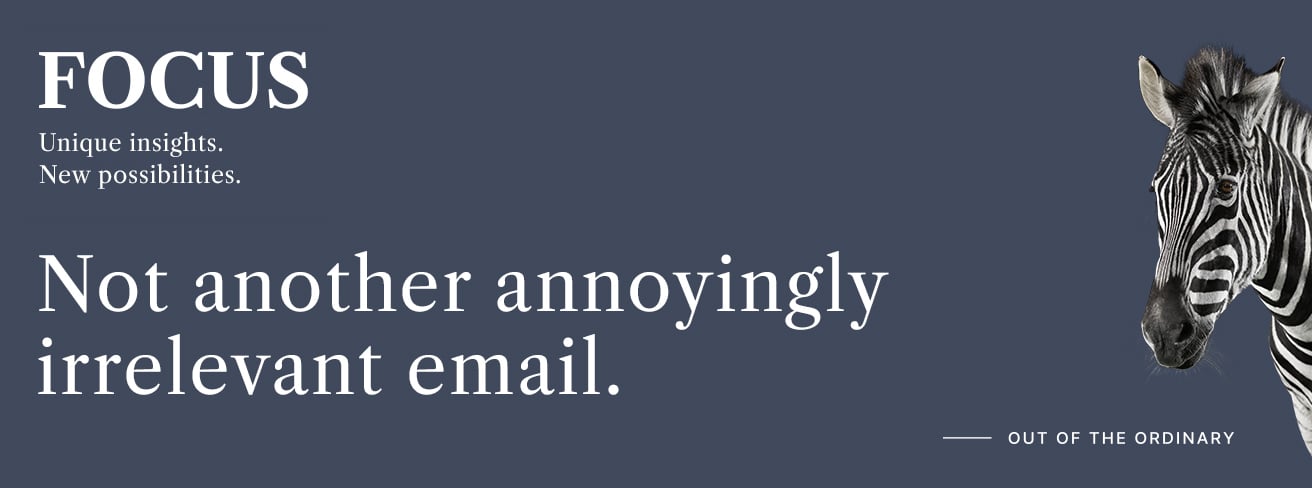
Sign up to the Focus newsletter for regular insights from Investec experts.

2023 was a hard year for the SA economy, and 2024 looks to see some improvement from the most likely 0.5% y/y economic growth outcome of last year, with the Q4.23 GDP due in March. 2024 is still set to see 1.0% y/y growth overall.
Globally, world trade is at risk from the disruptions to shipping through the Suez canal and drought in the Panama Canal, both of which carry substantial shipping traffic and the disruptions will cause longer transit times and higher costs.
The WTO (World Trade Organisation) is cutting its forecast for merchandise trade growth, both the likely outcome of 2023 due to the worsening disruptions in 2023, and for 2024, while tensions in the Middle-East have escalated.
However, global economic growth has seen some positive developments which, on balance caused recent global growth forecasts to be revised up, in spite of risks, and the IMF shows no dip in growth from 2023, with a 3,1% outcome expected from both.
Worries of a global and US recession have died off, while both the US and a number of emerging-market economies experienced economic strength, causing the upwards revision to the IMF’s 2023 global growth forecast as well as its 2024 forecast.
The IMF highlights that “(w)hat we’ve seen is a very resilient global economy in the second half of last year, and that’s going to carry over into 2024”, particularly from the large EM’s India, Russia and Brazil, upgrading Asia’s growth forecast overall.
Noting “Asia is set to grow at 4.5% in 2024, up from October’s projection of 4.2%, the IMF said in a REO update for Asia today. The continent remains on track to drive about two-thirds of global growth in 2024, as it did last year”.
The “upward revision of 0.3 percentage point for Asia’s growth rate is due to positive momentum carried forward from 2023, sizeable policy stimulus announced by countries such as China and Thailand, and robust external demand.”
For South Africa, improved global growth expectations support an acceleration in its own growth rate, but freight and energy supply constraints will persist over the year as well, if lessening somewhat, providing potential growth limitations.
PREVIOUS SA ECONOMIC OUTLOOK COMMENTARY:

Budget Preview: expected to maintain deteriorated projections of MTBPS
2 Feb 2024
The Budget on 21st February is expected to see very similar fiscal ratio projections to 2023’s MTBPS revisions, as the marked fiscal slippage highlighted in November last year becomes entrenched, and so fiscal consolidation remains delayed.

In November 2023’s MTBPS, gross debt was projected to peak at 77.7% of GDP in 2025/26, substantially higher than February 2023’s Budget estimate, of 73.6% of GDP for the same year.
Worryingly, gross debt was projected above 70.0% of GDP in 2031/32, and this reduces the sustainability of government finances, with a debt ratio of 60% of GDP instead seen as the maximum sustainable debt ratio for an EM economy.
For this fiscal year (2023/24), the 2023 February Budget projected gross debt at 72.2% of GDP, which was then pushed up to an estimate of 74.7% of GDP in 2023’s November MTBPS.
With the first three quarters of 2023/24 showing expenditure at 74.2% of budget, ahead of the 70.1% of the same period of 2022/23, and revenue at 71.5% of budget, under the 72.2% of the comparable period, a marked drop in the projected debt to GDP ratio for this year is unlikely.
The 2023/24 budget deficit was revised weaker, at -4.9% of GDP in the MTBPS versus -4.0% of GDP, further evidence of fiscal slippage, and the deteriorated budget deficit projections of later years won’t have improved substantially.
South Africa’s October MTBPS growth forecast for 2023 was overly strong, at 0.8% y/y, with the outcome most likely to be 0.5% y/y, which will add to the upwards pressure on the gross loan debt to GDP ratio, not detract from it.
For 2024, the MTBPS’s growth forecast is aligned to ours, at 1.0% y/y, but for 2025 the MTBPS’s 1.6% y/y is likely to prove too strong, given persistent load shedding, risking lifting the gross loan debt projection to GDP for 2025/26 too.
However, any lowering of nominal GDP estimates would increase the gross loan debt projections, worsening fiscal slippage. Credit rating downgrades are not expected after this month’s Budget, if it does see materially worse projections than the MTBPS.

MPC Update: SARB keeps rates unchanged at 8.25%
25 Jan 2024
The SARB’s monetary policy committee (MPC) kept the repo rate unchanged at 8.25% at its January meeting, in line with Investec’s projection.
The MPC's decision was unanimous, with all committee members choosing to keep rates on hold. The outcome is aligned with the Federal Reserve Bank’s last monetary policy decision in December 2023.
Globally, while inflation has decelerated, core inflation remains sticky. Supply side constraints, weighing on prices from heightened geopolitical tensions remains a key upside risk, while “advanced economies continue to experience strong wage growth”. Consequently, interest rates are likely to remain higher for longer and markets do not expect the Fed to alter rates at its next meeting (next week).
Joining CNBC Africa for a post-MPC panel analysis is Annabel Bishop, Chief Economist, Investec, Johann Els, Chief Economist, Old Mutual and Carmen Nel, Head of Multi-Asset Strategy, Terebinth Capital.
Domestically, the fuel price inflation forecast has been lowered somewhat and is now expected to average less than 1.0% this year (at the previous MPC meeting, 3.2% was projected). The food price inflation forecast has however been lifted modestly to 5.7% for the year, “but remains broadly unchanged over the forecast period”.
Core inflation averaged 4.9% last year and is projected to decelerate to 4.6% and 4.5% in 2024 and 2025 respectively. The 2024 forecast for services inflation remains unchanged at 4.8%, while core goods inflation is projected to ease notably from 6.1% in 2023 to 4.5% this year.
After reaching an average of 6.0% in 2023, the headline inflation number is expected to fall to 5.0% this year. Thereafter, the SARB projects the inflation reading to move towards the midpoint of the inflation targeting band (with 4.6% and 4.5% forecast for 2025 and 2026 respectively).
The SARB has however emphasised that risks to the inflation trajectory remain to the upside. Imported goods inflation “remains sensitive to currency weakness”. “The uncertainties of the global environment, and various South Africa-specific factors, including sluggish growth and dependence on commodity export prices continue to weigh on the value of the currency,” according to the SARB.
Food price inflation (while it has moderated somewhat) is still elevated at 8.5% (latest print) and is vulnerable to changes in global food commodity prices. Extreme weather conditions remain a considerable risk. Administered price inflation, notably electricity prices, presents an upside risk to inflation as the electricity supply predicament persists, while the country’s logistical challenges, especially the operation of SA’s ports and railways remains a key constraint. Moreover, “risk still attaches to the forecast for average salaries”, given the uncertainty attached to the direction of fuel and food prices.
On the global growth front, “advanced and emerging economies are likely to see modest economic growth this year, despite better than expected outcomes in 2023”, with the longer-term growth outlook highly uncertain given the geopolitical situation (and other factors). The Reserve Bank projects growth of 2.6% for this year.
Domestically, the economic environment remains subdued. Households remain constrained, while load shedding and logistical constraints continue to impede optimal economic activity, with marginal growth expected this year. The SARB’s GDP forecast for 2023 is slightly down at 0.6% (it was 0.8% at the previous meeting). The Reserve Bank’s growth expectations for 2024 and 2025 have remained unchanged at 1.2% and 1.3% respectively. The SARB gauges the risks to the medium-term domestic growth outlook to be balanced.
“At the current repurchase rate level, policy is restrictive, consistent with the inflation outlook and the need to address rising inflation expectations,” according to the SARB. “Future committee decisions will be data dependent and sensitive to the balance of risks to the outlook.”

Household finances: the declining trend in real incomes remains
17 Jan 2024
Average salary increases slowed in October, to 1.8% y/y from 4.1% y/y in September (nominal, actual terms), below the inflation rate.
In real (inflation adjusted) terms October saw a -3.4% y/y drop in real take home pay (BankservAfrica data).
The average real salary fell to R13 942 a month in October, from R14 226 (revised) in September, still on a declining trend from R16 124 in February 2021, weakening HCE (Household Consumption Expenditure) growth and so GDP growth.
CPI inflation rose in October, to 5.9% y/y, from 5.4% y/y in September and 4.8% y/y in August, cutting into real incomes (and so real expenditure) as nominal take home pay increases did not rise by the same amount.
That is, average salaries in nominal (actual terms) rose by only 4.1% y/y in September, below the 5.2% y/y inflation rate, and so dropped by -0.8% y/y in real terms in September, and fell by -3.4% y/y in October in real terms.
The BankservAfrica calculates average take-home pay “by dividing the total value of salaries paid into the bank accounts of (around 4 million) employees (excluding salaries greater than R100K per month) by the total number of salary payments”.
The Q4.23 BER Retail Survey shows that “durable goods and non-durable goods retailers in fact reported lower sales volumes compared to the previous festive season”, indicating consumer financial strain in a higher interest rate environment.
In December 2022, the prime lending rate was at 10.50%, while in December 2023 it had risen to 11.75%, a relentless upwards momentum from 7.25% in December 2021, and 7.0% in December 2020.
High inflationary pressures in SA have come from the supply side, mainly fuel and food costs, and South Africa’s CPI inflation rate has been uneven in its descent, but the trend is still one overall of falling inflation (i.e. disinflation).
Indeed, higher operating costs for businesses, including self-generation of electricity in the case of load shedding, have weighed on businesses. BankservAfrica Economic Transactions Index (BETI) showed a contraction of -2.3% q/q in Q4.23.
About the author

Annabel Bishop
Chief Economist of Investec Ltd
Annabel holds an MCom Cum Laude (Economics and econometrics) and has worked in the macroeconomic, risk, financial market and econometric fields, among others, for around 25 years. Working in the economic field at Investec, Annabel heads up a team, which focusses on the macroeconomic, financial market and global impact on the domestic environment. She authors a wide range of in-house and external articles published both abroad and in South Africa.

Macro-economic outlook: 2024 growth likely double that of 2023
3 January 2024
South Africa’s economic growth outlook for 2024, at 1.0% y/y, is stronger than 2023’s likely 0.5% y/y outcome
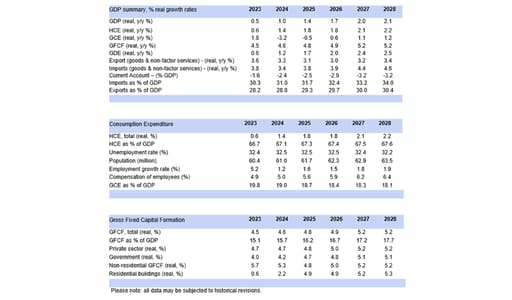
South Africa’s economic growth outlook for 2024, at 1.0% y/y, is stronger than 2023’s likely 0.5% y/y outcome, with 2024 expected to see the start of an interest rate cutting cycle, as well as lower inflation on average, and improvements to infrastructure.
Economic growth will be lifted by a reduction, to planned eventual elimination, of congestion at the ports, although electricity supply is not expected to fully, and consistently, meet demand this year, and higher stages of load shedding are likely.
That is, load shedding is likely to persist through 2024, at risk of worsening from stage 3/4 as insufficient capacity comes online, but 2025 should see more capacity from private sector generation, with further build-up over subsequent years.
Global economic growth is expected to provide some support to the SA economy, with the OECD highlighting the likelihood of only a mild slowdown in growth in 2024, to 2.7% y/y (versus 2.9% y/y in 2023) and so not a recession and lifting to 3.0% y/y in 2025.
For the US, the OECD forecasts growth at 1.5% y/y this year (after 2023’s likely outcome of 2.4% y/y), lower on the effects of prior monetary tightening but monetary policy is expected to begin easing in 2024. In 2025 the OECD sees growth lift to 1.7% y/y.
“In the euro area, which had been relatively hard hit by Russia’s war of aggression against Ukraine and the energy price shock, GDP growth is projected at 0.6% in 2023, before rising to 0.9% in 2024 and 1.5% in 2025.”
“China is expected to grow at a 5.2% rate this year, before growth drops to 4.7% in 2024 and 4.2% in 2025 on the back of ongoing stresses in the real estate sector and continued high household saving rates.”
Financial markets’ appetite for risk taking increased into the end of 2023, and the rand strengthened to R18.30/USD, with the JSE gaining close to 12% from early November, but both have since weakened somewhat on market jitters this year to date.
Domestically sentiment concerns also centre around the nature of the coalition government after the national elections, likely in Q2.24, which is also dulling business confidence, while uncertainties over the global environment persist, adding to volatility.

MTBPS: higher borrowing projections increases rating risk
1 Nov 2023
2023’s Medium–Term Budget Policy Statement has seen deterioration in the fiscal metrics (key of which are government’s debt to GDP and fiscal deficit projections).

Over the medium-term, gross debt is projected to now peak at 77.7% of GDP in 2025/26, versus February’s Budget estimate of 73.6% of GDP for the same year.
The current fiscal year (2023/24) has seen a substantial reduction in projected revenue collection as expected, by -R56.8bn lower, raising the budget deficit.
The 2023/24 budget deficit is now projected at -4.9% of GDP versus the -4.0% of GDP estimated for this fiscal year in February, while expenditure is cut by R85bn over two years (2024/25 and 2025/26).
The following three medium-term years of 2024/25 to 2026/27, see the budget deficit projected at -4.6% of GDP, -4.2% of GDP and -3.6% of GDP versus the February 2023 Budget estimates of -3.8 % of GDP and -3.2% of GDP for the first two. A significant degree of fiscal slippage is evident consequently.
Worryingly, gross debt is projected to still remain above 70.0% of GDP in 2031/32, and the expanding debt ratio has reduced the sustainability of government finances, with a debt ratio of 60% of GDP instead seen as the maximum sustainable debt ratio for an emerging market economy.
The budget is credit negative, with the risk of credit rating downgrades having risen for South Africa, and the three key rating agencies, Fitch, Moody’s and S&P to potentially give their country reviews this month.
The expenditure cuts have been favourably received by the markets, along with planned tax measures to raise revenue, as lower commodity prices and higher VAT refunds weakened revenue.
While personal income tax collections have seen resilience this year, National Treasury warns on the weak outlook for employment, while corporate taxes have already seen significant under collection this year, and this is anticipated to continue out to 2026/27.
Higher VAT refunds come as renewable energy infrastructure has been ramped up, along with spend to bolster capacity as the country’s freight transport system and fuel refining capacity weakened.
The next two years, 2024/25 and 2025/26 see revenue projections lowered by R152bn, and in contrast only R85bn is cut from expenditure, which has widened the budget deficit and debt projections as % of GDP.
The rand has strengthened in relief at the modest nature of the proposed tax measures, with the additional R15bn likely to come from no change to tax brackets to account for bracket creep (the effect of higher inflation on earnings), with the tax buoyancies estimated lower over the medium-term.
Higher civil servant renumeration is a key factor in preventing further expenditure cuts, and additional spend of R128.4bn partly counteracts the planned R213.3bn in cuts over the next two years.
On the expenditure cut front, this includes the R133.6bn cut from government departments, and unassigned provisional allocations. The higher spending of R128.4bn comes from R57.2bn in higher than budgeted for civil servant increases this year, and the R33.6bn due to the prior extension of the SRD grant.
The expenditure ceiling has dropped by R36.9bn, in 2024/25, and by a further R47.3bn in 2025/26, which has added to the efforts to contain the fallout from lower revenue collections and the rand has strengthened in response, reaching R18.55/USD in some relief straight after the MTBPS release.
However, the domestic currency has since retreated, near its close of R18.65/USD yesterday. Markets have shown some relief at the proposed areas of government restraint, although the credit rating agencies are likely to place SA back on negative outlooks, with risks for downgrades. The rand is also likely stronger today as the Fed is not expected to hike.
National Treasury sees quicker GDP growth from next year, in line with our view but points particularly to the weak economic outlook as having a key impact on the deteriorated fiscal projections of today’s MTBPS.
Higher bond yields, along with planned increased borrowings, have seen projected debt service costs rise by R51.5bn, along with the effects of rand depreciation.
Specifically, debt servicing costs are projected to reach a notable R385.9 billion in 2024/25, rising to R455.9 billion by 2026/27, further crowding out expenditure on vital areas of the economy.
National Treasury cautions that “(a)lthough many countries are contending with rising debt levels in the wake of the pandemic, over the past 15 years South Africa has had one of the largest increases in government debt as a share of GDP”.
As a mark of the fiscal weakness, the tax to GDP ratio is forecast to decline from 25.1% logged in 2022/23 to 24.7% in 2023/24. Indeed, a marked improvement in the ratio is linked to the sustainable lift in GDP growth.
Again, balancing the fiscal deterioration in some areas with efforts to still strive for eventual fiscal sustainability, the projections show a primary budget surplus is still achievable this year as planned revenue collections exceed planned expenditure, less the expected expenditure on borrowing repayments.
The budget is likely the best it could be in the current circumstances but is a poor budget from a fiscal consolidation point of view, with the debt ratios projected substantially higher than in February’s Budget Review.
National Treasury however notes a 1% rise in inflation and the same rise in interest rates, along with R1 depreciation in the ZAR/USD raise gross loan debt by R54.6bn and debt service costs by R8.2bn, stressing “successful fiscal consolidation will reduce the risks”.

Macro-economic outlook: SA's potential improves
29 Sep 2023
South Africa's forecasts are still held back by crime, logistics and power crises, but potential improves.
South Africa’s economic growth outlook has lifted marginally for this year, to 0.5% y/y from 0.2% y/y, as globally economies around the world tended to see stronger economic activity than was initially anticipated, although 0.5% y/y is still very weak.
Growth is generally proving to be below trend in OECD countries, while In SA severe crime hinders performance, as does insufficient electricity and freight capacity. The Global Organized Crime Index 2023 found SA “has a high criminality score”.
“South Africa boasts a number of pervasive criminal markets, heightened by the influence of criminal actors, especially state-embedded actors – responsible for years of state capture – and criminal networks that are highly interconnected.”
“South Africa also scores the highest in the Southern Africa region (on resilience), driven by the efforts of non-state actors to resist organized crime, robust national policies and laws, and strong economic regulatory capacity” – 2022 data.
The index measures levels of organized crime in a country and assesses their resilience to organised-criminal activity, with SA showing falling ability to combat the criminal activity it faces that contributes to smothering its economic growth rate.
The state consequently in 2023 enlisted the aid of the private sector in addressing the “key challenges of energy, logistics, and crime and corruption”, and the traction to date raises the potential for stronger growth in SA, but not actual forecasts yet.
Successful implementation of the many goals of the workstreams will be the only way to raise the economic growth forecasts, as economic growth depends on the actual availability of supportive factors such as a fully functioning transport network.
Next year growth of around 1.0% y/y instead of 0.5% y/y is forecast, lifting to 2.0% y/y in the medium-term. Underbidding on cost hamstrings the rollout of renewable energy and government needs to reduce stringent requirements, and rapidly improve the running of Transnet.
The temporary, mild elevation in CPI inflation to around 5.0% y/y until February 2024 does not necessitate higher interest rates in SA, but the MPC will likely follow the US interest rate decision, with domestic household consumption weak this year.
2024 is expected to see lower interest rates and inflation overall, both globally and domestically, with interest rate cuts in the US sparking EM currencies strength. The higher for longer stance of the US on its rate cycle has undermined these currencies.
Inflation globally is weakening, with disinflation also in core measures, and hawkish communication from Central Banks persist, aimed at curtailing inflation expectations and consumption led-inflation itself, to regain actual and implied inflation targets.
Domestically, demand led inflation is already very subdued, with indebted consumers evidencing the severe effects of the upwards interest rate cycle over close on two years now, as rates of default rise rapidly, especially for higher income earners.
The Reserve Bank’s interest rate increases are already having a highly suppressing effect on demand led inflation, with higher interest rates of typically less direct relevance to low income earners in SA who account for most non-durable goods consumption.
Indeed, the Eighty20 Credit Stress Report 2023 Q2 finds for South Africa that across most areas the defaults and overdue balances continued to escalate, and further interest rate hikes will cause even greater impact in an already high default environment.
With lower interest rates anticipated over 2024., and lower inflation rates on average, this should support nominal and real expenditure, and so economic growth, with household consumption expenditure (HCE) accounting for two thirds of GDP.
South Africa has also experienced declining fiscal revenue collection this year, and the OECD notes members’ “(g)overnments are faced with mounting fiscal pressures from rising debt burdens and additional spending on ageing populations, the climate transition and defence.”
“Enhanced near-term efforts to rebuild fiscal space and credible medium-term fiscal plans are needed to better align near-term macroeconomic policies and help ensure debt sustainability.”
South Africa faces a severe risk to its economic growth next year on higher taxation and failure to cut back on wasteful, needless and inefficient expenditure, as well as severely rooting out corruption, which leaches monies out the fiscal space.

MPC preview: SARB expected to keep rates on hold again
19 Sep 2023
South Africa’s Reserve Bank is expected to keep interest rates on hold this week, although the risk of a 25bp hike remains, particularly after the Fed lifted its rates by 25bp at its last meeting.
Lowering the difference between SA and US interest rates (narrowing the interest rate differential) weakens the rand, which in turn places upwards pressure on inflation. Foreigners have been net sellers of SA bonds most of this year, and particularly of SA equities.
The low economic growth environment, populist policies of government and insufficient provision of state services such as electricity and freight transport have negatively affected investors interest, particularly on equities.

South Africa’s interest rates have remained unchanged since May after a 50bp hike in that month, while the US hiked by 25bp in both May and July, but the US has seen more monetary policy meetings in its interest rate hike cycle than SA, raising its Bank rate by 5.25% in total, versus SA’s 4.75%.
While this would indicate room for a further interest rate hike, of up to 50bp, inflation in SA has dropped rapidly, while inflation is likely to average close to 4.5% y/y next year, indicating no need for a hike.
However, the risk is to the upside for inflation as drier conditions from the El Nino weather pattern could put pressure on food prices, although it is too early yet to determine the degree.
An interest rate hike would narrow the differential between US and SA interest rates, but heavily indebted consumers and the increased financial vulnerability of households mean higher interest rates are lowering economic growth.
Consequently, an interest rate lift this week could cause little to no lasting appreciation in the rand, and instead, could well cause rand weakness.
If no increase transpires, which is very widely seen as likely, markets will be heavily influenced by the Fed outcome tomorrow night, and the tone of the FOMC meeting, as well as that of the SARB.
Both Central Banks are however expected to evince hawkish tones as they seek to influence inflation expectations, and so consumer actions, by implying more interest rate hikes could be likely.

Inflation likely to fall further, but climate change poses risks
2 August 2023
This month should see CPI inflation fall further in South Africa, below 5.0% y/y as the general downward trend begun a year ago persists albeit with some stickiness in certain months. SA’s CPI has proved less sticky than the core measure.
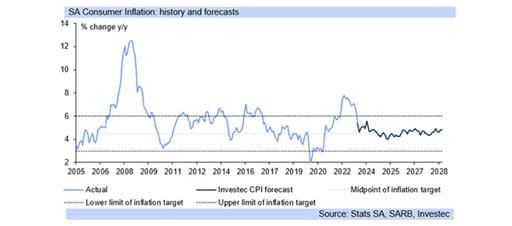
July 2022 saw CPI (headline or targeted) price inflation rise to the peak in the current inflation cycle of 7.8% y/y, creating a high base for this July’s CPI inflation rate to be calculated off, with inflation a year on year measurement for a basket of prices.
With the electricity tariff increase taking effect in July, 18.49% on the 1st of July 2023 for municipalities, this will contribute to the bulk of the rise in the headline inflation rate, while petrol prices remained essentially flat, falling by only 17c/litre last month.
Otherwise, July sees insurance costs surveyed for buildings and household contents, while food prices are also likely to contribute on the month, and indeed there are a number of areas likely contributing to the inflation rate outcome in July.
This results in the possibility of the inflation rate ranging between 4.5% y/y and 5.0% y/y, although food price inflation has seen some moderation this year, from 14.0% y/y in March to 11.0% y/y in June, with SA experiencing favourable weather conditions.
The El Nino period, of below average rainfall, is expected to see some pressure on agricultural production going forward, although SA has come from a lengthy LA Nina (above average) rainfall period, which has substantially bolstered soil moisture.
In combination with the effects of climate change, which have been very marked this year in the northern hemisphere summer, South Africa’s summer crop production does hold some uncertainty, and could see stickiness in food price inflation.
The high price inflation of 2022 (the highest for South Africa since 2009), created base effects that aided the subsequent descent, or disinflation (falling inflation), but these base effects will wear out from August, and particularly over Q4.23.
While CPI inflation is expected to average around 4.5% y/y in 2024, there are risks, particularly from food price inflation, with retailers seeing margin squeeze on the costs of load shedding, while climate change is escalating globally and locally.

July 2022 saw CPI (headline or targeted) price inflation rise to the peak in the current inflation cycle of 7.8% y/y, creating a high base for this July’s CPI inflation rate to be calculated off, with inflation a year on year measurement for a basket of prices.
With the electricity tariff increase taking effect in July, 18.49% on the 1st of July 2023 for municipalities, this will contribute to the bulk of the rise in the headline inflation rate, while petrol prices remained essentially flat, falling by only 17c/litre last month.
Otherwise, July sees insurance costs surveyed for buildings and household contents, while food prices are also likely to contribute on the month, and indeed there are a number of areas likely contributing to the inflation rate outcome in July.
This results in the possibility of the inflation rate ranging between 4.5% y/y and 5.0% y/y, although food price inflation has seen some moderation this year, from 14.0% y/y in March to 11.0% y/y in June, with SA experiencing favourable weather conditions.
The El Nino period, of below average rainfall, is expected to see some pressure on agricultural production going forward, although SA has come from a lengthy LA Nina (above average) rainfall period, which has substantially bolstered soil moisture.
In combination with the effects of climate change, which have been very marked this year in the northern hemisphere summer, South Africa’s summer crop production does hold some uncertainty, and could see stickiness in food price inflation.
The high price inflation of 2022 (the highest for South Africa since 2009), created base effects that aided the subsequent descent, or disinflation (falling inflation), but these base effects will wear out from August, and particularly over Q4.23.
While CPI inflation is expected to average around 4.5% y/y in 2024, there are risks, particularly from food price inflation, with retailers seeing margin squeeze on the costs of load shedding, while climate change is escalating globally and locally.

MPC preview: SARB expected to keep rates on hold
12 July 2023
The South Africa’s Reserve Bank is likely to keep interest rates on hold this month, after the Fed’s pause in its interest rate hike cycle

The South Africa’s Reserve Bank is likely to keep interest rates on hold this month, after the Fed’s pause in its interest rate hike cycle at the June FOMC meeting, with South Africa’s MPC decision due next week Thursday, 20th July.
The meeting takes place as SA has hiked interest rates by 4.75% in its current hiking cycle, while CPI inflation, which is due for release for June next week Wednesday is likely to show inflation falling back within the inflation target range.
June’s CPI inflation is likely to fall to around 5.5% y/y, significantly affected by base affects from rapidly rising inflation of a year ago, and these statistical base effects will also influence the July inflation outcome, seeing it likely drop towards 4.5% y/y.
With a three to four quarter lag between the impact of interest rates on the economy and inflation, the SARB also needs at least a pause in its interest rate hike cycle to assess the impact on both inflation and the economy.
Already, there is evidence of distress borrowing amongst households, whilst the financial vulnerability of consumers has increased while salary and wage increases are well below inflation in SA, the last in particular having a suppressing effect on consumer demand and so on demand led inflation.
From March next year CPI inflation should more permanently remain at, or very close to, 4.5% y/y. From this perspective further interest rate hikes in SA are not needed.
However, what will also be key is the movements in the US interest rate cycle, particularly given the effect this has on rand depreciation, and so the risks for the inflation outlook.
With the SARB not hiking in July, and the US potentially hiking by 25bp, although we think it is possible that the Fed may choose to extend its pause in its interest rate hike cycle over July as well, SA would still remain below the US in terms of the actual rise in interest rates it has delivered.
This would continue to undermine the rand, while US interest rate hikes add to market risk aversion and so weaken risk assets, including EM curries and so the domestic currency.
While we expect no hike in interest rates this month for SA, or for the rest of the year, marked rand weakness would change this view, and remains a key risk.

SA economy benefits from expansionary credit growth despite higher interest rate
30 June 2023
Macro-economic outlook: South Africa’s economic growth outlook remains weak, and we have not changed our forecast of the economy essentially stalling, at 0.2% y/y in 2023
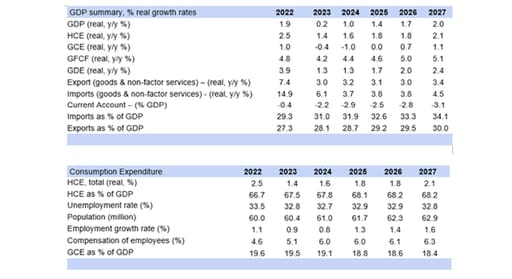
South Africa’s economic growth outlook remains weak, and we have not changed our forecast of the economy essentially stalling, at 0.2% y/y in 2023, with headwinds still coming from key productive factors and tighter monetary conditions.
Appetite for credit from households is substantial, and banks continue to lend at a more rapid pace than economic growth this year, which aided the modest growth outturn of 0.2% y/y, 0.4% qqsa (quarter on quarter, seasonally adjusted) in Q1.23.
The (revised) Q4.22 GDP qqsa contraction also gave a boost to the Q1.23 economic growth outcome. Household Consumption Expenditure (HCE which makes up two thirds of GDP) also recorded 0.4% qqsa in the first quarter of this year.
Indeed, household borrowings accelerated materially in the post-COVID-19 period (October 2021 to available data, i.e. April 2023), exceeding both the pre-COVID-19 trend (January 2016 to December 2019) and the COVID-19 period in between.
This has mitigated some of the tightening effect of monetary policy (the 4.75% increase in interest rates since end 2021) on GDP, with commercial banks “extending more credit in an environment of weakening economic growth” (SARB).
The expansion of loans and advances to households underpinned the expansion in HCE, which the SARB notes “thus far in 2023 reflected strong growth in loans to companies which outpaced the more moderate growth in loans to households”.
The growth rate in fixed investment (gross fixed capital formation) was a hefty 5.9% qqsa in H1.23 (although GFCF only accounts for 15% now of GDP, down from 21% in 2008), while government also increased its borrowings in Q1.23.
Growth in PSCE (Private Sector Credit Extension) at 7.0% q/q, markedly outpaced economic growth, in Q1.23, providing a stimulatory effect to the economy and somewhat lessening the stricture on financial conditions due to higher interest rates.
While there has been some mild slowdown in credit extension in Q2.23 to date, it is still well above the expected GDP qqsa outcome. For 2024 we continue to expect GDP growth of close to 1.0% y/y, as global growth and energy supply improves.

Rand Outlook: further rand strength expected over the medium-to longer-term
28 June 2023
The 50bp hike at the MPC meeting and drop in inflation to 6.3% y/y, has lifted South Africa’s interest rate/ CPI inflation differential by 1.0% y/y, adding support to the rand
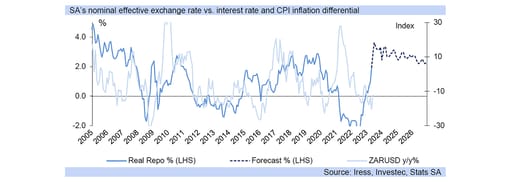
The 50bp hike at the May MPC meeting and drop in inflation to 6.3% y/y (from 6.8% y/y), has lifted South Africa’s interest rate/ CPI inflation differential by 1.0% y/y, adding support to the rand, and aiding it in pulling back from R20.00/USD, along with a number of other factors.
Key amongst these additional factors has been the greatly reduced stages of load shedding, and the improved balance SA is striking in geopolitics, with a number of key Western state officials received by government in South Africa in recent weeks, along with the President travelling to Europe as well.
The pause in the US interest rate hike cycle has been particularly significant for the rand, aiding its retreat towards R18.00/USD, dipping even to R17.85/USD momentarily in June. The domestic currency has remained volatile however, pulling back to R18.78/USD last week, and today reached R18.60/USD.
The rand is undervalued, and we expect it to return to R17.50/USD this year. Additionally, we expect June’s CPI inflation rate (published only in July) is likely to drop towards 5.5% y/y on severe base effects.
This return to the inflation target should provide an underpin to rand strength, although international events will remain dominant drivers, particularly the US interest rate cycle. SA’s monetary policy will also be key for the exchange rate.
The rand retains substantial weakness, with fair value closer to R15.00/USD - R14.50/USD. The interest rate differential between the Fed’s funds rate and SA’s repo rate has widened to 4.75%, with a narrow differential a key driver of rand weakness.
The rand moved substantially away from fair value as the US-SA interest rate differential narrowed from March last year, falling to 2.50%. US interest rates rose rapidly since March 2022, and SA did not keep up with the total size of the US hikes, nor their rapidity.
The rand retains substantial weakness, with fair value closer to R15.00/USD - R14.50/USD. Movements in the USD have also been instrumental in the domestic currency’s weakening trajectory, and US economic data and FOMC communications will remain key for the rand.
The implied Fed funds futures are pricing in one more 25bp hike in the fed funds rate this year and have mostly priced out the possibility of interest rate cuts in the latter part of this year.
These recalibrations contributed to some rand weakness over the past week, and the domestic currency is likely to remain volatile over this quarter and the next. The Fed has indicated current expectations of two more interest rate hikes.
However, this is not set in stone, and will be determined by the rapidity of disinflation (falling inflation), along with other economic variables likely to impact inflation, with lower US inflation figures (particularly core) than expected likely to aid rand strength this year.

CPI update: a good inflation print, further drops to come
21 June 2023
May’s CPI inflation rate dropped to 6.3% y/y (0.2% m/m), from 6.8% y/y in April.

The CPI inflation rate is likely to continue to subside over most of 2023, reaching the midpoint of the inflation target of 4.5% y/y in 2024, and then remaining around 4.5% y/y over the forecast period.
With the petrol price rising by only a relatively small 37c/litre it did not add much to price pressures, while June recorded a petrol price cut of 72c/litre, which will exert downwards pressure on that month’s inflation outcome. July is on course to see a small petrol price cut currently.
Food and alcoholic beverage prices did not contribute to the inflation outcome on the month, despite the weakness of the rand in May as the inflation figures are calculated from the 7th of the month back and so the substantial rand weakness against the US dollar over the full month of May is not included.
The inflation rate for food in May dropped to 12.0% y/y from 14.3% y/y in April, up 0.3% m/m, but benefiting from high base effects as food prices began a steep upwards ascent a year ago. Food (and non-alcoholic beverages) prices still contributed a third (2.1% y/y) of the overall CPI inflation rate.
Food price pressures are seeing some stabilisation in Q2.23 now as expected, which is aiding CPI inflation lower, and base effects will be key in pulling cost of living increases (the CPI inflation rate) down to below 5.0% y/y by year end for 2023.
The Reserve Bank is likely to be happy with the drop in the CPI inflation rate, but cautious as the core inflation rate ticked up to 5.4% y/y. We expect flat interest rates for the remainder of this year, and a cut only in 2024.
With the implied point in the SARB’s model of R18.68/USD, and a lower rand exchange rate now, gains in the US dollar will likely be positive for the SARB’s inflation forecast too, and so for its monetary policy decisions, with the SA reserve bank targeting CPI inflation, not the core measure.
We expect that CPI inflation will average near 6.0% y/y for this year, and if the rand does not see further, marked weakness, it could come out just below 6.0% y/y, at 5.7% y/y.
Looking forward, South Africa’s financial markets, as indicated by the FRA (Forward Rate Agreement) curve, have factored in one more 25bp hike in the current interest rate cycle, at year end, but we think this is currently unlikely and that SA has reached its terminal interest rate in the current cycle.
The FRA curve also indicated the likelihood of a 25bp cut in SA’s repo rate by the end of next year, if not only in 2025, but this is likely to occur earlier to prevent SA’s monetary policy from becoming restrictive as inflation falls towards 4.5% y/y.

SA business confidence dips further as economic conditions deteriorate
7 June 2023
The latest RMB/BER survey reveals an alarming drop in business confidence, with 73% of firms dissatisfied with the current business landscape. Domestic growth concerns are echoed by the IMF

The latest RMB/BER Business Confidence Index (BCI) has delivered yet another blow to the already gloomy business landscape. The index, which measures the sentiment of South African businesses, dropped from 36 in the first quarter of 2023 to a dismal 27 in the second quarter. This indicates that a staggering 73% of businesses are dissatisfied with the current state of affairs and the profitability of their operations.
Conducted between the 10th and 30th of May, the survey revealed that 83% of respondents in the manufacturing industry continue to be disappointed by trading conditions in the second quarter. Profitability has become a major concern for virtually all manufacturers surveyed, with negative implications for job creation and retention as well as the viability of the businesses themselves. These worrying signs suggest an increased risk of deindustrialisation. Employment figures have already taken a hit, dipping to a discouraging -12, which indicates a likely reduction in jobs.
The retail, wholesale, and vehicle sales sectors have also suffered sharp declines in business conditions, experiencing drops of -14, -8, and -21 points, respectively. Meanwhile, building confidence has remained stagnant in a depressed state.
In a separate development, the International Monetary Fund (IMF) has released its annual Article IV consultation report on South Africa, in which it projects a meagre 0.1% real GDP growth for 2023. The report attributes this sluggish growth to a significant increase in power outages, weaker commodity prices, and an unfavourable external environment. Looking ahead, the IMF expects the country's annual growth to hover around 1.5% in the medium term. However, it cautions that this rate is insufficient to generate enough jobs for new entrants to the labour market. The persistence of long-standing structural impediments, including rigid product and labour markets, as well as constraints on human capital, offset the expected improvements in energy supply, private spending on energy-related infrastructure, and the external environment.
To address these challenges, the IMF recommends a series of reforms. First and foremost, it suggests easing the burdensome regulatory framework for corporations and creating a level playing field. Additionally, it calls for decisive action to combat corruption and strengthen governance, particularly in the network industries where inefficient state-owned enterprises (SOEs) dominate. The IMF also emphasises the need for labour market reforms to enhance flexibility and promote job creation.
Against this grim economic backdrop, it is likely that the South African Reserve Bank (SARB) has reached the end of its interest rate hike cycle. The weak state of the economy simply cannot withstand further rate increases this year. Furthermore, consumer price inflation (CPI) is expected to drop significantly in the coming months, bringing it back within the 3-6% year-on-year target range as early as this month. The most recent CPI reading for April stood at 6.8% year-on-year, but it is anticipated to decline to 5.0% year-on-year next month.
Given the circumstances, the next move from the SARB is anticipated to be an interest rate cut. It is expected that a 50 basis point reduction will be implemented at the beginning of 2024. However, if economic growth deteriorates at a faster rate or inflation falls more rapidly than anticipated, the rate cut may be brought forward.

SA bond yields deteriorate sharply on fiscal risks and geopolitical concerns
2 June 2023
SA faces mounting financial risks as bond yields rise and foreign capital inflows decline. The Reserve Bank has warned of possible financial instability, urging urgent action to restore confidence and safeguard the nation's economy.
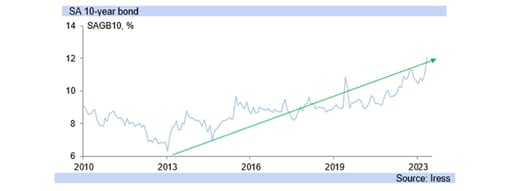
Yields on South Africa’s benchmark ten-year government bonds have risen by more than 2% since the beginning of this year, reflecting an accelerated decline in investor confidence in the country. The Reserve Bank (SARB) has raised a red flag, warning about growing risks to financial stability, citing "capital outflows and declining market depth and liquidity," and highlighting that foreign participation in South African government bonds has dropped from 42% to 25% in the past five years.
Headline fiscal risks stem from factors such as above-inflation wage settlements, weakening domestic economic growth prospects, reduced revenues due to lower commodity prices and export volumes, as well as contingent liabilities associated with implicit and explicit guarantees for state-owned enterprises (SOEs).
The situation has been further compounded by idiosyncratic risk factors such as frequent power outages and the country’s recent greylisting by the FATF (Financial Action Task Force). The country's high levels of electricity load shedding have devastated economic growth projections for the current year. This, in turn, has dampened the country's fiscal revenue collection outlook.
This combination of factors explains the lacklustre demand for new bond issuances from non-resident investors. Foreign investors have already sold off approximately -R20.3 billion worth of their South African bond holdings this year, following a net sale of -R19.6 billion in 2022. In contrast, in 2021, foreigners only sold -R0.1 billion worth of South African bonds (net of purchases) after purchasing R76.7 billion in 2019.
The SARB also highlights another concerning factor: South Africa's non-aligned stance in the war between Russia and Ukraine. Perceptions that the country is siding with Russia could potentially pose a future threat to the participation of South African financial institutions in the global financial system. It also increases the likelihood of secondary sanctions being imposed on South Africa.
The deterioration in South Africa's bond yields, along with the warning signals from the Reserve Bank, has called into question the country's financial stability. These developments should serve as a wake-up call for policymakers and market participants alike to address the underlying issues and restore confidence in the country's economic prospects.

MPC preview: rand weak on insufficient rate hikes
9 May 2023
Recent commentary from the Reserve Bank on higher inflation and rand depreciation shows these are front of mind for the SARB

Recent commentary from the Reserve Bank on higher inflation and rand depreciation shows these are front of mind for the SARB, which is widely expected to hike the repo rate again this month on 25th.
Governor, Lesetja Kganyago highlights the feed through effect of rand weakness into higher inflation in SA, in particular noting “as the dollar has strengthened, the inflationary impact of currency depreciation has resurfaced”.
Adding, “this limits the benefits of slowing global inflation to domestic inflation the SARB has revised its inflation projections upwards – headline inflation is now forecast to decelerate at a slower rate, averaging 6.0% in 2023 (5.4% previously)”.
Foreigners have sold -R11.4bn (net of purchases) of SA bonds for this year to date, undermining the domestic currency. SA’s ‘real return’ on interest rates is low, and not attractive to investors comparatively, adding to rand weakness.
The Reserve Bank Governor warns “higher fuel and food price inflation are a direct consequence of a more depreciated exchange rate. Domestic food price inflation continues to rise despite normalising global agricultural commodity prices.
“If the expectations that firms and households hold for future inflation stray from the inflation target, then higher nominal wages and consumer prices are likely to emerge.” “This implies that we need to continue the normalisation of interest rates".
“As inflation rises, and growth slows, a central bank that fails to respond to rising prices will face the prospect of compounding inflationary shocks. Currencies depreciate and investment falls.”
The SARB could surprise again with another 50bp hike on 25th May, but this would still leave SA’s interest rate hikes (4.75% if it hikes this month by 50bp) below that of the US which has hiked by a full 5.00% in the current rate hike cycle.
The May MPC meeting may be the last one the SARB could deliver a larger (50bp) hike at, with SA GDP statistics also due out in early June, and likely to show Q1.23 contracted on the harsh load shedding regime, and other deteriorating factors of production.

President reaffirms state power and freight plans at SA Investment Conference
14 April 2023
Despite exceeding its five-year investment goal, the conference took place against the backdrop of an SA economy contracting in response to dwindling electricity and transport supply.

With the completion of its fifth round last week, the South African Investment Conference (SAIC) has exceeded its objective of attracting R1.2 trillion in private sector fixed investment in South Africa, with investment commitments reaching a reported R1.51 trillion for the five-year period. Last week’s conference took place amidst a severe backdrop of insufficient electricity supply from Eskom and inadequate freight services from Transnet to meet the demands of the economy, resulting in a contraction in GDP in Q4.22, and expectations of another contraction in Q1.23.
The President of South Africa acknowledged the state's constrained energy supply that has resulted in persistent load shedding, stating that "government, through the Energy Action Plan has announced several interventions to turn around the situation." The state has been implementing wide-ranging reforms in the electricity sector to enable private investment in electricity generation and accelerate the procurement of new generation capacity from solar, wind, gas, and battery storage.
The removal of the licensing threshold for embedded generation, with measures to streamline regulatory processes, has enabled a surge of new projects, with the pipeline of committed projects now representing over 10,000 MW of new capacity. The President highlighted that "what we are witnessing in the energy sector is an undeniable surge of investment that will not only address the electricity supply shortfall in years to come but will propel growth and create jobs."
On the freight deficit, Ramaphosa added that "Transnet’s railway and port constraints are significantly affecting the mining, agriculture, forestry, automotive, and manufacturing sectors." The private sector Resource Mobilisation Fund is providing support for the Energy Action Plan, and indications from businesses show that they are prepared to support the government in fixing the logistics system. The president stressed that the government is prioritising port and rail efficiencies as part of the structural reform process. The new National Rail Policy provides for third-party access to the freight rail network, which will allow private rail operators onto the network to increase investment and improve efficiency.
Furthermore, Transnet is in the process of establishing private-sector partnerships at the Durban and Ngqura Container Terminals, expected to be concluded in the coming weeks. The President also mentioned that government has agreed with key stakeholders to establish a National Logistics Crisis Committee to drive the implementation of a comprehensive roadmap for the freight logistics sector. The President expressed confidence that, working together with the private sector and organised labour, Transnet and government will be able to overcome these constraints to improve efficiencies.
Despite the positive tone at the conference, however, it’s clear that will take several years to sort out the deficiencies, incapacities, and deficits in Transnet’s rail and port services, adding to low business confidence and weakening the investment impetus. The private sector is already taking on, or planning, self-generation where possible, with several municipalities making use of regulatory changes to procure power independently of Eskom.
The Cabinet has approved the Electricity Regulation Amendment Bill, which will soon be tabled in Parliament, to establish a competitive market for electricity generation. The National Transmission Company is expected to be fully operational shortly. Through the renewable energy programme, it has signed agreements for approximately 2,800 MW from bid windows 5 and 6, with several large projects already in construction and others on track to reach financial close. The government recently released a request for proposals for over 500 MW of battery storage and will soon open further bid windows for wind and solar, battery storage and gas power.
The President confirmed that the government is working to close the electricity supply shortfall and end load shedding in the short term while laying the foundation for fundamental reform of the energy sector in the longer term: “Even as we work to improve the performance of our existing coal-fired power stations to address load shedding, we remain committed to a just energy transition and our target of achieving net zero emissions by 2050. We will implement our Just Energy Transition Investment Plan, which outlines our investment needs to support a just and inclusive transition towards cleaner forms of energy. We will soon be completing the review of the Integrated Resource Plan to lay the foundation for a fundamentally transformed energy landscape that transitions us along a low-carbon, climate resilient developmental path.”
On the country’s recent “greylisting” by the Financial Action Task Force, the President noted that “the South African Police Service, the Special Investigating Unit and the NPA’s Investigating Directorate are making notable progress in dealing with cases of serious corruption. This work has resulted in arrests, asset forfeitures, successful convictions and the recovery of misappropriated funds. Since its inception, the work of the Fusion Centre has led to the preservation and recovery of approximately R1.75 billion in criminal assets. These developments highlight the importance of South Africa’s efforts to be removed from the Financial Action Task Force’s ‘grey list’ as soon as possible."
“Yesterday,” he continued, “I met with business leaders from some of South Africa’s leading companies to discuss the challenges that are holding up growth in our economy. We agreed to undertake practical joint action in three immediate priority areas: energy, logistics, and crime and corruption. In doing so, we will be building on the collaborative model that we used so successfully in managing our response to Covid-19 and in our vaccine rollout. We are confident that if we can address these three issues, we will be able to turn our economy around and unleash its full potential.”
While the President did seem more task-orientated towards the multiple crises facing the country, this would not be the first time that he has acknowledged that the parlous state of security of electricity and freight services is harming economic growth and job creation. Until there is significant evidence of progress in these two crucial areas, business confidence will continue to decline, along with levels of fixed investment.

Macro-economic outlook: electricity crisis dims growth
24 March 2023
South Africa’s economic growth outlook has tipped lower on the weakening in GDP in Q4.22 which creates a low base for 2023 to roll off on, and on the deepening energy crisis. Combined this is expected to limit 2023’s GDP growth to 0.2% y/y.
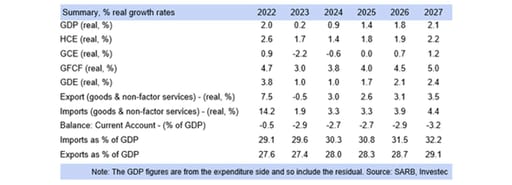
Q1.23 is likely to see economic activity contract further, by -0.5% qqsa (quarter on quarter, seasonally adjusted) from Q4.22’s -1.3% qqsa, which will yield a recession on a technical basis as loadshedding cuts into productive capacity.
Electricity supply is failing to consistently meet demand, giving rise to severe bouts of load shedding, with 2023’s Energy Availability Factor (EAF) at 52.8% of the potential output of installed capacity available, on deteriorated production ability.
Last year the country’s EAF was higher, at 58%, although lower than forecast in Eskom’s October 2022 Medium Term System Adequacy Outlook (MTSAO), which “expects a downward trend in plant performance to continue in the medium term”.
This is seen to be “fueled by increasing unplanned full and partial load losses”, while “Eskom’s generation fleet is expected to reduce by 5 288 MW between 2023 and 2027 because of plants reaching their turbine dead-stop dates (DSD).”
Loadshedding has added to input costs for production in SA, with self-generation more expensive, while production losses (and wastage particularly for food) increase, with food the highest weighted item and biggest driver of inflation.
March is likely to see the MPC deliver a 25bp hike, following the FOMC’s move of the same magnitude this week. The rand gained somewhat from the Fed’s less hawkish tone but is still trading above R18.00/USD, reaching R18.23/USD today.
The domestic currency is likely to remain volatile, with the Fed leaving the door open for further rate increases. The dot plot of members’ expectations shows one further 25bp lift, but markets are less certain, factoring in cuts this year.
South Africa’s energy crisis is having a severely suppressing effect on growth and job creation, and shows little immediate likelihood of being resolved, reducing business and consumer confidence, and further weakening the growth outlook.

Economic growth: insufficient fixed investment stymieing growth outlook
7 March 2023
Fitch has recently highlighted that “private infrastructure investment risks in South Africa include physical security challenges, particularly “organised crime groups in construction and infrastructure” which “reduces investment attractiveness”.
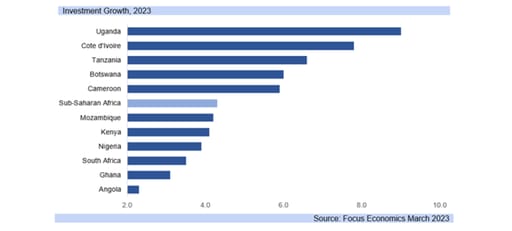
Fitch further highlights “Implications for firms in the sector include the potential loss of income through disruptions, delays and forceful cooperation as well as elevated expenditure on private security to protect projects”.
“Against this backdrop, despite frequent reports of intimidation and violent attacks affecting construction projects, the capability of state security forces to guard against these risks is limited, largely due to corruption risks and underfunding” (Fitch).
Fitch is one of the three key global credit rating agencies, and its Solutions arm further warns “Eskom’s rolling blackouts remain the main strategic threat to … economic performance impacting all sectors, including construction.”
“In the absence of a sound recovery plan to stabilise the market's power supply, infrastructure investments (such as .. new railways, roads and ports, and energy-intensive upgrades) risk losing their viability, increaseing cost overruns “.
The rand weakened today after last night’s cabinet reshuffle, to R18.39/USD, R22.06/GBP and R19.61/EUR with some further strength from the USD too as the risk averse global financial market persists.
International investors are aware of the security challenges in SA, with Fitch Solutions further highlighting “that developers and employees are threatened with demands including requests for a percentage of the construction contract”.
“Key risk areas for firms operating in South Africa's construction and infrastructure sector are intimidation and project disruption by active criminal groups (also locally known as the ‘construction mafia' or ‘local business forums’).”
The disincentivising effect on investment reduces economic growth and job creation. Fitch adds “an understaffed, underfunded and perceptibly corrupt police force is a fundamental aspect in the continued operation of organised criminal groups.”

Greylisting note: it's not the end of the world
24 February 2023
SA’s greylisting by the Financial Action Task Force (FATF) highlights the country's shortcomings in preventing money laundering, terrorist financing, and proliferation financing. But addressing these urgent issues quickly could help solve some of the systemic problems hobbling economic growth.
The anticipation of greylisting has been building for some time, and following FATF's announcement today the currency reached R18.49/USD from its open of R18.24/USD, with the event largely factored in. The news will also not necessarily result in any adverse moves by the rating agencies, which have worked this into their calculations, noting in prior reports that SA was likely to be greylisted, and that, on a standalone basis, the greylisting does not add to the likelihood of a downgrade.
Apart from the greylisting being priced in, the negative impact on markets and the currency was also likely somewhat offset by a well-received national budget announcement earlier in the week. In his annual statement, South Africa's finance minister outlined plans for relieving Eskom's debt, with very sensible conditions designed to ensure that the utility cleans up the rampant corruption and mismanagement that has hobbled it for the past decade or more -- a prerequisite to the sustainable resolution of the electricity crisis. More broadly, the budget demonstrated that fiscal consolidation remains on track and is even running ahead of schedule on some ratios. Eskom’s debt, along with other SOE debt government guarantees, was already included under the state debt and so the bail-out is credit neutral.
But if the greylisting is not expected to dent SA's growth directly, it will have some indirect consequences, possibly including reduced portfolio flows, as well as deterring foreign direct investment (FDI). SA’s FDI is already exceptionally low, with foreigners selling SA portfolio assets in anticipation of today's news over the course of the past twelve months.
The key question now is whether and how quickly SA is able to get off the FATF grey list. This is where the credit rating agencies and others have expressed concern.
It should be noted that the purpose of greylisting is not to punish or damage a country. Inclusion on the list of "Jurisdictions under increased monitoring", as the list is officially termed, is not intended to make the economic environment more difficult, prevent flows of monies in and out of borders, or bring impediments to legal businesses. It is rather intended to raise the standard of compliance in a country. It's worth noting that, in South Africa's case, both the banking sector and the relevant legislation by and large already meet the FATF requirements. Many South African banks are indeed well placed to help clients with what will amount to likely extra paperwork and some delays due to additional due diligence requirements.
More persistent problems include SA's poor track record of successful prosecutions for crimes including money laundering and terrorist financing, along with a systemic failure to provide assistance to international investigations into financial crimes.
National Treasury notes that “following engagements with FATF, it assessed that the country needed to make further and sustained progress in addressing the eight areas of strategic deficiencies related to the effective implementation of South Africa’s Anti-Money Laundering/Combating the Financing of Terrorism (AML/CFT) laws as set out in the FATF’s statement.”
The action items in question are as follows:
(1) demonstrate a sustained increase in outbound Mutual Legal Assistance requests that help facilitate money laundering/terrorism financing (ML/TF) investigations and confiscations of different types of assets in line with its risk profile;
(2) improve risk-based supervision of Designated Non-Financial Businesses and Professions (DNFBPs) and demonstrate that all AML/CFT supervisors apply effective, proportionate, and effective sanctions for noncompliance;
(3) ensure that competent authorities have timely access to accurate and up-to-date Beneficial Ownership (BO) information on legal persons and arrangements and applying sanctions for breaches of violation by legal persons to BO obligations;
(4) demonstrate a sustained increase in law enforcement agencies’ requests for financial intelligence from the Financial Intelligence Centre for its ML/TF investigations;
(5) demonstrate a sustained increase in investigations and prosecutions of serious and complex money laundering and the full range of TF activities in line with its risk profile;
(6) enhance its identification, seizure and confiscation of proceeds and instrumentalities of a wider range of predicate crimes, in line with its risk profile;
(7) update its TF Risk Assessment to inform the implementation of a comprehensive national counter financing of terrorism strategy; and
(8) ensure the effective implementation of targeted financial sanctions and demonstrating an effective mechanism to identify individuals and entities that meet the criteria for domestic designation.
According to the statement by National Treasury, "Minister of Finance, Mr Enoch Godongwana informed the FATF President, Mr Raja Kumar, that the South African Cabinet has considered the Action Plan and committed to actively work with the FATF and The Eastern and Southern Africa Anti-Money Laundering Group (ESAAMLG) to swiftly and effectively address all outstanding deficiencies and strengthen the effectiveness of its AML/CFT regime.”
Treasury's statement goes on to point out some of the steps that have already been taken to address FATF's concerns, including the speedy enactment of two major pieces of legislation, which in turn amended six Acts of Parliament: the General Laws (Anti-Money Laundering and the Combating the Financing of Terrorism) Amendment Act and the Protection of Constitutional Democracy Against Terrorism and Related Activities Amendment Act. These two key p[ieces of legislation should go a long way toward solving the technical deficiencies identified in FATF's Mutual Evaluation Report (MER).
The government seemingly recognises that addressing the action items will be in the interest of South Africa and that doing so is consistent with our existing commitment to rebuild the institutions that were weakened during the period of state capture -- institutions that are essential to addressing crime and corruption.
The action items as formulated in the Action Plan, therefore, form part of the broader commitment of the Government to combat financial crime and corruption, as announced by President Ramaphosa in October last year in response to the findings and recommendations of the Zondo Commission on state capture.
The need to address the action items is also consistent with the national strategy on AML/CFT which was adopted by Cabinet in November 2022, which stressed the urgent need to strengthen the fight against financial crimes in the country and assist in preserving the integrity of the country’s financial system.
National Treasury also notes that the increased monitoring will have a limited impact on financial stability and costs of doing business with South Africa. There are no items on the action plan that relate directly to the preventive measures in respect of the financial sector, which reflects the significant progress in the application of a risk-based approach to the supervision of banks and insurers.
The statement concludes with an assurance that "the costs of increased monitoring will be substantially lower than the long-term costs of allowing South Africa’s economy to be contaminated by the flows of proceeds of crime and corruption.”
South Africa’s Reserve Bank (SARB) has also reaffirmed its commitment to the fight against money laundering, the financing of terrorism, and proliferation financing. "The SARB and the South African government more broadly, maintain a close and open relationship with the FATF," said SARB in its official response to the greylisting announcement. "Since the FATF Mutual Evaluation of South Africa in October 2021, our coordinated government stakeholders have undertaken substantial and far-reaching efforts, led by the National Treasury, to enhance our anti-money laundering, counter financing of terrorism, and counter proliferation financing (AML/CFT/CPF) regime and its implementation.
"South Africa’s hard work resulted in most of the identified deficiencies being addressed within the 12-month observation period afforded to South Africa. South Africa’s 2021 MER highlighted several recommended actions linked to supervision and preventive measures applicable to financial institutions and designated non-financial businesses and professions.
"As a result of strategic efforts and numerous initiatives undertaken by the SARB, all pertinent action items received extensive attention. The Prudential Authority as well as the Financial Surveillance and National Payment System departments of the SARB are responsible for overall AML/CFT/CPF supervision across all banks, life insurers, mutual banks, cooperative banks, authorised dealers with limited authority, and clearing system participants.
"The FATF has acknowledged that the Prudential Authority has made the most progress in terms of the application of a risk-based approach to supervision. Some of the work undertaken included the issuance of sector-specific guidance, conducting a second round of sectoral risk assessments, instituting a new risk rating tool, enhancing the frequency of inspections, holding regular outreach and awareness sessions with banks and life insurers, as well as seeking to engage foreign supervisors in host jurisdictions concerning cross-border subsidiaries and their respective money laundering and terrorist financing (ML/TF) risks. Going forward, the SARB will further strengthen its supervision and further enhance the dissuasiveness and proportionality of administrative sanctions issued.
"The SARB has a zero-tolerance approach when addressing the abuse of the financial system by money launderers or terrorist financiers. The SARB, just as the South African government, commits to further intensify its efforts to combat all manners of financial crime and ensure the full compliance with global AML/CFT/CPF standards. The SARB echoes the sentiment of the FATF, which has stated unequivocally that it “does not call for the application of enhanced due diligence measures to be applied to these jurisdictions. The FATF Standards do not envisage de-risking or cutting off entire classes of customers, but call for the application of a risk-based approach.”
For South Africa, the greylisting is not the end of the world. But it comes at an unfortunate time, against the backdrop of a risk-averse global financial market environment, which has added to jitters on the back of the resignation of Andre de Ruyter from Eskom this week, and his public allegations of endemic fraud and corruption in the energy sector. It also represents more bad news heaped onto the worsening energy crisis and other critical failings in areas such as transport and water which are essential to a functioning economy. But the hope is that a concerted effort to cooperate with FATF in addressing failings in monitoring and controls, and getting off the grey list as quickly as possible, will be a positive step towards resolving the systemic problems that have for too long beset South Africa's economy and its people.

Budget Update: a better than expected budget
22 February 2023
A better than expected budget, Eskom debt relief and some fiscal consolidation

2023’s Budget Review saw a weakening in government’s debt to GDP projections and fiscal deficits (with close to three quarters of debt relief for Eskom on the R350bn the state guarantees).
Gross debt of government is consequently now projected to stabilise at 73.6% of GDP in 2025/26. Previously the projection was estimated to peak at 71.1% in 2022/23 in October’s MTBPS.
The key credit rating agencies (Fitch, Moody’s and S&P) already rate SA’s debt as including all Eskom and other SOE debt which government holds guarantees over, and so the impact should be credit neutral.
Some improvements in fiscal projections did occur, with the budget deficit for 2022/23 lowered to -4.2% of GDP, dropping from the prior estimate of -4.9 % of GDP, and still expected to reach -3.2% by 2024/25.
The downwards revision of National Treasury’s economic growth forecast for 2023 to 0.9% y/y from 1.4% y/y is in line with the consensus once a couple of outliers are removed. 2024 sees a slight drop to 1.5% y/y from 1.7% y/y.
This has only a mild effect on the fiscal ratios while the overall improvement is that a primary surplus occurred earlier, in the current fiscal year, instead of in 2024/25 and “consolidated debt narrows at a faster pace”.
Fitch did say prior to the Budget SA’s “low growth potential … at 1.2%, remains a key credit weakness … a further weakening of trend growth … or a … shock that further undermines fiscal consolidation efforts … could result in negative rating action.”
“There is some headroom at the sovereign’s rating of ‘BB-’ to absorb a temporary impact on economic metrics from load-shedding, but a failure to address the problem over the medium term could add to downward pressure on the rating”.
Today’s Budget is credit neutral to slightly positive on the improvement in the primary balance, projected quicker debt consolidation, with the negative impact on the debt ratios mainly coming from Eskom’s debt relief. The rand was at R18.28/USD before the Budget, reaching R18.20/USD in some relief.
For ongoing coverage of Budget 2023, please visit our Budget 2023 Series.

SONA: sober assessment, markets uninspired
10 February 2023
SONA: sober assessment of SA’s persistent challenges, market reaction muted to negative

2023’s State of the Nation Address (SONA) was sober, highlighting the ongoing problems South Africa faces, and the hope that the country overcomes them, with the country seeking a workable set of detailed plans for the multiple crises it faces.
The President outlined a plan the energy crisis, operating under the parameters of a national state of disaster which is more likely to be successful than previous interventions for the electricity sector, as SA tends to be weak on implementation.
Eliminating red tape and reducing the regulatory burden to sustainably end load shedding is key, as is oversight to prevent corruption, using the best expertise and skills. Prioritising the energy crisis to a national state of disaster is necessary.
However, key also will be the level of technical skills and experience deployed, with both the transmission and production capacity of electricity currently too weak to cope with requirements.
The SONA noted interventions focused on climate change, poverty, unemployment, the water crisis, along with insufficient rail and port capacity, as well as support for SMME growth, improving skills/education and continuing the SDR.
Many of the same topics of previous years were repeated in the SONA, stretching back further than 2016. The SONA’s was comprehensive and positive in its messaging but did not inspire markets, who take a wait and see approach to delivery.
That is, South Africa’s slow, and often poor, implementation of its goals (promises) has been the key determinate of its weak economic growth rate, and hence of exacerbating unemployment.
The state has numerous plans, insufficient delivery and a poor track record overall, making the state of disaster seemingly necessary for resolution of the electricity crisis.
But after over a decade of costly expenditure on electricity and a poor-quality result, markets fear additional cost and debt for the state and a deterioration of state finances, negatively impacting SA’s bond market and so weakening the rand.
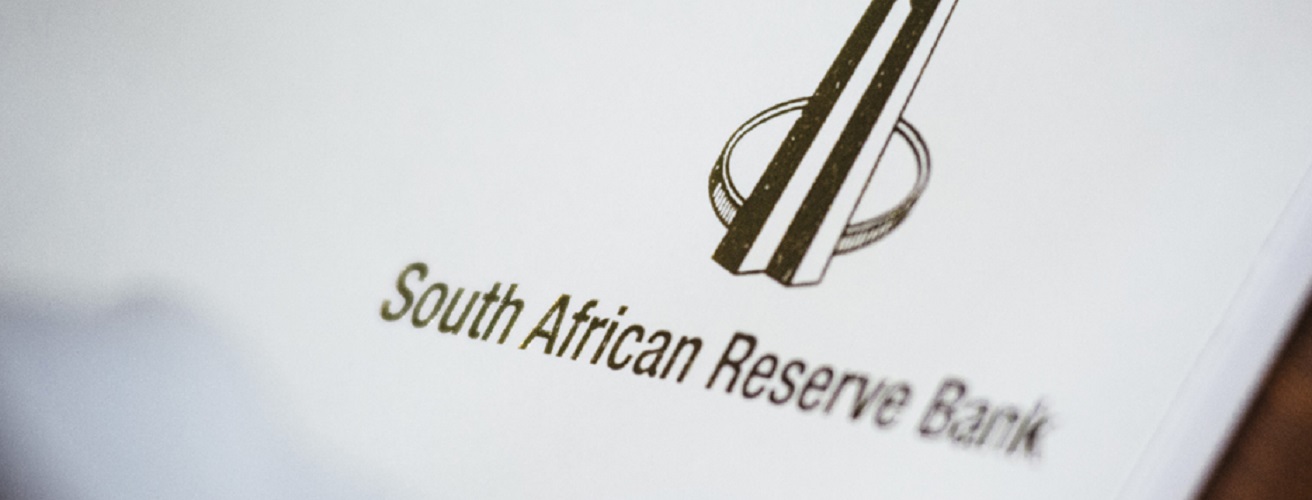
MPC preview: SARB to hike again, likely by 50bp
13 January 2023
South Africa’s Monetary Policy Committee (MPC) will see its next interest rate decision on 26th January, while the FOMC’s next rate decision will be announced on 1st February.

This comes after the FOMC dropped its interest rate increase in December, from 75bp to 50bp, with SA potentially doing the same this month. Market expectations for the next expected US rate hike have now dropped to close to 25bp.
Yesterday showed US core CPI inflation drop to 5.7% y/y in December, from 6.0% y/y. This measure, CPI excluding food and energy, is still well above 2.0% y/y however and does not signal an end to US interest rate hikes, nor definitely a drop to hiking in 25bp increments.
In South Africa, CPI inflation is expected to fall to 7.2% y/y in December’s publication due out next week Wednesday, dropping from 7.4% y/y, while core inflation could drop to 4.7% y/y from 5.0% y/y.
With SA’s CPI inflation still well above the target, and risks to the outlook, the SARB is likely to hike the repo rate again this month, but by 50bp. Inflation is proving slow to subside in SA, but this should accelerate in H1.23 on base effects.
Looking forward, SA will see upwards pressure coming from the larger than expected 18.65% increase in electricity prices announced late yesterday by NERSA, with Stats SA typically capturing the annual electricity price increase for CPI inflation in July.
Absent a very sharp rise in fuel prices in the month, or another shock, the CPI inflation outcome for the month of July 2023 could actually drop to 4.3% y/y, from 4.9% y/y in June, as base effects from H1.22’s high fuel and food price increase will still have an effect.
However, H2.23, if not the middle of 2023 already, risks seeing higher fuel prices on a reopening of the Chinese economy, while a significantly milder slowdown in economic activity than anticipated this year would also place additional pressure on prices.
The higher interest rates SA has already experienced will have a particularly negative impact on over-indebted consumers over Q1.23. Risks to the outlook also include weak domestic growth rate as severe load shedding persist this year, and a further loss in investor sentiment.

2023 economic outlook: inflation could subside quicker than expected
6 January 2023
Inflation drivers have diminished as a result of weaker global economic growth

Q1.23 data are likely to show a weakening in the world's largest economies, Europe, China and the US. With concerns over recession still prevalent, the US has slowed its rate hike trajectory and other economies are expected to follow.
Following a slowdown in economic growth slowed over Q4.22, inflation drivers have weakened, which is likely to lead to a moderation in inflation pressures over Q1.23.
However, the most recent readings still show inflation remains well above target measures, and interest rate hikes are likely to continue over Q1.23 for as long as the risk of higher inflation persists. While fiscal and monetary tightening will have a chilling effect on global activity, this could be counteracted to some degree by an eventual full reopening of China’s economy, which would have marked effects on commodity prices, global trade and growth. But China is still expected to see activity contract in Q1.23 and a a full re-opening ios some way off.
The first quarter is expected to be a weaker one in South Africa too, as higher interest rates bite into the financially vulnerable middle income sector of the consumer base.
However, January is likely to see the MPC switch to a 50bp hike, instead of continuing the 75bp lifts over much of H1.22, which followed similar hiokes by the Fed. The FOMC shifted to a 0.5% hike in December (SA did not have December MPC meeting).
The volatile rand, after briefly benefiting from the change in US monetary policy, weakened late yesterday on data showing continued strength of the US labour market, and the rand will see ongoing sensitivity to US data releases.
The ANC conference is wrapping up, with the 8th January statement expected to reiterate support for the step-aside rule, while a cabinet reshuffle is anticipated this month. The SONA is due on the 9th February, and the Budget around 22nd.
The ANC’s new Deputy President, Paul Mashatile, is expected to drive implementation of structural repair to the country’s infrastructure when he becomes Deputy President of SA, and renewable energy build is also expected to raise the medium-term outlook.

Inflation and interest rates could surprise lower in 2023
9 December 2022
Political intrigue in South Africa and continued turbulence across the globe, but 2022's high base should see tamer inflation next year
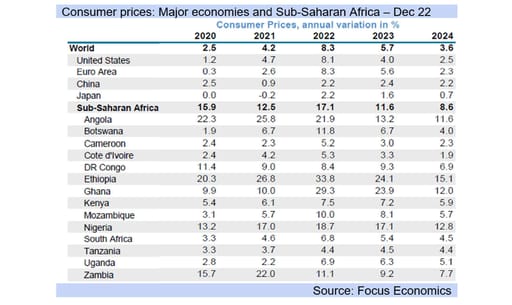
Inflation has arguably been the global economic watchword of 2022. A sharp rise in the cost of living, with CPI inflation exceeding expectations, saw a swift response by central banks that has cooled economic growth. In South Africa, inflation is currently forecast at 8.3% y/y for 2022, compared to the consensus forecast of 3.9% y/y in January, while expectations for world inflation are hovering around 5.7% y/y. Global GDP growth is forecast at 2.0% y/y for the year ahead, with growth in Europe expected to stall and the US to eke out a lacklustre 0.4% y/y. For South Africa, we forecast GDP growth at just above 1.0% y/y for 2023. This week's GDP print of 1.6% y/y for Q3.22, higher than consensus expectations of 0.4% qqsa (quarter on quarter, seasonally adjusted), pushes 2022 GDP growth to above 2.0% y/y. But this also sets a high, suppressing base for 2023 growth. Base effects will also be a key factor in 2023 inflation prints, both globally and domestically, with the result that inflation should come out lower than this year, and potentially lower than expected.
Meaningful global risks remain, although some of these are dissipating: in particular, the zero tolerance Covid-19 restrictions in China, which chocked economic growth this year in the world’s second largest economy. The Russian/Ukraine war, which started on 24th February, has receded as a key market focus, largely replaced by concerns about higher interest rates. But recent communications from Federal Reserve Bank Governor, Jerome Powell, suggest the Fed is moderating its severely hawkish stance, presaging smaller hikes in US interest rates going forward, with greater sensitivity to the effects on the economy.
Domestically, the focus is squarely is on the political developments that will unfold over the course of December. The ANC NEC (National Executive Committee), at a meeting earlier this week, unanimously voted to support the incumbent presidient, Cyril Ramaphosa. The NEC concluded that the ANC MPs in parliament will not support the adoption of the Phala Phala report (Section 89 panel report) on the basis of a lack of hard evidence supporting its findings that the president has a prima facie case to answer.
A two-thirds majority is needed to impeach the president in parliament, which will not be achieved without the ANC voting to impeach. The Phala Phala report itself relies extensively on hearsay evidence, much of it from witnesses who clearly have personal and political axes to grind. Ramaphosa has applied to the Constitutional Court to review the report, and, should the outcome of this process be in his favour, this would remove his opponents’ ammunition, strengthening his position and that of his supporters. An open vote in parliament in two weeks’ time would expose any ANC MPs who vote to impeach as opponents of Ramaphosa, which may serve as a disincentive for MPs concerned about harming their political careers should Ramaphosa survive the vote.
The court review of the Section 89 panel report has not yet begun, and the findings will take some time, particularly given the national importance of the matter. In the absence of a court ruling, political noise around the issue is likely to drag on in the lead-up to the ANC elective conference in two weeks’ time. The outcome of that conference is critical to continued political and economic stability, and any dramatic change of the guard could have far-reaching implications. But the president remains very popular in the ANC, and has the support of the ANC NEC, the party's most powerful decision-making forum. We continue to believe a cabinet reshuffle will occur next year. Ramaphosa will likely use this as an opportunity to remove opponents to his economic policies, thereby speeding up the implementation of the structural reforms that SA desperately needs to get back on the path to inclusive economic growth.
South Africa remains a small, open economy and will be negatively affected by weakening global growth. Most urgently, the president needs to address deficiencies in electricity, rail and ports, as well as water infrastructure, which are prerequisites to economic growth and stability as well as sustainable state revenues and debt levels. An impeachment, however, would destabilise the country and risk miring the economy in another lost decade, as occurred under RET leadership over the 2010s.

Political note: uncertainty high, but Phala Phala findings are inconclusive
2 December 2022
The report says President should be called to account.
Yesterday’s release of the Phala Phala report on the theft of hard currency at President Ramaphosa’s game farm delivered a more negative finding than was expected. The President has steadfastly denied wrongdoing, but SA was shaken yesterday by concerns about his resignation.
The report focuses on the president’s behaviour in relation to the theft of US$580 000 from his Phala Phala farm: purportedly the proceeds from the sale of buffalo to a Sudanese businessman. The president has stated that he has “no personal knowledge” of how the theft occurred.
The report notes that, by law, the president should not be undertaking any paid work outside of his official duties. Evidence presented to the panel, however, suggested that the president "clears sale transactions, gives instruction on how to manage cash sales, and discuss potential buyers, [which] suggests strongly that he oversees operations in the business".
Additionally, President Ramaphosa is accused of failing to report the theft. The initial report accusing Ramaphosa of numerous crimes in relation to the Phala Phala theft was filed in June by Arthur Fraser, former head of State Security. Fraser is a controversial figure who is regarded as allied with the so-called "RET" (Radial Economic Transformation) faction and who was instrumental in Zuma's early release from prison last year.
Judge Sandile Ngcobo, leading the Phala Phala panel's investigation, categorised Fraser’s complaint as relying on “hearsay evidence” and said that “Mr Fraser has not disclosed the source of his information”. But Judge Ngcobo's findings nevertheless gave some weight to Fraser's complaint: “given the seriousness of the allegations he (Mr Fraser) is making and potential harm they can cause if untrue, we assume that at an appropriate forum and when the need arises, he will, when called upon to do so, disclose the source or sources of his information”.
This is a substantial assumption, and the report concludes, “(w)e think the proper approach is for us to be satisfied that there is some other independent information which tends to support the hearsay evidence complained”.
The panel adds “while Mr Fraser’s statements provide information that may help to verify the truthfulness or otherwise of his allegations, the present process does not permit the panel to investigate these matters. This, of course, does not mean that we must blindly accept the information contained in Mr Fraser’s statements in the hope that it may … be verified”.
The findings are silent on Fraser's possible political motives for filing criminal charges.
The RET faction and Ramaphosa’s other adversaries, including several people who are fearful of prosecution for their role in state capture, or hope to gain from its reinstitution, are seen to be leading the targeted attack against the president as the ANC elective conference approaches.
While the president's ownership of the game farm is not inquestion, it is not clear whether he is paid for his oversight of the farm. There is nothing in the law that prevents a standing president from owning property, but no high official should run business/es with significant financial gain.
Similarly, there is no suggestion that the president failed to report the crime at all. Indications are that he reported it to the head of his seccurity protection detail. But there remains a case to answer, the report says, around possible money laundering and failure to properly report the theft. The report concludes that there is a case for a parliamentary impeachment panel.
While any determination as to the president's guilt or innocence is beyond the scope of the report, there is no doubt that Ramaphosa's reputation has been tarnished ahead of the critical ANC elective conference later this month.
The rand moved from R16.80/USD yesterday before the release of the report, to R17.68/USD as markets feared the president would resign, potentially leaving the way open for destabilising RET forces to take over, which would damage the economy. The domestic currency has pulled back to R17.59/USD today.
Prior to the release of the report, Ramaphosa was set for a second term as both President of the ANC and of SA. Further evidence that the president will fight convincingly to clear his name will lift the rand and the JSE after the recent tumbles, although risks remain and the elevated political noise has afflicted domestic markets.

MPC update: SARB lifts rates by a further 75bp to 7.00%
24 November 2022
The SARB’s monetary policy committee (MPC) opted to hike the repo rate by a further 75bp to 7.00%, in line with consensus expectations and the Federal Reserve Bank’s move earlier in the month.

The Reserve Bank’s headline consumer price inflation forecasts for 2022 and 2023 have increased slightly to 6.7% (from 6.5%) and 5.4% y/y (from 5.3%) respectively. The headline inflation reading is only anticipated “to sustainably revert to the mid-point of the target range by around the second quarter of 2024”, according to the SARB.
Overall risks to the inflation trajectory remain assessed to the upside. Specifically, notwithstanding the deceleration “of global producer price and food inflation, Russia’s war in the Ukraine continues, with adverse effects on global prices generally”. The SARB has upped its local food price inflation projection for 2022 to 8.8% from 8.1%, partly due to the “weaker exchange rate”. The forecast for 2023 has also been increased, rising to 6.2% (from 5.5% previously).
The highly volatile oil price continues to remain a key upside risk as do electricity rates and other administered prices. Moreover, a sizable risk “still attaches to the forecast for average salaries”.
While the domestic currency along with other emerging market currencies has gained some ground on a weakening greenback it is still -7.0% weaker on a year-to-date basis and remains a risk to the inflation outlook. Indeed, “… with few exceptions, capital flow and market volatility will be elevated for emerging market assets and currencies,” according to the SARB. The implied starting point for the rand is now projected at R17.76 (Q4.22) to the greenback versus R16.91/USD (Q3.22) at the previous MPC meeting.
The global growth outlook has subsided further, with growth expected to decelerate (relative to previous projections). Specifically, the Reserve Bank has amended its global growth forecast for 2023 to 1.9% from 2.0% previously.
On the domestic front, the economic environment remains fragile. The SARB has decreased its GDP forecast modestly for the South African economy to 1.8%, from 1.9% for 2022. Following a -0.7% qqsa contraction in growth in Q2.22, largely on account of the severe floods in KZN which impaired economic activity, a 0.4% qqsa lift is anticipated for Q3.22. Persistent heightened load shedding is however expected to weigh heavily on Q4.22’s outcome.
The SARB’s medium term projection “incorporates an assumption of increased load-shedding, which could deduct 0.6 percentage points in 2023”. Indeed, the electricity supply situation in the country is dire, with “record” load shedding weighing on all sectors of the economy, decreasing confidence and discouraging investment. Indeed, business confidence dropped further into contractionary territory in Q4.22.
Indeed, conditions are anticipated to remain “volatile for the foreseeable future” and accordingly in such an “uncertain environment, monetary policy decisions will continue to be data dependent and sensitive to the balance of risks to the outlook”.

Medium term budget: Godongwana strikes an optimistic tone
26 October 2022
Improved debt trajectory thanks to higher GDP and lower borrowing.

2022’s Medium–Term Budget Policy Statement (MTBPS) has seen the expected improvement in government’s debt to GDP and fiscal deficit projections. Over the medium-term, gross debt is projected to now peak at 71.4% of GDP in 2022/23, more quickly now than the previous peak estimated at 75.1% of GDP in 2024/25.
The declining ratios are due to some drop in borrowings and a revenue overun, but key is the upwards revisions to its GDP forecast by National Treasury in order to account for higher inflation, with both the gross loan debt and deficit ratios lower as a % of GDP. The 2022/23 budget deficit is now projected at -4.9% of GDP versus the -6.0% of GDP estimated for this fiscal year in February.
The following three medium-term years, of 2023/24 to 2025/26, see the budget deficit projected at -4.1% of GDP, -3.9% of GDP and -3.2% of GDP versus the February 2022 Budget estimates of -4.8% of GDP and -4.2% of GDP. A significant degree of planned fiscal consolidation is evident.
That is, the medium-term budget deficit estimate drops to close to -3.0% of GDP, the ratio at which the budget deficit is seen as contributing to sustainable government finances, although for debt the ratio is 60% of GDP, with SA’s budget estimate not including that in the medium-term. The current fiscal year (2022/23) has seen a substantial boost to nominal (actual) GDP due to high inflation, which has eased both the fiscal debt and deficit projections as a % of GDP, although does not boost real GDP, which is the measure of the country’s growth and has the distorting effect of inflation removed.
Little detail was given on absorbing Eskom’s debt onto the state balance sheet, other than it will be of the magnitude of one to two thirds of the R400bn and that National Treasury “is leading a process to finalise a debt relief programme designed to restore Eskom to efficiency and financial sustainability. The specifics of the programme, including the selection of the relevant debt instruments and the method of effecting the relief, are still being finalised”.
With gross loan debt dropping over the 2023/24 to 2025/26 Medium-Term Framework period, to 70.8% of GDP, then 70.4% of GDP and then 70.0% of GDP, this is also in line with our expectations of close to 70% of GDP. However, we continue to believe government remains wary of absorbing Eskom’s (and other SOE) debt it has guarantees over.
The level of estimated gross loan debt rises in 2022/23 in rand value, to R4.8 trillion in February’s estimated R4.7 trillion but then in 2023/24 drops to R5.0 trillion from the prior projection of R5.1 trillion and then in 2024/25 drops again to an estimated R5.3trillion from R5.4trillion in the February estimates.
The budget is credit neutral to positive, and no immediate credit rating upgrades are likely as the agencies wait for the details on National Treasury’s plans for Eskom’s debt. A rise in SA’s debt ratios due to absorbing Eskom’s debt is unlikely to be a concern for the credit rating agencies, which have been calculating Eskom’s debt as part of government’s responsibilities as the state mainly guarantees the repayment of Eskom’s debt.
Taking over Eskom’s debt will allow the SOE to enter the markets again to accumulate more debt, although markets would likely be wary, given the parastatal’s track record, if it is not state guaranteed, and demand high returns. However, concern centers around government’s capacity to absorb Eskom’s debt for a second time, and so the states’ ability to guarantee a new round of Eskom debt.
The rand has strengthened to R17.96/USD this afternoon from R18.15/USD this morning, but was at R15.19/USD after the February Budget this year, with a severe risk averse environment in global financial markets weakening the rand in the interim. SA’s credit risk has subsided somewhat. The sheer quantum of debt still climbs however, with 2025/26’s R5.6trillion double 2018/19’s R2.8trillion.
The focus remains firmly on fiscal consolidation, with 2023/24 expected to see a primary budget surplus (where revenue exceeds non-interest spending) of 0.7% of GDP. Economic reforms to drive growth remain in focus too, particularly the need to raise electricity supply to the level demanded by a fast growing economy. The surprise in the budget was the planned reduction in borrowings, and this should be positive for yields, although the global risk off environment, high inflation and rising interest rates dulls the potential for a very sharp improvement.

ANC elective conference expected to see Ramaphosa remain president
14 September 2022
Latest Ipsos poll shows waning support for the ANC, and while it’s too soon to call the 2024 election, indications from the provinces show that the incumbent President is likely to maintain the majority of support in the ANC elective conference.
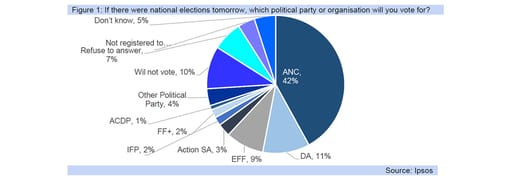
The waning national support for the ANC, at 46% of the vote in 2021’s municipal elections, worsened in the latest Ipsos poll, to 42% (modelled on all eligible voters). However, it is too early to call the outcome of the 2024 election with any high degree of confidence and it is key to note survey results vary.
Survey variance is due to, among other factors, the assumed turnout of voters, with last year seeing a very low turnout - from 26 million registered voters only 12 million voted (46%) on prevalent voter dissatisfaction.
In contrast to Ipsos, the Social Research Foundation’s (SRF) survey by Victory Research, seen to be “representative of the voting population” shows an ANC victory in 2022. That is a 52% majority on a 56% voter turnout.
The recent progress of operation Vulindlela and the electricity plans are positive, and while they are largely medium to long term in nature, may already have had some sway with the electorate towards to the ANC, on the back of the Ramaphosa's camp, as the Victory Research and SRF results indicate.
ActionSA (ASA) made rapid gains in the municipal election in areas it contested and is expected to do so overall in the 2024 national election too, highlighting the widespread desire for better governance, and an improvement in economic activity and so job creation.
South Africa’s frequent key political events, with the national elections interspersed with municipal elections, as well as the leading party (ANC’s) elective and policy conferences, lead to political volatility, diverting attention and slowing the implementation of economic reforms, either purposely or inadvertently.
Indications from provincial support show that the incumbent President is likely to maintain a majority support in the ANC elective conference, but this will not deter anti-Ramaphosa factions/s from attempting to unseat him by any means possible.
Before the 2024 election, the ANC elective conference has to be passed first, and the political noise is likely to get louder into year end, as the RET faction become increasingly desperate to unseat Cyril Ramaphosa.
The bottom line is that ANC still needs to deliver faster economic growth and employment to gain certain traction among voters, particularly given mixed survey results.

Rand Outlook: markets yet to see end to risk-off
25 August 2022
The current environment is unique in recent times as it is providing a substantial forewarning of a marked global economic slowdown, to the potential point of, or actual, recession
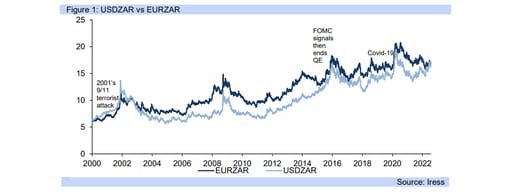
The current environment is unique in recent times as it is providing a substantial forewarning of a marked global economic slowdown, to the potential point of, or actual, recession, as opposed to the recessions of the pandemic and the 2008/09 financial crisis, which were sudden and not possible to prepare for.
The lengthy preparation markets are having as a consequence of monetary policy communications from a spread of Central Banks, namely that inflation is the priority, not growth, has caused risk aversion to increase towards assets which are seen to perform substantially more poorly in times of weakening economic activity.
The US dollar has undergone a long period of strength since April, when global economic growth forecasts began being widely, and notably revised down for this year and next year. The global interest rate hiking cycle is not near its end, while evidence of weakening economic activity is apparent around the globe.
The process to contain decades high inflation back to within targets, with no clear timing of when this will happen, is increasing uncertainty, supporting risk-off. The resultant strengthening in the US dollar since April has culminated parity with the euro, a key reason for rand weakness against the US dollar since April.
The majority of the drivers of the rand’s weakness (or strength) in the short- to medium-term is typically due to global factors. This does not mean that domestic factors do not have an effect, indeed they can have very substantial effects.
However, global events also tend to have large effects, such as seasonal and cyclical factors, as well as global shocks, although the latter is typically sudden, not long lasting as the current high inflationary, rising interest rates and weakening economic growth environment is.
2021 saw a recovery in significant part from the global pandemic’s economic effects, although not on the world’s supply chains, but 2022 saw the shock of the Russian/Ukraine war, with resulting sanctions over the past six months worsening, intensifying the negative effect, along with the economic downturn in China.
As soon as markets gain some certainty on the likely turn in the global economic outlook, end to the US, and global, upwards rate hike cycle and indications of potential for economic recovery, risk aversion levels will likely fade towards a more neutral level of investor confidence, reducing the pressure on risk assets.
Currently the rand averages around R16.75/USD this quarter, against our forecast of R16.60/USD, in a volatile quarter, but also one of mainly rand weakness against the USD. The outlook remains at risk of further shocks, with Europe’s gas supplies at risk, and the outlook for inflation for Europe also of key concern.
The rand is likely to remain highly volatile, affected significantly by economic data and policy decisions in the US in particular, with the US possibly seeing the quickest economic recovery in 2023, although uncertainty levels are high currently.

Business cycle update: to improve longer-term on energy actions
26 July 2022
The energy crisis came to a head in July on stage 6 load shedding, prompting presidential announcements on a set of actions

The leading indicator of future economic activity (compiled by the SARB to inform on economic activity six months out, i.e. Q2.22 informs on Q1.23) fell by -8.5% y/y in May after a revised drop (lower) of -5.4% y/y in April, as the business cycle in Q2.22 remained affected by the floods in KZN in that quarter, along with a base effect of strong activity a year ago.
Additionally, the impact of the Russian/Ukraine war, economic lockdowns in China, negatively affected supply chains and slowing global growth affected the reading, as did load shedding. The composite leading business cycle indicator for South Africa’s major trading-partner countries fell -0.9% in April (latest reading), also reflecting these factors above.
The energy crisis came to a head in July on stage 6 load shedding, prompting last night’s presidential announcements on a set of actions, which include “improving the performance Eskom’s existing fleet of power stations”, “accelerating the procurement of new generation capacity”, “massively increase private investment in generation capacity”, “enable businesses and households to invest in rooftop solar” and “fundamentally transform the electricity sector and positioning it for future sustainability”.
The President added “the shortage of electricity is a huge constraint on economic growth and job creation. It deters investment and reduces our economy’s competitiveness.” However, the success of the planned actions will depend wholly on the rapidity of implementation, which has historically been very tardy.
Regulatory hurdles and the extremely slow pace of state bureaucracy has impeded the development of the private energy sector and a large-scale crowding in of private sector generation is rapidly needed, which the President has now given strong support for, along with the need for a severe clampdown on theft and criminal activity, payment of services, stabilising Eskom and improving its plant performance. A competitive energy market is envisioned, along with a strong increase in renewable energy investment.

MPC update: SARB lifts rates by a 75bp to 5.50% as inflationary pressures rise
21 July 2022
The SARB’s monetary policy committee (MPC) opted to hike the repo rate by 75bp to 5.50%, ahead of consensus expectations. The decision was split, with three committee members in favour of a 75bp hike.

Overall risks to the inflation trajectory are tilted to the upside and accordingly the Reserve Bank has revised its headline consumer price inflation projection notably higher for this year to 6.5% (from 5.9% previously). This is in line with projections for inflation based on market surveys.
2023’s headline CPI forecast at 5.7% (previously 5.0%) has also been lifted on higher projected food, fuel, and core inflation. “Russia’s war in Ukraine is likely to persist for the rest of this year and may have significant further effects on global prices,” according to the SARB. 2024’s headline number is however expected to remain unchanged (from May’s meeting) at 4.7%, closer to the mid-point of the inflation targeting band.
Core inflation expectations have been raised to 4.3% (previously 3.9%) for 2022 and to a notable 5.6% (from 5.1%) for 2023. The projection for 2024 has also been increased modestly to 4.9% (from 4.8%). Specifically, according to the SARB both “core goods and services price inflation are forecast higher through to the end of 2024, compared to May when only core goods inflation was rising each year”.
The highly volatile oil price, a major commodity import, together with the weak domestic currency remains a key upside risk to the inflation outcome, through its effect on fuel prices. The SARB now anticipates fuel price inflation for 2022 at 38.9% (up from 31.2%).
Similarly, food price inflation which makes up a large portion of the CPI basket has been revised upwards and is expected to average an elevated 7.4% (previously 6.6%) in 2022 and 6.2% in 2023 (from 5.6%). “South Africa, a relatively small player in global agriculture, is linked to the global market and is therefore generally a price taker for various commodities,” according to Agbiz.
Heightened inflation (which is at the highest reading in decades in some advanced economies) has propelled major central banks to hasten “the normalisation of policy rates”. Accordingly, “capital flows and market volatility are expected to remain elevated for emerging market assets and currencies” with the rand a key risk to the inflation trajectory.
Specifically, the domestic currency has weakened notably along with other emerging market currencies as a result of the greenback’s strength on safe haven inflows, with the USD reaching parity to the euro. The rand in particular, a key commodity currency has also weakened as metals prices have lost ground. Accordingly, the implied starting point for the rand is now projected at R16.10 to the greenback versus R15.88/USD at the previous MPC meeting.
The global growth outlook has subsided, with growth expected to decelerate (relative to previous projections). The SARB has amended its global growth forecast to 3.3% (from 3.5%) for 2022 and to 2.5% (from 2.7%) for 2023 and 2024 respectively.
The SARB has increased its GDP forecast modestly for the South African economy to 2.0%, from 1.7% for 2022 as the Q1.22 GDP print surprised on the upside. However, rates of growth for 2023 and 2024 have been decreased to 1.3% and 1.5% respectively from the previous forecast of 1.9% (for both years). “Overall, and after revisions, the risks to the medium-term domestic growth outlook are assessed to the downside”. Indeed, SA’s electricity supply predicament remains a key risk.

Macro-economic outlook: South Africa 2022- 2027
1 July 2022
At increased risk of recession the longer stage 6 load shedding persists, or even consistent stage 4 over H2.22
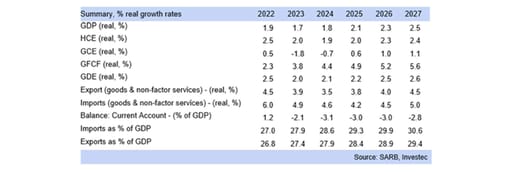
South Africa sees economic growth at risk this year from the recent severe load shedding regime implemented at stage 6, even though it fluctuates to stage 4 intermittently, and the outcome for 2022 GDP will depend on how long the country experiences severe outages.
A couple of days of stage six load shedding in one year will neither derail economic growth, nor credit ratings’, outlooks for SA, but persistent severe loadshedding will, while SA enters a worsening global economic environment in H2.22 as well.
This comes as SA’s fiscal metrics have been benefitting from both improved revenue collections (on the back of high commodity prices and increased SARS efficiencies), and the dampening effect of high inflation itself on the debt and deficit ratios to (nominal) GDP.
After the strong Q1.22 GDP outcome, the second quarter of this year is likely to record a contraction on the back of the flood damage in the KZN province, and the ramp up in electricity loadshedding, along with the weakening in global demand and low confidence levels.
Additionally, the electricity grid has been under severe strain, with Q3.22 starting off with stage 6 load shedding, afflicting the economic growth potential. Load shedding contributed to the decline in economic growth from above 5.0% y/y in 2008 to 0.1% y/y by 2019.
An economy cannot function to its full potential with insufficient electricity supply, and the parlous state the recent strike action has also had on electricity production, along with the intentional sabotage of electricity power stations and infrastructure has damaged H1.22 GDP.
Manufacturing was the key sector contributing to strong GDP growth in Q1.22, with trade and finance also bolstering GDP activity, but rapidly rising interest rates will eat into consumption, with Q2.22 consumer confidence severely depressed indicating reduced spend.
Both business and consumer confidence fell deeper into depressed territory in Q2.22, led lower by a severe collapse in South Africa’s manufacturers confidence, and 71% were dissatisfied with prevailing conditions in Q2.22, as were new vehicle dealers.
Q2.22 has proved to be very different to Q1.22, and Q3.22 takes many of the suppressing effects from Q2.22, including sharply higher interest rates and weakening global demand, with global recession a concern. SA unlikely to see GDP growth of above 2.0% y/y for 2022.

Trade note: 2022 performance worse than 2021 so far
28 June 2022
Rapidly rising value of imports, particularly oil and petroleum products, weakens SA’s trade performance
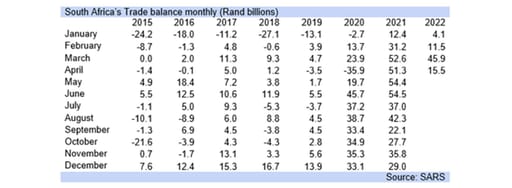
Despite very high commodity prices, South Africa is seeing a substantially weaker trade performance this year to date, with the trade surplus at R78bn almost half the size recorded a year ago for the same period, and weaker each month in 2022 so far versus 2021.
Structural constraints, including electricity load shedding, dwindling transport capacity on the rail networks (on theft of infrastructure, vandalism, poor management of systems, finances and procurement) and issues at the ports are not the only factors for the poor performance.
South Africa’s imports exceeded the growth in exports for the first four months of this year, with imports up R111.4bn and exports only R42bn higher. Oil, petroleum products and related chemical imports accounted for a hefty R87.1bn of SA’s imports so far this year.
Exports still exceed imports, yielding trade surpluses so far this year, but imports have accelerated rapidly in January to April, and if the pace continues, SA will be in a trade deficit by next year if commodity prices remain at the levels of 2022 to date (if not earlier).
This will negatively impact the current account, removing a key support that limited the degree of weakness the domestic currency experienced in the face of a switch into marked investor risk-off this year on the Russian/Ukraine war, and higher US interest rates.
High oil and petroleum product prices have driven SA’s rand value of its imports substantially higher, and energy and food costs globally continue to drive high inflation, with SA’s exports of bulk products such as coal hindered by structural constraints in state transport systems.
South Africa is expected to return to a trade deficit, and so a current account deficit, and see current account deficits over he next five years if the country does not manage to cease importing oil and petroleum products, and instead extract, and refine, its own.
SA’s refining capacity is at a low level, and SA is a heavy importer of refined products, which Russia exports too. To combat high fuel costs Minister Mantashe is reported to have said “(w)e should consider importing … from Russia at a low price because it is not sanctioned”.
Many European nations have little alternative but to continue importing energy commodities from Russia, but SA doing so in order to gain a price benefit may have negative repercussions on its trade relations with Germany and the US, its top two export destinations (UK fifth).

Business confidence: drops in Q2.22 as manufacturing production slows
8 June 2022
With the Q2.22 BCI survey taking place between 11th and 30th May it has been influenced by the KZN floods, higher costs, the drop in global financial market sentiment over April

With the Q2.22 BCI survey taking place between 11th and 30th May it has been influenced by the KZN floods, higher costs, the drop in global financial market sentiment over April, as many key institutions revised down their global growth forecasts, and higher domestic and global interest rate expectations.
SA’s inflation rate is not yet at a peak, with higher cost pressure to come for businesses. While we currently expect a peak of 6.8% y/y in June, there is around another R2.00/litre hike building for the petrol price in July, and around a R1/litre for diesel (R1.33/litre for illumination paraffin), which will add significantly to living costs.
Businesses will continue to worry about the ebbing purchasing power of consumers, coupled with the impact of higher interest rates, which will also negatively impact business sentiment in Q3.22.
Yesterday’s better than expected GDP print for Q1.22 will add to the pressure for higher interest rates in SA, and a 50bp hike at the SARB’s July MPC meeting seems more likely now than a 25bp lift.
The persistence of the Russia/Ukraine war is elevating food and energy commodity prices in particular, with sanctions increasing against Russia, which further bolsters energy costs, and adds to global supply chain costs, as does the blockading of key transport routes in the Black Sea.
Manufacturers and new vehicle dealers’ activity saw a sharp deterioration in Q2.22, with vehicle dealers experiencing stock and parts shortages for the manufacture and repair of vehicles, as the global supply chain saw a deterioration in deliveries in Q2.22. The closure of the Toyota plant in KZN due to food damage exacerbated the situation, and new vehicle dealers’ confidence dropped to an extremely weak 29.
Manufacturer’s confidence also plunged to 29 on the KZN floods impact, as 71% of manufacturers and new vehicle dealers were dissatisfied with business conditions in Q2.22, from around 50% in Q1.22, while production was reported to have weakened in the manufacturing sector in Q2.22 overall.
Retailers have also been impacted by higher interest rates; we now expect the MPC to hike the repo rate by 100bp in H2.22 in total as the FOMC does at its next two meetings. Marked pressure would be placed on the rand if the SARB allows the differential between SA and US interest rates to narrow significantly.
The last sector surveyed, building contractors saw a lessening of depressed sentiment, rising to 46 from a very depressed 25. Overall, the business climate was reported to have deteriorated severely over Q2.22, dropping to a reading of -10 from a positive 3 in Q1.22, heralding a marked slowing of GDP growth in the second quarter of 2022.

FOMC note: markets interpret 50bp hike as sign of reduced hawkishness
5 May 2022
The rand strengthens back towards R15.40/USD as Fed dispels fears of extreme rate hikes.

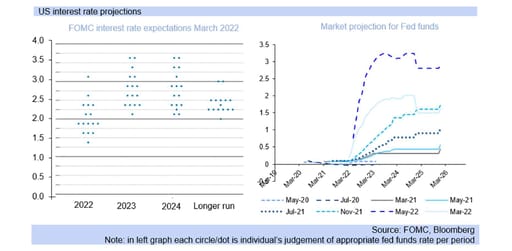
Last night’s Federal Open Market Committee (FOMC) meeting saw the target range for the federal funds rate rise to 0.75% to 1.00% (by 50bp), with the committee highlighting that “additional 50 basis point increases should be on the table at the next couple of meetings.”
Both the 50bp rate hike and Fed comments about the next two meetings only seeing 50bp increments as well (not 75bp increases), allayed market fears of potential 75bp moves, and saw risk aversion subside substantially in markets, with the rand reaching R15.41/USD.
The rand reached R16.20/USD, R17.04/EUR and R20.28/GBP on Monday as market fear of an extreme US rate hike cycle pushed up risk aversion levels. The domestic currency also subsided against the crosses after the FOMC meeting, to R16.34/EUR and R19.41/GBP.
The Fed Chair, Jerome Powell, added at the FOMC’s press conference last night that the FOMC is “on a path to move … the policy rate expeditiously to more normal levels”, signalling that monetary policy normalisation will continue at a rapid, but not extreme pace.
The normalisation process includes reducing the size of the Fed’s balance sheet “over time in a predictable manner”, “ guided by …. maximum employment and price stability goals, … adjusting any of the details of our approach in light of economic and financial developments.
Furthermore, he underscored that “the American economy is very strong and well positioned to handle tighter monetary policy”, “inflation is much too high and we understand the hardship it is causing, and we’re moving expeditiously to bring it back down”.
The tone of the FOMC remained hawkish, comparable to the last meeting, and did not see a marked ramp up to extreme hawkishness. Risk assets overall benefitted, with the rand likely seeing support for further strength in the remainder of the month.
Chairman Powell specified that the “underlying momentum … (of economic activity) remains strong”, “household spending and business fixed investment continued to expand briskly. The labor market has continued to strengthen and is extremely tight.”
“Improvements in labor market conditions have been widespread, … labor force participation has increased … (but) labor supply remains subdued. Employers are having difficulties filling job openings, and wages are rising at the fastest pace in many years.”
In South Africa, the market view is still divided between a 25bp and 50bp hike at the next MPC meeting (19th May), with 25bp fully factored in, and up to 32bp in the FRAs, but not a full 50bp hike yet, which would likely result in further rand strength if it transpired.
The SARB lent towards hiking the repo rate by 50bp in March, and could yet deliver a 50bp lift on the 19th of this month. However, the destruction of the KZN floods, and moderation in commodity prices, particularly oil since the last MPC meeting, could limit the size of the hike.
SA’s monetary policy is nevertheless likely to remain on a normalisation path, with the SARB primarily focused on inflation, seeking to ensure it returns to 4.5% over its forecast period and so bring the repo rate up to a neutral level of around 6.50% over the next few years.
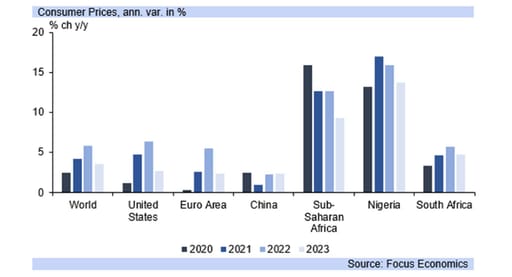
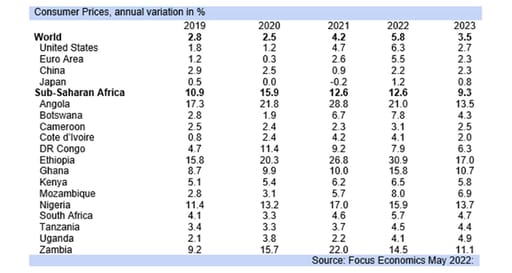

Fourth SA Investment Conference highlights continuing positive sentiment
24 March 2022
Last week's conference confirmed that South Africa is on track to achieve government's five-year goal of R1.2trillion in private sector fixed investment.
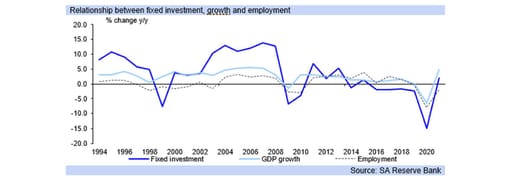
The fourth SA Investment Conference (SAIC) is part of a five year drive to achieve R1.2trillion in private sector fixed investment in South Africa. Progress has been substantial, with the value of investment commitments from large corporates benefitting from recent rand appreciation.
Prior to the 2022 conference, R774 billion had been pledged by the private sector, domestically and internationally, over the past few years to the fixed investment goal for SA, two-thirds of which were spread across sectors such as mining, manufacturing, agriculture, the digital economy (SA Investment Conference (SAIC) website).
This then left another R426 billion to be raised this year and next. Of the 152 pledges made during the first three investment conferences, 45 have been reported as completed, or will soon be completed, while 57 are under construction. 2022’s Investment Conference shows notable progress towards the goal.
While the MPC announcement and global market forces will have impacted SA markets today, the conference outcome was nevertheless market positive. Indeed, the SAIC’s aim is to showcase investment opportunities in South Africa in order to boost economic growth afflicted by the pandemic and global slowdown. The conference had a particular business friendly tone, a necessary positive for business sentiment.
Strong infrastructure investment in South Africa is part of government’s planned economic stimulus (as well as its economic and social objectives), with the capital expenditure driven by both the private and public sectors, and in combination with each other. This is key, with SA in an upwards interest rate cycle, which is growth negative. The MPC’s 25bp hike today brings its increases to 75bp in the current cycle, and it is likely there will be at least a 25bp hike at each remaining MPC meeting this year.
The SA Investor Conference today highlights large scale private sector fixed investment plans, while the Economic Reconstruction and Recovery Plan (ERRP) outlines government’s capex plans, which include general government infrastructure investment over the next three years of R500 billion. This should also not be discounted, and builds into our exception that South Africa’s economic growth will lift towards 3.0% y/y by 2026.
The ERRP also commits a further R100 billion “over a decade from 2019/20 to the Infrastructure Fund to leverage private- sector and development finance, with R24 billion allocated over the 2022 MTEF period.” SA could see quicker economic growth over the next few years (we currently expect around 2.0% y/y in 2023 and 2024, and closer to 2.5% y/y by 2025) if economic growth reforms are expedited.
This year the National Investment Plan 2050 (or NIP2050) was launched, aligned with the National Development Plan (NDP) 2030, and with the purpose of providing a long-term infrastructure planning framework for South Africa. The broadscale plans will strengthen longer-term growth, and improve socio-economic conditions if successful, although in the short-term SA remains at risk from global geo-political evets and from a stagflationary environment.
During today’s conference President Ramaphosa highlighted that infrastructure "does move the needle, it may not wipe out the entire unemployment (figure), but it does add to the number of people who are employed. … I think we are going to meet our target and even exceed it because South Africa is a really hot investment destination.”

Budget Update: debt projections prove better than markets expected
23 February 2022
2022’s Budget Review saw a significant improvement in government’s debt to GDP projections and fiscal deficits.

2022’s Budget Review saw a significant improvement in government’s debt to GDP projections and fiscal deficits. Over the medium-term, gross debt is projected to now stabilise at 75.1% of GDP in 2024/25, (previously the projection peaked at 78.1% in 2025/26), placing SA on a firmer footing to avoid a downgrade from Moody’s given its negative outlook, which should now become stable.
The borrowing requirement has been reduced, by R135.8 billion in 2021/22, and by R131.5 billion over 2021/22 and 2022/23 combined. Fiscal consolidation has clearly been deepened, and the revenue overrun is being used to shore up state finances, avoiding unsustainable expenditure hikes.
Also as a consequence of the R182bn revenue overrun from the 2021 Budget estimate for this fiscal year, and a R62bn overrun than the 2021 MTBPS estimate for 2021/22’s revenue, the estimated budget deficit has dropped sharply to -5.7% y/y for this year (from the MTBPS’s -7.8% of GDP), but is still substantially wider than the -3.0% of GDP limit for recognised fiscal health (although preferably below this).
A primary surplus is envisioned by 2024/25. Minister Godongwana has shown strong fiscal gains with the core message being that government is “on course to close key fiscal imbalances and restore the health of public finances”. With debt still to escalate, to R5.4trillion (from R4.8trillion this year), gross debt has not yet peaked as a % of GDP and as such does not signify credit rating upgrades, but not downgrades either the debt ratio returns to the current position by 2029/30 without slipping into B+ territory.
The budget deficit for 2022/23 is still forecast at -6.0% of GDP as it was in the MTBPS, but drops to -4.8% of GDP for 2023/24 (-5.3% in the MTBPS) and -4.2% in 2024/25 (MTBPS -4.8%). Debt ratio projections are lower too, from 2021/22’s 69.5% (2021’s MTBPS projected 69.9%) and for 2022/23 to 2024/25 at 72.8%, 74.4% and 75.1% of GDP (MTBPS projections of 74.7%, 76.8% and 77.8% of GDP).
South Africa has benefited temporarily from the commodity boom, but longer-term will find fiscal consolidation without a dependable higher state revenue stream more difficult. It would instead require a move away from accelerating current expenditure, and the Minister spoke against permanent social welfare increases, pressure from the public services wage bill and further bailouts for SOE’s.
Overall, the budget is solid and pleasing, but there are still multiple risks which could derail it, including political in SA. Tax payers experienced slight relief for fiscal drag, while the focus remained on reducing debt projection and this was positive for the bond market as borrowings ease compared to projections, but on balance the budget is like to be viewed as credit neutral by the rating agencies. The NHI was not mentioned, while alcohol, sugar and tobacco product (sin taxes) rose again.

Sona expected to give insight into problems plaguing SA's economy
4 February 2022
The President’s State of the Nation Address (SONA), 10th February at 7pm this year, provides updates on government’s policy focus and implementation of economic plans, specifically the ERRP (Economic Reconstruction and Recovery Plan).

It will also address progress made in combatting COVID-19 (30 million vaccine doses administered so far) and in alleviating its effects on South Africa (the SDR grant is eventually likely to see further extension, into a form of BIG), address social issue and concerns, and provide updates on budget plans (expenditures).
The themes of building an ethical, capable state, combatting corruption and state capture reoccur in the SONA, which is expected to indicate the next steps following on from the Zondo commission.
The President’s address is also likely to highlight other reoccurring themes, including education, skills and job creation, the fight against gender-based violence, the need to improve living conditions and the focus on the infrastructure and investment drive.
However, the likelihood is that nothing new will be enacted to substantially reduce the smothering regulatory burden which limits the growth of SA’s private business sector.
SA is likely to see economic growth of 1.8% y/y in 2022, with growth likely to lift toward 3.0% y/y by 2026 as growth enhancing reforms gather pace, including those in the key electricity sector, with insufficient electricity supply for a faster growing economy a risk.
The substantial planned fixed investment in the electricity sector, specifically from private sector power producers, will however take many years before stabilising the grid, and SA is still at high risk of load shedding.
Government’s planned borrowings and fiscal deficit have been projected lower as a % of GDP in November’s MTBPS, and the Budget on 23rd February is not expected to see any upwards revisions, while next week’s SONA is anticipated to give insight on spending pressures.

SARB lifts rates by a further 25bp to 4.00%
27 January 2022
The SARB’s monetary policy committee (MPC) opted to hike the repo rate as risks to the inflation trajectory remain to the upside

The SARB’s monetary policy committee (MPC) opted to hike the repo rate by a further 25bp to 4.00%. The majority of MPC members (four) were in favour of a hike, with one preferring an unchanged stance.
Overall risks to the inflation trajectory remain to the upside and accordingly the Reserve Bank has revised its headline consumer price inflation projections higher for this year. Specifically, CPI is now projected to reach 4.9% in 2022 (from 4.3% previously). 2023’s headline CPI forecast has declined marginally to 4.5% (4.6% previously) and remains unchanged at 4.5% for 2024.
Specifically, the volatile oil price, a major commodity import, has picked up notably, with current prices well above the SARB’s projected “levels for this year” and therefore remains a key upside risk to the inflation outcome.
“Global producer price and food price inflation continued to surprise higher in recent months and could do so again”, according to the SARB. Food inflation which makes up the largest portion of the CPI basket has been adversely impacted by global conditions. Going forward meat prices could present an upside risk to inflation this year, depending on the direction that slaughtering activity takes, according to Agbiz. Furthermore, excessive rains which have destroyed crops and impeded plantings in SA “present risks for agricultural production this year”. Additionally, the persistent risk of rising electricity and other administered prices remains.
The domestic currency is sitting below its equilibrium level and accordingly the implied starting point for the rand forecast has been revised to R15.60 against the dollar, from R15.10 previously. Accelerated quantitative tightening by the Fed and earlier than anticipated monetary policy normalisation, with US inflation having climbed to 6.8% y/y, a 30 year high, will weigh on emerging market currencies and therefore the rand’s performance.
Global growth is expected to decelerate this year as base effects wane, moderating to 4.4% according to the IMF (from a forecast of 4.9% previously). Global growth continues to remain uneven with emerging markets lagging developed economies, prejudiced by slower vaccination rollouts and limited fiscal stimulus.
The SARB has revised downwards its GDP forecast for the South African economy to 4.8% y/y from 5.2% y/y previously. The unrest and looting in parts of the country in July weighed on Q3.21’s GDP outcome. Growth remains unchanged at 1.7% and 1.8% for 2022 and 2023 respectively, but rises to 2.0% in 2024, with the output gap gradually closing. The SARB continues to evaluate the risks to the medium-term domestic growth outlook to be balanced.
The SARB reiterated that “repurchase rate levels reflect an accommodative policy stance through the forecast period, keeping financial conditions supportive of credit demand as the economy continues to recover”.

Rate hike looms as SARB meets next week
20 January 2022
The MPC's hand could be forced by higher oil prices and faster normalisation of global monetary policy

The South African Reserve Bank's Monetary Policy Committee (MPC) meets next week Thursday for its interest rate decision and there is a real risk it shift to a more hawkish stance. At its November MPC meeting, the SARB forecast an inflation rate of 4.3% y/y for 2022, but this will likely see substantial upwards revision, to around 5.0% y/y.
The sharp run up in fuel prices and broadening price pressure from other areas has seen inflation come out at 5.9% y/y for December, and similar prints are expected in January and February. Oil prices are now running at a seven-year high, with Brent Crude (SA’s benchmark for oil import costs) at US88.4/bbl, which we currently expect will translate to a R1.40/litre hike in the petrol price for February.
Oil prices have climbed by US$10/bbl since the end of last year on rising demand as the impact of Omicron wanes and output from OPEC+ remains tight. Markets are concerned oil could climb further towards US$100/bbl as supply fails to keep up with robust global economic growth. OPEC+ is already battling to increase production to meet the current level of demand and major economies are expected to open up further in the course of the year.
On a positive note, the risk of a credit rating downgrade for South Africa this year has subsided following the removal of Fitch’s negative outlook. As a result, SA's overall risk profile has improved, relieving some of the pressure on interest rates. However, the FRA curve is currently factoring in a 25bp hike in the repo rate next week, and the rand has run through R15.20/USD in anticipation. Should rates remain on hold, bucking market expectations, these gains would likely be reversed, and a weaker exchange rate would exacerbate the inflationary impact of higher fuel prices.
The US FOMC (Federal Open Market Committee – responsible for setting US monetary policy) is meeting the day before the SA MPC meeting, on the 26th of January, and this will influence South Africa’s decision. Should the Fed signal that tapering will be slower than anticipated the MPC might well keep SA rates on hold until March.
Markets have factored in four hikes in the US this year, of 25bp each, with the first expected before the FOMC's 16th March meeting. Next week's meeting will therefore shed light on whether the US rate hike curve will steepen. A more rapid interest rate hike cycle would likely see a hawkish stance from the South African MPC, despite SA’s high unemployment rate and an economy that has not yet recovered to pre-Covid levels.
That said, the FRA curve is also currently building in a 2.25% hike in the repo rate overall for this year, which we think is overdone. Such a outcome would require a near 40bp rate hike at every meeting this year, which would be excessive. It is important to note, though, that market expectations fluctuate and financial markets can also overreact at the start of a rate cycle.

Omicron ramps up in SA but hospitalisation rates remain low
3 December 2021
The new mutation is proving particularly contagious even as early data from the NICD shows relatively low numbers of severe cases.

The fourth wave of Covid-19 infections has hit SA hard and fast, with new cases dominated by the highly contagious omicron variant.
The 7-day rolling average of new Covid-19 infections is at 5,093, well up on 3,202 a week ago. This despite the figure a week ago being distorted by the addition of some (18,586) previously excluded cumulative tests on the preceding Tuesday.
Globally, new cases are occurring at 0.7million a day from last week’s 0.6million, and are still on an upwards trajectory on a 7-day rolling average basis. At this point, the curve of infection globally is similar to the trajectory of the third wave.
The US’s fourth wave reached 109,294 new daily infections yesterday. By comparison, the third wave peaked at 285,058 infections per day. The US 7-day rolling average has started to rise again, after a down tick recently, which is usual as numbers can be lumpy.
Deaths in the US, however, still appear to be on a downward trend, ticking up briefly in what looked to potentially be a fourth wave of Covid-19 fatalities but then subsiding again. However, with deaths typically taking place a number of weeks after infection the curve can still tick up again.
Locally, there have been 2.98m recorded cases overall for SA since the pandemic started. Gauteng currently accounts for 72% of cases, the Western Cape 6% and KZN 5%. At present, 2,904 individuals are in hospital with Covid-19. Of all Covid tests conducted in the past week, 22.4% have been positive.
The World Health Organisation (WHO) shows South Africa and central Africa, along with some of North Africa and the west coast of South America imposing some of the most severe public health and social measures globally to combat Covid-19.
To alleviate the devastating economic and health effects of the virus, South Africa is currently assessing the viability of making vaccines against Covid-19 mandatory, at least for certain sectors of the population, as some other countries have done.

New delta sub-variant is driving the fourth wave of Covid-19 infections globally
18 November 2021
SA's fourth wave may be beginning with a rise in daily new cases of Covid-19 infections

South Africa is seeing a rise in daily new cases of Covid-19 infections, at 1,275, still mild, but well up from 312 two days ago, and 116 on the 8th of November. Globally however, the fourth wave is building strongly, centered in Europe and the UK.
The 7-day rolling average of new daily cases of Covid-19 infections was distorted by the addition of some (18,586) previously excluded cumulative tests on Tuesday, bringing the 7-day rolling average to 3,202, but this will wear out the system by next week.
Globally, new cases are occurring at 0.6million a day on the 7-day rolling average, well up on the 11th of October, the dip between the third and fourth wave in global new Covid-19 infections on a 7-day rolling average.
The US is also seeing its fourth wave beginning, and this is worrying financial markets and the risk averse domestic currency is at R15.82/USD today, with very risky assets performing poorly, as the US is expected to continue tapering QE, with potential hikes even in H2.22.
Deaths in the US are also starting to tick up from Covid-19, at 1 ,427 on a 7-day rolling average, approaching the peak in the third wave at 2,087, as the US’s third and fourth waves did not see much collapse between them .
In South Africa, Gauteng is reported to be leading the way in the new wave of infections, with 1,000 out of the 1,275 reported yesterday for the country in Gauteng alone. SA’s positivity rate, the number of tests done, versus positive results, is also reported to be increasing.
South Africa’s National Institute for Communicable Diseases (NICD) reports “the majority of new cases today are from Gauteng (80%), followed (by the) Western Cape for 5%. KwaZulu-Natal and (the) North West each accounted for 3% respectively”.
The “Eastern Cape, Limpopo, and Mpumalanga each accounted for 2% respectively; and Free State and Northern Cape each accounted for 1% respectively of today’s new cases.” “There has been an increase of 53 hospital admissions in the past 24 hours.”
The NICD further reports higher rates in Tshwane, “particularly in Tshwane amongst 10 – 29 year olds’ ”, “Localised increases in case numbers (clusters) are not unexpected, however, it is hard to say whether the increases indicate the start of a widespread resurgence.”

SARB lifts rates by 25bps as inflation pressures build
18 November 2021
The hike follows revision of consumer price inflation projections.

The SARB’s monetary policy committee (MPC) decided to hike the repo rate by 25bps to 3.75%. The decision was however not unanimous. Specifically, three MPC members were in favour of a hike, with two preferring an unchanged stance.
Overall risks to the inflation trajectory remain and accordingly the Reserve Bank has revised its headline consumer price inflation projections slightly higher for this year and the following two years. Specifically, CPI is now projected to reach 4.5% in 2021 (from 4.4% previously), 4.3% (from 4.2% previously) in 2022 and 4.6% (from 4.5% previously) in 2023. Moreover 2024’s headline CPI is forecast at 4.5%.
“Global producer price and food price inflation continued to surprise higher in recent months and could do so again”, according to the SARB. Indeed, Farmers and Agribusinesses are having to contend with rising input costs of fertilizer and agrochemicals as a result of supply chain constraints as well as climbing fuel prices according to Agbiz. However, a “favourable weather outlook for the season and the farmers’ optimism through the intentions to plant data compel us to believe that South Africa could have yet another good crop in the 2021/22 production season”.
Another risk to the short-term inflation outcome is the volatile oil price which has picked up notably, with “current prices well above” the SARB’s projected “levels for this year”. Additionally, the persistent risk of electricity and other administered prices remains. Indeed, Eskom’s electricity price increases have exceeded CPI for over a decade, and this is likely to persist as cash strapped Eskom, continues to face marked financial and operational challenges.
Moreover, rising wage demands, higher domestic import tariffs and a softer rand pose additional upside risks. The domestic currency has depreciated by 5.9% against the green back since the September MPC meeting, underpinned in part by uncertainty over heightened global inflation and the Fed’s policy stance. Accordingly, the implied starting point for the rand forecast has been revised to R15.1 against the dollar, from R14.47 previously. Should we succumb to a further credit rating downgrade at tomorrow’s review by S&P or Moody’s (not our expected case) this would weigh further on the already volatile rand.
The IMF’s global growth forecast for 2021 was revised down marginally to 5.9% y/y in October, moderating thereafter to 4.9% (2022). Rising infection rates, notably in Europe, accompanied by further lockdowns could however affect this outcome. Global growth continues to remain uneven with emerging markets lagging developed economies, prejudiced by slower vaccination rollouts and limited fiscal stimulus.
The SARB has revised downwards its GDP forecast for the South African economy to 5.2% y/y from 5.3% y/y previously as Q3.21’s GDP figure is now projected at -2.5%, notably weaker than September’s forecast of -1.2%. Growth for 2022 and 2023 at 1.7% and 1.8% respectively are unchanged.
The SARB continues to evaluate the risks to the medium-term domestic growth outlook to be balanced. Elevated export prices are expected to wane, “perhaps faster than previously expected,” according to the SARB. Moreover, the effects of July’s looting and unrest in parts of the country, “the pandemic and ongoing energy supply constraints are likely to have lasting effects on investor confidence and job creation, impeding recovery in labour-intensive sectors hardest hit by the lockdowns”.

MTBPS: the fiscal metrics did not disappoint
11 November 2021
Minister Godongwana's debut Medium–Term Budget Policy Statement (MTBPS) delivered on promised improvement to government’s debt to GDP projections, likely averting imminent rating downgrades
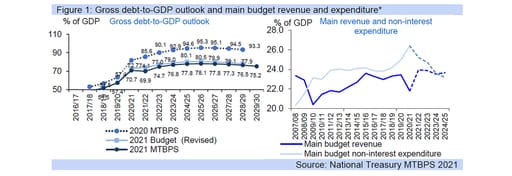
While hardly qualifying as a "windfall" mini-budget, Enoch Godongwana debut MTBPS highlighted South Africa's improved fiscal metrics, which reflect better tax revenues, thanks largely to the current commodity boom, as well as the upward revision of GDP by Stats SA.
Gross debt is projected to stabilise at 78.1% of GDP in 2025/26. This compares to February's projection of 88.9%. The improvement is not due to any major drop in borrowings, however, but rather to the higher GDP figure resulting from Stats SA's revisions.
It's good news nevertheless: enough, we believe, to avoid sovereign credit rating downgrades from Fitch and S&P in November. Both agencies have SA on BB- currently, but Fitch continues to have a negative outlook, with Moody’s at one notch up. But though the agencies are unlikely to downgrade SA in November, they will keep close watch for signs of any rise in debt servicing costs.
The rand strengthened to R15.19/USD following the statement, as SA’s credit risk, which is the perceived risk of default, has slightly moderated. The sheer quantum of debt however is still projected to climb further, with debt projected to increase to R5.5trillion in 2024/25 -- doubing from R2.8trillion in 2018/19.
This still represents a decline in fiscal health. As borrowings continue to rise, the economy will not benefit from any credit rating upgrades, nor are we likely to see the negative outlooks of the two key agencies removed. Debt service costs (interest expenditure) are projected to peak at 5.4% of GDP in 2025/26 and gross debt at 78.1%, with bonds strengthening somewhat.
But the projections won't hold up if there are further crises which depress revenue and increase expenditure. Key risks include further social unrest of the kind seen in June and the intensification of loadshedding. Consequently, the MTBPS affirmed that over the next three years, spending will remain restrained. Government will avoid permanent increases in departmental or programme baselines, or further bailouts of state-owned companies, which would compromise fiscal sustainability.
Instead, short-term tax windfalls will be targeted to reduce the budget deficit and fund temporary priorities, such as extended support for poor households and public employment. In line with government’s commitment to support vulnerable households, particularly given the impact of Covid-19, additional resources for social relief will be considered if the fiscal situation improves.
The focus, in short, is on fiscal consolidation and social stability, as well as economic reforms to drive growth and employment. In particular, the minister pointed to diversifying energy generation, releasing broadband spectrum, opening third-party access to the freight rail network, the eVisa system rollout, reviewing the legal regime governing skilled migration, and accelerating infrastructure investment.
The budget deficit for 2021/22 is forecast at -7.8% of GDP, versus National Treasury’s base rate (BR) projection of -9.3%, and thereafter drops to -6.0% of GDP for 2022/23 (BR -7.3%) and -5.3% in 2023/24 (BR 6.3%).

MTBPS Preview: lower debt and fiscal ratios on the cards
28 October 2021
Minister Godongwana is expected to continue on his predecessor’s path towards fiscal consolidation and growth stimulation
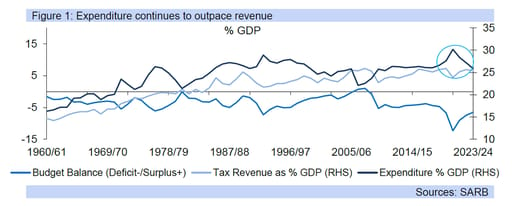
When new finance minister Enoch Godongwana delivers his first Medium Term Budget Policy Statement (MTBPS) on 11 November, the focus of markets and credit rating agencies will be on fiscal metrics and whether or not the rand value of borrowings and deficits rises.
We expect gross loan debt will come out at 70.0% of GDP for 2020/21, versus the 80.3% of GDP projection in the February 2021 Budget. The latter preceded recent revisions to GDP numbers, and the declining ratio was due largely to this, rather than a drop in borrowings.
For the current fiscal year, we expect a debt:GDP projection of 69.8% of GDP (2021 Budget prediction was 81.9%) both on the substantial growth and upwards revision in nominal GDP, with the upwards revision to the size of the economy itself creating a larger base to grow off.
The following three medium-term years, of 2022/23 to 2024/25, we forecast now at 73.0%, 74.5% and 75.7% of GDP, versus the original National Treasury projections of 85.1%, 87.3% and 88.5% of GDP.
The favourable move in the GDP numbers and debt ratio may be enough to avoid sovereign credit rating downgrades from Fitch and S&P in November. Both agencies have SA on BB- currently, but Fitch continues to have a negative outlook, with Moody’s at one notch up. Key also will be projected expenditure increases, with a form of basic income grant likely.
The budget deficit for 2021/22 is expected to be projected near -7.9% of GDP (versus National Treasury’s BR projection of -9.3%) after 2020/21’s -11.7% (BR -14.0%), and thereafter to drop to a projection of -5.9% of GDP for 2022/23 (BR -7.3%) and -4.5% in 2023/24 (BR –6.3%).
The IMF and the World Bank have revised up their growth forecast materially for South Africa this year, along with the economic consensus, predicting that the economy will grow by around 5.0% versus National Treasury’s prior expectation of 3.3% y/y We also expect growth of 2.5% in 2023, versus the prior national treasury’s prior forecast of 1.6% y/y, and accelerating GDP growth thereafter.
The higher economic growth outcomes and outlook suggest that revenue collection will be higher than previously expected, which has also aided our reduction of the likely deficit projections. Underlying debt sustainability will see some benefit from a larger economy and a faster growing economy, but can quickly be eroded by rising expenditure.
Expenditure pressures have risen materially this year on the additional social welfare support after the riots and the Sasria shortfall government is compensating for. In the longer-term a form of basic income grant (BIG) is likely for the high degree of jobless adults in SA, although this could be tied to a need for active job seeking.
The social distress grant, reinstituted after July’s riots, is not expected to be permanent, and is expected to be replaced by a form of basic income grant (BIG) as mentioned above.
There are 7.8million unemployed and 3.3million discouraged job seekers, bringing the cost of a R350 BIG potentially to R46.8bn a year, or R32.9bn a year without including the discouraged job seekers, and both without any additional administrative costs.

Economies experience the impacts of the unwinding from the effects of Covid-19
15 October 2021
As economies, policy measures and markets continue to unwind, or experience the impacts of the unwinding from the effects of Covid-19, volatility persists, as does some uncertainty.
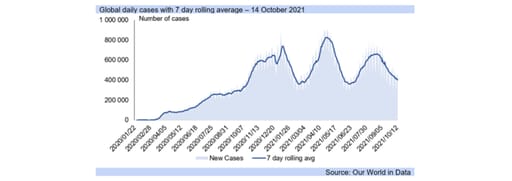
Globally, Covid-19 cases continue to decline, with the seven-day rolling average at 402,944, the lowest since April this year, while global deaths are seeing slower moderation, at 6,689 a day (seven day average), comparable to November last year, or February 2020’s brief spike.
However, daily deaths attributed to Covid-19, on a seven-day rolling average (or 7/day average), remain below the lowest point of deaths reached between the second and third wave of Covid-19 globally, which saw 7,686 as a low point.
A fourth wave of Covid-19, both locally and globally is expected, but will also need a driving factor, and in particular the development likely of a new variant, or a current one which sees a virulent spread.
The Centre for Disease Control in the US has ten variants of interest and/or concern it is still monitoring, from Alpha to Mu, and has a category for a variant of high consequence (VOHC) where prevention measures have reduced effectiveness, but no variant in this category.
While a fourth wave is not a definite, it is seen as very likely unless vaccination rates rise rapidly globally. US Covid-19 attributed deaths are still seeing an elevated level, although declining trend, at 1,627 (7/day average), well above 188 between its second and third waves.
That is the US is well off its third wave peak of 2,087 Covid-19 fatalities (7/day average) experienced in September, and is expected to see further decline, although still a high rate globally, with the UK at 113, South Africa 57, Germany 54, France 32 and Australia at 15.
Overall, the improvement in global Covid-19 numbers, and vaccination rates, since the start of the third wave in June certainly support future further recovery in economies, and an easing in supply chains and so inflationary pressures to some extent.
However, energy shortages (and high prices) globally are a restraining factor, and show increasing risk to economic growth just as rapid climate change shows increasing risk to the sustainability of livelihoods and lives, with low-income economies the hardest hit.
The unwinding, and expected unwinding, of support measures has brought volatility to the markets, with the Fed still expected to taper this year, although the chance of this occurring in December instead has seen the volatile rand at R14.70/USD today, and stronger.

Economies are in various stages of recovery from restrictions
8 October 2021
While economies are in various stages of recovery from restrictions on their activity as the pandemic spread, high inflation is only expected to subside markedly in 2022, with pressure now on monetary policy.
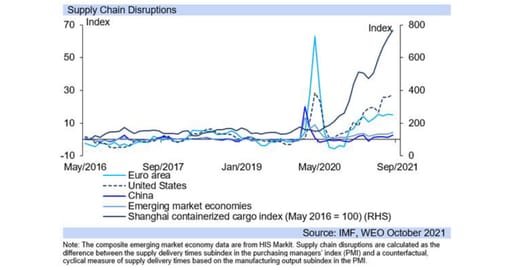
Globally cases of Covid-19 have subsided in the third wave, although some countries such as the UK and Australia have yet to see this occur, with vaccination rates still uneven between economies; and the IMF believes risks to global recovery are increasing.
In particular, it warns “most emerging and developing countries will take many more years to recover. This delayed recovery will make it even more difficult to avoid long-term economic scarring -- including from job losses” and cites the “vaccine divide” as a key concern.
“The risks to a broad global economic recovery are rising due to a persistent divide in vaccinations, accelerating inflation and burgeoning debt that all threaten to leave developing countries far behind.”
The sharp acceleration in inflation on restarting global supply chains as Covid-19 waves wane and high input prices, is only expected to decelerate markedly in 2022. The IMF warns of risks of even higher inflation, including the risk of a de-anchoring of inflation expectations.
This later point is likely to be key in Central bank monetary policy considerations around the world as the pandemic is seen to have subsided. South Africa’s Reserve Bank (SARB) recently emphasised risks to domestic inflation in its October MPR (Monetary Policy Review).
In particular, the SARB highlights that a stronger economic recovery than it anticipated occurred in H1.21, versus the lockdown impacts on 2020, and "underlying price pressures may be stronger than initially thought", with the medium-term inflation outlook rising sharply.
The SARB adds that while SA’s “headline inflation remains contained and core inflation modest, there are several material upside risks. Global food prices look set to remain elevated, posing a risk to domestic inflation despite the expected bumper harvest in 2021.”
“Rising global inflation and supply constraints could drive up imported inflation, with the impacts exacerbated potentially by rand depreciation.” The SARB particularly worries about inflation and points to a likely “earlier start to normalisation in the advanced economies”.
Monetary policy authorities are generally sounding more hawkish and the SARB has been indicating it could hike rates by November already, which could tie in with US QE tapering, even though SA’s economy has not recovered to 2019 levels and unemployment is very high.

South Africa’s Covid-19 third wave has passed
30 September 2021
With the curve dropping down to levels before the second and third waves, and focus needs to turn to lowering restrictions to support economic activity.
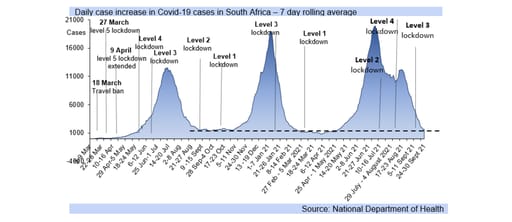
While South Africa is officially out of the third wave, and government reports that the positivity rate has fallen to 0.5%, there is inertia on a further easing of lockdown restrictions, with some worries on the vaccination rate, which is at 16.4% now for full coverage (fully vaccinated).
So far, 17.3million vaccinations have been administered in South Africa, with everyone eighteen and over eligible, and government currently awaiting trial results for over twelve-year-olds. Vaccine hesitancy remains a huge impediment to full vaccination in the country.”
South Africa has seventeen million children who are fourteen years old and younger, in a population of sixty million, and 4.9 million aged fifteen to nineteen, with about 37 million people able to still be vaccinated, excluding refugees, asylum seekers and visitors.
However, the majority of individuals who want to be vaccinated appear to have been, given the low volumes at vaccination sites, with innovative rollouts into some stores, welfare (Sassa) queues and many other areas to encourage higher coverage.
Furthermore, this weekend “Government and Civil Society join hands and resources for Vooma Vaccination Weekend”, on Friday and Saturday, 1 and 2 October 2021, in a nationwide vaccination drive, with “pop-ups … open … in all corners of the country.
Government adds, “the public and private health sectors, organised labour and business and community- and faith-based formations will join forces in the vaccination drive themed Vooma Vaccination Weekend.”
“This will be the first Vooma Vaccination Weekend in a series of outreaches under this banner in which leadership from across the political spectrum, civil society, traditional leaders, labour and business will mobilise communities to stay safe by being vaccinated.”
The state is doing a huge amount, as are many members of society, to raise the vaccination rate through the population, and some companies are making vaccination mandatory. However, disinterest and distrust remain key stumbling blocks.
SA’s low vaccination rate (the global coverage rate is 41%) is also negative for tourism, which has high job generation potential and matters for all tourists, including well-heeled foreign tourists which bring in large amounts of spend to the economy, and so support employment.

SA’s non-farm payrolls drop
28 September 2021
Non-farm payrolls outcome drop by -86k (-86,000) in Q2.21. driven by a large fall in part-time civil servants’ employment, with ghost workers identified.

Today’s release of the Quarterly Employment Survey (QES) from Stats SA looks at employment from the perspective of the payroll of over twenty thousand VAT registered businesses in South Africa and so covers the formal sector. It also excludes the agricultural sector and employees in households, in order to yield a non-farm payrolls outcome for South Africa, which fell by -86k (-86 000) in Q2.21.
Fifteen thousand jobs were lost in the manufacturing sector, seven thousand in construction and sixty-five thousand in community services, under which the government sector falls, with provincial and national government departments recording notable falls in staff numbers – eighty-seven thousand part-time employee jobs were lost while twenty-two thousand full time jobs were gained. Furthermore, easings of individuals in this category (community services) rose by R454million.
Government has been cleaning up its payrolls, deleting ghost workers (individuals on the system who cannot be accounted for in reality, often a form of corruption), with a recent report of thirty-six thousand ghost employees in one province alone (Northwest) according to the premier.
Bonus and overtime payments of R61bn were recorded in Q2.21, again with the bulk made up by the sector government falls into, community services, at R18.7bn, while taxpayers in the business services sector saw a drop of -R9.8bn in Q2.21 versus Q1.21, which will negatively impact government tax revenues. Overall, for the economy, bonus and overtime payments fell by -R7.3bn in Q2.21. The transport sector saw the most paid in bonuses and overtime, at R3.2bn in Q2.21.
Employment remains well below 2019’s levels, on the harsh rest to the economy from the lockdown restrictions applied in 2020 in the second quarter, as extreme harm was caused to economic activity.
Total employment is down by 6.5% in Q2.21 compared to Q4.19 which was the last quarter unaffected by the extremely harsh Covid-19 lockdown restrictions imposed by the government in March 2020.
The manufacturing industry saw its sixteen thousand job losses from full time employees, versus a one thousand part time employee gain, taking it to fifteen thousand losses overall in Q2.21. The manufacturing industry has been hard hit by the lockdown, surging transport costs globally, high commodity prices and heavy government rules and regulations which have increased over the past decade, the latter reducing business dynamism and so activity.
The construction industry was worse hit on a switch in labour dynamics basis, as eleven thousand full time employees were lost and four thousand part-timers gained, yielding the seven thousand lost overall as this industry has been particularly hard hit by the lockdown restrictions and ongoing partial or full closure of councils retarding the approval of plans and so construction activity.
Slow productivity also impedes plans approvals, and so hiring and construction activity.

SARB keeps rates unchanged
23 September 2021
The SARB’s monetary policy committee keeps rates unchanged at 3.50% even as inflation looks set to increase, at least in the short term.

The SARB’s monetary policy committee (MPC) unanimously decided to keep the repo rate unchanged at 3.50% for now. However the implied policy rate path of the SARB’s Quarterly Projection Model (QPM), which is highly dependent on new data and risks, “indicates an increase of 25 basis points in the fourth quarter of 2021 and further increases in each quarter of 2022 and 2023”.
The SARB’s inflation expectations for this year have increased slightly to 4.4% (from 4.3% previously), while its 2022 and 2023 projections remain unchanged at 4.2% and 4.5% respectively.
Overall risks to the short-term inflation trajectory remain. “Global producer price and food price inflation have surprised to the upside in recent months and could do so again”, according to the SARB, although Agbiz does still expect food price inflation to moderate on the “possible softening in grain-related products, dairy and vegetables, " while the outlook for meat prices “remains uncertain for now”. Another risk to the short-term inflation outcome is the oil price which picked up notably after dipping in August and remains volatile. Additionally, the persistent risk of electricity and other administered prices remains.
Longer-term risks to the inflation trajectory include higher domestic import tariffs, rising wage demands and a softer rand. Althought the domestic currency has appreciated nominally by 1.5% against the US dollar for the year to date, it has depreciated on a trade-weighted basis by 1% since the July MPC meeting. Accordingly, the implied starting point for the rand forecast has been revised to R14.47 against the greenback, from R14.40 previously.
The IMF’s global growth forecast of 6.0% will be revised in October. Rising infection rates in a number of countries could weigh on the outcome. Global growth continues to remain uneven with emerging markets lagging developed economies, prejudiced by slower vaccination rollouts and limited fiscal stimulus.
South Africa’s economy has been buoyed by favourable commodity prices, however it remains fragile. The looting and social unrest that occurred in July along with the tighter lockdown restrictions will weigh on Q3.21’s GDP outcome. While the SARB’s GDP forecast for 2021 has been revised upwards to 5.3% y/y from 4.2% y/y previously, growth expectations for 2022 and 2023 have been lowered to 1.7% y/y (from 2.3% y/y) and to 1.8% y/y (from 2.4% y/y) respectively. Indeed, the events that took place in July, coupled with the devastating effects of the pandemic generally, “are likely to have lasting effects on investor confidence and job creation, impeding recovery in labour-intensive sectors hardest hit by the lockdowns”.
The SARB continues to evaluate the risks to the medium-term domestic growth outlook to be balanced, “as most of the bounceback from the recovery is now in the past”. Elevated export prices are expected to wane, while SA’s elevated unemployment rate and low labour absorption rate will continue to constrain household expenditure (which accounts for 60% of GDP). Additionally, electricity supply constraints and the potential for further waves and lockdowns remains a risk to economic recovery.

Waning global Covid-19 numbers of new infections
23 September 2021
FOMC signals that tapering is not far off and strong aversion of many populations to lockdown restrictions, shows the growing wish to put the pandemic behind us.
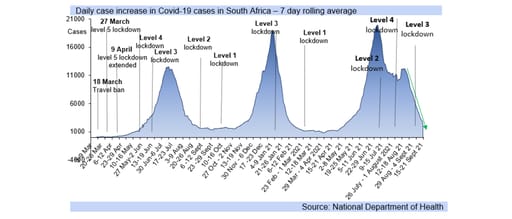
South Africa’s ongoing plunge in its seven-day rolling average of new Covid-19 cases indicates that a move to level 1 restrictions in the country will not be far off, if the curve continues to collapse, with early October likely.
The US, in comparison, is not faring as well, and has still not seen its third wave peak, while deaths from Covid-19 continue to climb, and the number of individuals in ICU is still near the second wave’s highs, and not subsiding, negatively impacting its growth outlook this year.
Vaccinations in the US have finally reached 60% (in forty-five places) full coverage (the UK is at 70%), while South Africa is at 16%. South Africa has seen a particularly harsh third wave, with many deaths and this has knocked business, and consumer, confidence too.
Australia has seen a third wave over triple the peak of its second wave (although it is not certain that its third wave has peaked), and deaths are still climbing, but the population has shown very clear discontent with the lockdown restrictions.
Anti-vaccination sentiment has slowed the rollout of vaccines in many countries, as well as increasing the risk of the creation and spread of variants, with the virulent delta variant driving much of the third wave around the globe, and first identified in India.
Low vaccination rates in populations risk variants developing and spreading. Egypt has vaccinated only 6.5% of its population on a full coverage basis (also Bloomberg), and recently moved off the UK red listed counties, to amber (SA remains on the UK’s red list).
Kenya, also migrating off the US’s red list in early October, has a total coverage vaccination rate of its population of 3.6%. Bangladesh at 11.6%, and also leaving the UK’s red listed countries from early October, along with Pakistan at 18.3%, are close to SA’s 16%.
The other countries to migrate off the UK’s red list in early October are the highly vaccinated islands of the Maldives (97.3%), and Turkey (64%), Sri Lanka (57.6%) and Oman (55.3%), which opens up substantial tourism and revenue to the migrating countries.
Travellers who are not fully vaccinated with authorised vaccines will still have to self-isolate on returning to the UK for ten days, even from non-red list countries, and measures against the non-vaccinated are beginning to be tightened up globally in many ways.

SA could see level one in October
17 September 2021
With the third wave over in Gauteng and declining elsewhere, October could bring a further easing of restrictions and much-needed relief to the battered economy
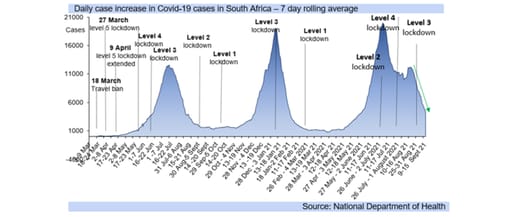
Although the global recovery is well underway, driven by a rebound in the world's largest economies, low vaccination rates continue to impede growth in developing countries.
For the most part, higher income countries tend to have relatively high vaccination rates, with Australia and New Zealand -- both still below 50% fully vaccinated -- the obvious exceptions. The US has now reached 60%. However the global vaccination rate is only 38.1% and South Africa's fully-vaccinated population stands at just 15%.
India, with a population of 1.4bn is only at a full vaccination (coverage) rate of 28%. Indonesia, the fourth most populous country in the world is at 22% and of Nigeria's population of R200m, the world's seventh-largest, only 1% are full vaccinated.
UNCTAD warns that "the biggest risk for the global economy is that a rebound in the north will divert attention from long-needed reforms without which developing countries will remain in a weak and vulnerable position”.
The UN agency further highlights, along with the IMF, the danger that "talk of a post-Covid world distracts policymakers from the need for continued support to poorer nations, many of which still lack vaccines.”
Most African countries are at full vaccination rates of below 10%. UNCTAD and the IMF both note that policymakers in advanced economies have been slow to appreciate the size of the shock in developing countries, or its persistence.
"The pandemic has often been seen as an opportunity to 'build back better' and rethink the principles of international economic governance. But the chances of that happening risk slipping away again, as after the global financial crisis.”
The IMF, World Bank Group, World Health Organization and WTO warn that without urgent action, even the modest goal of vaccinating at least 40% of the population by the end of the year will prove unattainable.

MPC preview: SA repo rate unlikely to change
15 September 2021
SARB Governor's message to Parliament is that inflation will likely remain contained around the 4.5% midpoint target
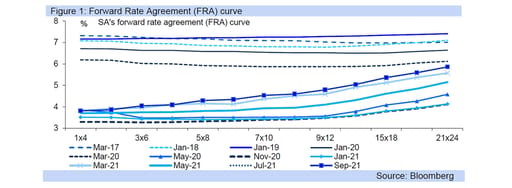

South Africa’s lengthy third wave may have extended the timing until the fourth
10 September 2021
The fourth was is expected as early as January, it will be variant dependent with vaccination levels still too low to prevent it.
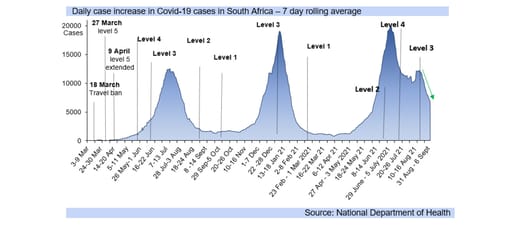
South Africa’s third wave has proved more severe than the first two but has also seen less harm vested on the economy, with more sensible lockdown restrictions. However, but the harm done from the first lockdown on employment is still in the system.
While lockdown restrictions are expected to fall to level two fairly soon, the real changes needed to repair the damage to employment in SA, both from lockdowns and the lost decade of the 2010s, is structural reforms, which remain too slow.
All provinces have now seen a subsidence in their seven day rolling averages of new daily Covid-19 infections, as South Africa’s third wave is working its way out the system, with the number of new deaths each day recorded from Covid-19 notably easing as well.
South Africa’s total seven day rolling average of new Covid-19 infections has dropped to 6,662 from 8,776 last week and 11,706 a week before that, while Gauteng is down to a seven day rolling average of 514, the Western Cape 1,347 and the Eastern Cape 1,245.
Kwa-Zulu Natal has the highest cases still, at 1,757 on a seven-day rolling average, with the other provinces below 1,000. Vaccinations administered are at 14.3 million, covering 13.8% of the population, with an estimated sixteen months now to 75% coverage (Bloomberg).
Vaccine fear, hesitancy to just outright disinterest continues to be the major factors impeding SA’s vaccine rollout, with insufficient vaccines likely delivered in time to prevent a fourth wave of infections in SA, which could now make itself felt as early as January.
The lengthy period of the third wave has pushed out the timing of SA’s likely fourth, although this will also be highly dependent on the timing of a virulent variant. The third wave is being driven by the delta variant, and SA’s second wave by the beta variant.
The World Health Organisation’s (WHO) current variants of concern (VOC) are alpha, beta, gamma and delta, and variants of interest (VOI) are eta, iota, kappa, lambda and mu, although the WHO is tracking these to determine if any should become VOCs.
The most recent identified VOI was mu on 30th August 2021, and retains some risks of developing into a VOC. The delta variant became a variant of concern on 11th May 2021, just over a month after becoming one of the WHO’s variants of interest on 4th April 2021.

Its not just the riots suppressing business confidence
9 September 2021
Low government productivity continues to impede higher levels of business activity

The RMB/BER business confidence index (BCI) dropped to 43 in Q3.21, meaning that 57% of businesses were depressed with prevailing business conditions. KwaZulu-Natal fell from 77% to only 27% satisfied with prevailing business conditions due largely to July’s riots (the responses were surveyed between the 11th and 30st August).
While some of the early economic indicators for August show that the impact of the riots in July are starting to be overcome, and others for July show somewhat less of a marked impact than may have been feared, this is irrelevant for the high unemployment rate in SA and growing joblessness which is a longer-term factor.
The extremely high unemployment rate in South Africa, of 34.4% is wider for those fifteen to thirty-four years of age who are unemployed and not undergoing education or training, at 45% - or around nine million individuals. There are close to seventeen million South Africans of zero to fourteen years of age, 28% of the population, and the population growth rate in this segment has soared over the past decade. SA has a population of sixty million.
However, prospects of employment are weak with close to eight million fifteen years old and older unemployed, or eleven million including those who have given up seeking work (the discouraged). It is consequently hugely problematic that businesses efforts to expand and employ more are blocked by government’s slow productivity such as the backlog of prospecting mineral licenses, permit renewals etc. With many prospective mines in rural areas, government has to rapidly spark private sector employment by eradicating backlogs of mineral prospecting licenses (and renewing permits), as well as approvals for building projects at councils to boost employment in the construction industry. These industries train and upskill workers – which is vitally needed in SA.
However, government also needs to cease importing labour from other counties such as Cuba and India when SA has its own engineers, IT skills and many other unemployed university graduates. Absent better government policies which actively support all South Africans in business and jobs creation, and in all sectors, SA will not return to the low unemployment rate of 21% achieved by the Mbeki inclusive growth years (despite denialism (absent recognition) of this to further factionalist agendas), nor will SA’s unemployment rate drop lower towards single digits as SA was on track to see under Mbeki’s government before his presidency was prematurely ended.
While some private sector participation has begun, this needs to be widespread, and blockages to private sector service provision and general business activity needs to be eradicated – the size of the private business sector must triple to absorb the unemployed, not be constrained by state controls, interventions and poor state productivity, and growing size of the state. SA is already in an extreme unemployment crisis.

Weak uptake impedes SA's vaccination progress
3 September 2021
The third wave is moderating, but low vaccination rates raise the risk of more resistant variants
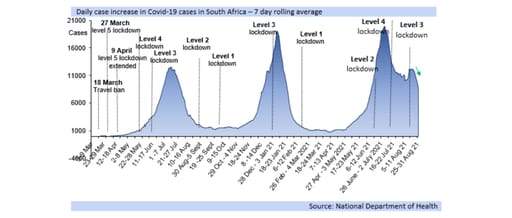
Infection rates in KwaZulu-Natal, the Eastern and Western Cape have decreased (on a seven-day rolling average basis). Gauteng’s rates are down dramatically, while the Northern Cape, North West Province and the Free State are moderating.
Overall, South Africa’s seven day rolling average of new daily cases of Covid-19 infections has moderated noticeably, to 8,776 from 11,706 a week ago and 12,021 a week before that, after seeing a second, small, spike three to four weeks after July’s riots.
Deaths from Covid-19 in South Africa are still fairly elevated, but showing potential signs of moderating, although the third wave is proving lengthier, and seeing less of a material decline at the same point of the second wave - the current wave is lasting longer than the first two.
Indeed, the third wave is still at very elevated levels, and not at a level appropriate to lessen social restrictions, while there is no certainty at all it will fall rapidly enough by 27th October to allow municipal elections to be held with safety.
With the national state of emergency extended to 15th October, it is still uncertain whether the municipal elections will go ahead in October. SA could “look forward to” reduced lockdown regulations if infections decrease or stabilise, the Health Minister is reported to have said.
Reportedly adding on the vaccination front, that government is “looking at soft incentives. People are hungry for entertainment", "for instance, we are saying so many people can go to soccer stadiums if they are vaccinated.”
And the “priority is to mobilise people to come forward voluntarily and take the vaccine,” with a vaccination rate of over 90% for over thirty-fives touted as the rate needed to avoid a fourth and fifth wave – SA is currently at 12.7% with 13.1million vaccines administered.
Bloomberg estimates it will take twelve months from today for South Africa to reach a vaccination rate of only 75%. South Africa’s fourth wave is expected by the end of the year, and could well be heavily aided by the municipal elections going ahead.
The new variant of interest in SA, C.1.2., is, as variants are, a result of a high rate of non-vaccinated individuals in a population. 87.3% of South Africa’s population is not vaccinated. Researchers do not know yet if C.1.2. is more contagious or deadly than other variants.

SA's third wave is proving very sticky
27 August 2021
Last year's harsh lockdowns see salary levels still well below Q1.20's and unemployment has shot up, providing a truer reflection of the impact of lockdowns on jobs
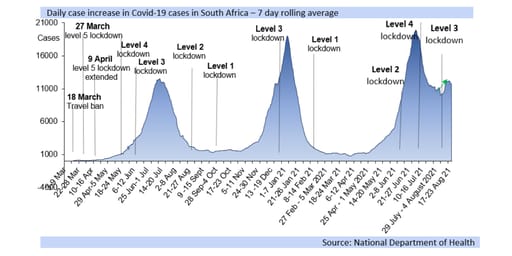
South Africa’s seven day rolling average of new daily cases of Covid-19 infections has moderated slightly again, to 11,760 from 12,021 a week ago and 10,187 a week before that, after seeing a second small spike, with upwards pressure coming from a number of provinces.
The Eastern Cape is now showing average weekly cases two and a half times above where it was a month ago, following the Western Cape higher, with the Northern Cape and Free State, also neighbouring provinces, following suit, adding to the uncertainty.
While the Gauteng statistics continue to see a strong declining trend, the high transmissibility of the delta variant is proving to prolong the third wave, as do events where a vast many congregate such as protests, and now there are worries over the October municipal elections.
Deaths from Covid-19 in South Africa are elevated currently, and while not reaching the peaks of the second wave, they are proving more lengthy and seeing less of a material decline, as the current wave proves longer lasting than the first two.
Given the devastating damage to household finances, government finances and the economy overall from the Q1.20 lockdown, further substantial tightening in restrictions is not expected, and the risk is that Covid-19 could be with SA for many years.
Vaccinations are currently at 11.6 million in SA, at close to 12% of the population fully covered (Bloomberg), and while low-income economies are well below this, relatively low vaccination rates do encourage the development of new variants.
Bloomberg now estimates it will take a year for SA to reach a vaccination rate of 75%. The slow, and interrupted, pace of the descent of the current third wave is pushing out the likely start of South Africa’s fourth wave towards the end of December.
However, there is greater uncertainty this time around, and it is in significant part due to the very high transmissibility of the current delta variant, which is still working its way through a number of provinces, and there is no certainty the nation’s curve will decline imminently.
The death rates are not yet showing notable decline either, and such is the danger of new variants, with many more still possible if vaccination rates across the globe do not rise rapidly, it is insufficient for just a few countries to have high levels of complete vaccinations.

New set of statistics pushes up our GDP forecast for this year
25 August 2021
Increasing the size of the economy reduces future government’s debt and deficit ratios and pushes up our 2021 growth outlook
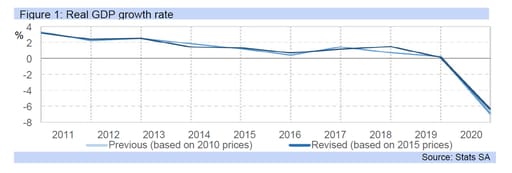
Statistics South Africa published a new set of statistics for GDP after its normal five yearly rebasing and benchmarking exercise, which pushes up our GDP forecast for this year to 4.2% y/y, on higher weightings to faster growing sectors, and upwards revisions to the Q1.21 outcome.
The new GDP figures lowers gross debt to 71.1% for 2020/21 from the previous 80.3% of GDP, lowering the 2021/22 estimates too, to a gross debt ratio of 73.5% from the previous forecast in the 2021 Budget Review in February of 81.9% of GDP, and for 2022/23 to 76.4% (February estimate 85.1%) and 2023/24 to 78.4% (previous estimate 87.3%).
In addition, the GDP revisions also serve to lower the budget deficit ratio to -12.4% of GDP from 14.00% for 2020/21, and to -8.4% of GDP (February estimate -9.3%) for 2021/22, and for 2022/23 to -6.6% of GDP (previous estimate -7.3%) and 2023/24 to -5.7% (from -6.3%), but again assuming no additional expenditure.
This will be pleasing to the rating agencies, but still shows rising debt as opposed to stabilisation, and also assumes no additional borrowing. SARS recently said greater revenue collection compared to that budgeted is expected to adequately cover the cost of fiscal assistance to lessen the recent riot’s impact.
Specifically adding that, Q2.21 saw significant growth in commodity prices which will have benefited both exports and tax revenues, while VAT and corporate tax collections grew faster than expected as well covering the cost of the vaccines and riot relief without having to resort to borrowings.

Third wave in SA has proved volatile, spiking up this week
20 August 2021
Western Cape and KZN climb on the highly contagious delta variant with fatalities elevated as well
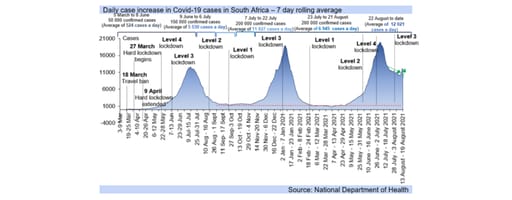
South Africa’s seven day rolling average of new daily cases of Covid-19 infections has risen sharply, to 12,021 from 10,187 a week ago, now back at the level of the last week of July, as the third wave continues to prove uneven through provinces.
The risk is that this national spike gains momentum, with the Eastern Cape now showing worrying evidence of following the Western Cape. The Northern Cape and Free State, also neighbouring provinces, are seeing a steepening in their curves.
Limpopo and Mpumalanga are showing a small upturn, having followed Gauteng in their initial third waves. The country has officially recorded 2.7million cases of Covid-19 since early last year, out of a population of 60 million.
KZN also replicated Gauteng’s third wave to a lessor extent as Mpumalanga and Limpopo did, and then embarked on a more rampant second leg of its third wave, which is the risk for the other provinces.
Fatalities from Covid-19 are particularly elevated in the Western Cape, and seeing a protracted and severe trajectory, with the initial slow rollout of the vaccine nationally heavily to blame, along with vaccine hesitancy circulating as well through SA and globally.
So far, South Africa has administered 10.2million vaccines and has a 10.4% coverage rate of its population, i.e. the number of doses required for each type of vaccine administered to provide full coverage (Bloomberg).
The opening up of the vaccine to the age group 18 to 34 has seen huge take up today as ‘pro-vaxxers’ desperate to get jabs join many long queues in relief to get the potentially life saving vaccination, a necessity given the virulency of the delta variant.
With far too many deaths, Covid-19 fatalities are recorded at 78 694 officially but health experts in the field estimate it may be three times this, getting a longed for vaccine shot raises sentiment enormously for those vaccinated and is positive for the economy and SA’s outlook.
Despite quickening its vaccination pace over the last few months, South Africa is nevertheless at a dangerously low vaccination rate in order to effectively combat the highly contagious delta variant that is driving its third wave, and saw too slow a start its vaccination.

Covid-19 infections now decelerating in both Gauteng and the Western Cape
13 August 2021
Deceleration prompting a sharp drop off nationally, although KZN continues to trend up post its very severe riot action.
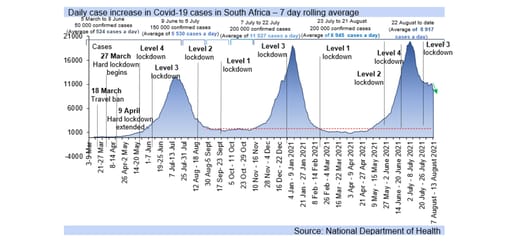
Cheeringly, South Africa’s seven day rolling average of new daily cases of Covid-19 infections have dropped to 8,917 from 10,768 a week ago, and 11,403 a week before that (12,727 a week before that), having peaked at 19,956 in early July.
The national curve had very worryingly slowed its descent, and even moved up somewhat following the violent riots which began in KZN, and then were incited to a lessor extent in Gauteng, and only recently has the curve dropped off again.
Many only end up having tests in their second or third week of Covid-19 infection if they ignore it initially but then become severely ill, and the KZN infection rates rose sharply for three weeks after the insurgency, and have risen further on recirculation.
So far, South Africa has administered 9.2million vaccines, in a population of 60 million, and differences in vaccine administration rates continue across the world, with the UK at 65% coverage of its population and the EU and US around 55% (Bloomberg).
South Africa is below 10% along with Guatemala, Iran, Botswana, Venezuela, Tajikistan, Nicaragua and Georgia, while Zimbabwe is just above 10%, as is Equatorial Guinea, Pakistan, the Comoros, the Philippines and Bosnia and Herzegovina.
The IMF highlights that “multilateral action is urgently needed to close gaps in access to vaccines and bring about an end to the pandemic.” Absent which, a high degree of loss of lives and new variants will likely occur, reducing the outlook for economic growth.
The IMF warns, “differences in vaccine access and the ability to deploy policy support are creating a growing divergence between advanced economies from many emerging market and developing economies.”
“Faced with high deficits and historic levels of debt, countries with limited access to financing are walking a fiscal tightrope between providing adequate support and preserving financial stability.” SA’s government finances remain deteriorated well below those of its peers.
South Africa urgently needs to implement growth enhancing reforms and expectations are high that the new Finance Minister will be instrumental in speeding up the pace, which is increasingly critical on the expansion of the SRD grant, and aid for riot damage.

South Africa's Covid-19 recovery set back by KZN riots
5 August 2021
July's unrest reversed the declining trend in KZN while the third wave gathers pace in Western Cape
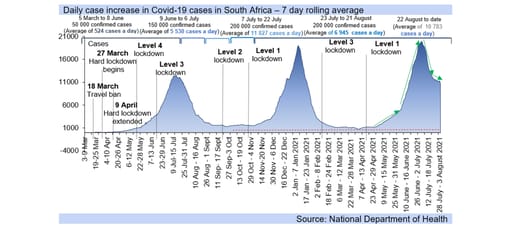
New daily cases of Covid-19 in South Africa have dropped to 10,783, the same rate as early June, with the majority of provinces showing a declining or low, flat trend. South Africa has administered 8.1 million vaccines and fully vaccinated 8.4% of its population (Bloomberg).
KZN was well on its way to a V shaped recovery from its third wave, with cases reaching 1 523 on 12th July, then dropping to 696 by 19th July. But infections then rose sharply in the week following the riots of 11th to 16th. Cases climbed to 1 211 by 23rd July, and have continued to climb since.
The KZN infection rates can be expected to rise for another few days as a direct result of the riots, as many only test in their second or third week of infection if the ilness has not been severe until then. Cases may continue to rise into the third week of August and beyond due to recirculation.
The negative costs of the riots to South Africans’ livelihoods, employment and the economy are still being tallied, with the highly destructive economic sabotage expected to cause a contraction in Q3.21 GDP. Many affected businesses will not recover and jobs will be lost.
Business confidence is expected to plummet, along with employment opportunities in the form of jobs that would have been gained if not for for the violent riots and insurrection led by supporters of Jacob Zuma.
During the decade of Zuma's rule, from 2009 to 2018, the economic growth rate of South Africa collapsed, state capture and corruption escalated rapidly, along with looting of state monies and assets, and governance in many state institutions was severely eroded. The recent actions in support of Zuma have now set South Africa’s recovery from Covid-19 back severely, and escalated the death rate from the disease.
What is needed in response to the destruction of July’s riots is a rapid institution of reforms to drive faster economic growth, and in particular bolster business confidence, was well as a lot more information from government on how it will prevent future insurrections. Thus far, the nation has seen little indication of progress in the critical work of bringing the perpretators of the inurrection to book.
Apart from the immediate priority of restoring safety and security, and preventing further acts of destruction by the insigators of the insurrection, the government must implement with urgency the economic reforms recommended by National Treasury and B4SA. These reforms, focused on the rapid expansion of the private businesses sector, are critical to the revival of business confidence.

SA’s seven day rolling average of Covid-19 cases trending down
30 July 2021
South Africa’s seven day rolling average of daily Covid-19 cases is still trending down, but the Western Cape is seeing an acceleration in its third wave, and KZN too after its riots, but Gauteng retains its deceleration.
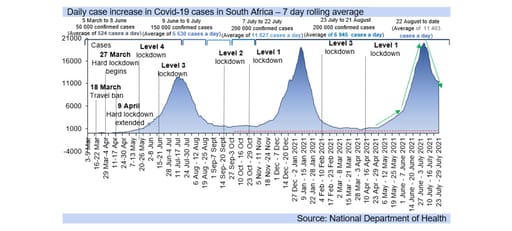
While Gauteng continues a rapid deceleration in its third wave of Covid-19 cases, the lift in the Western Cape and KwaZulu Natal’s third waves temporarily interrupted the downwards trajectory of the country’s curve overall, but the country’s numbers are declining again.
However, KZN has now lost all the gains it made initially in its fight against the third wave before its violent riot action earlier this month and is now back at the first peak of its third wave but is likely to exceed it its cases continue to climb as a result of its insurgency.
It can take up to two weeks or more before positive tests come through, and longer for cases which end in fatalities with no testing before, with KZN also at particular risk in its vaccination drive following destruction of infrastructure and lingering concerns over safety and security.
South Africa has administered 7.3 million vaccines, a 1.3 million jump from last week, speeding up its vaccine rollout, with vaccinations back under way in most sites in KZN and Gauteng and the coverage ratio for the population is now at 7.5% (Bloomberg).
The coverage ratio “divides the doses administered for each vaccine type by the number of doses required for full vaccination”. Government still aims to deliver 35 million doses by the end of the year, using the two dose Pfizer and single dose J&J vaccines .
South Africa is now expected to cover 75% of its population in twelve months’ time, taking it into the second half of 2022, while the global average to reach coverage of 75% of the world population is seen at six months (Bloomberg estimates).
The EU and UK are expected to achieve 75% coverage in two months, the US within seven months, Brazil and Taiwan four months, Columbia five months, Peru, South Korea and Russia six months and India eleven months.
We continue to believe South Africa is at risk of its fourth wave beginning as early as November this year, with a fifth wave in the second half of next year, while vaccine hesitancy is apparent in the population, with significant numbers choosing not to have the vaccines.
With the lift in the country’s seven day rolling average only occurring for one day, Wednesday this week, and Thursday resuming the decelerating trend, there is no need for any tightening of lockdown restrictions, and these would be very detrimental to the current weaker economy.

MPC Review: repo rate unchanged with hike unlikely in 2021
22 July 2021
South Africa leaves its repo rate unchanged at the July MPC meeting, indicating a likely hike in Q4.21, although we currently don't think this will transpire given that the inflation forecast for 2022 has been revised lower.
The Monetary Policy Committee’s (MPC) unchanged stance on interest rates saw the rand weaken, to R14.66/USD, with many EM Central Banks having hiked rates. However, there was pressure coming though from the MPC for longer-term normalisation of monetary policy.
The SARB highlighted that financial market and economic conditions are expected to remain volatile for South Africa in the foreseeable future. Global growth is a concern on the spread of the delta variant, while recent unrest in the country has clouded the economic outlook.
Worries over tighter lockdown restrictions, and the negative impact on global growth in key economies is a particular concern, with commodity prices having weakened, particularly metal prices, which has negatively affected the rand this week.
The SARB lifted its inflation forecast for this year somewhat, to 4.3% y/y from 4.2% y/y, but it is the expected inflation outcome six to twenty-four months out, and particularly twelve to eighteen months out, which influences the SARB repo rate decisions.
While the SARB lowered its 2022 inflation outlook to 4.2% y/y from 4.4% y/y, and left its 2023 inflation outlook unchanged at 4.5% y/y, the midpoint of the inflation target range, it projects hikes in the repo rate this year and next (25bp in Q4.21 and over 100bp in 2022).
It forecasts yet further interest rate hikes over 2023, totalling around 100bp, but adds this is still highly accommodative monetary policy as the differential between inflation and the repo rate only rises to 0.5% by the end of 2023, with a neutral level instead seen at 2.0%.
The economy is unlikely to be particularly robust over 2022 or 2023, and such a 2.25% hike in the repo rate is currently unlikely.
The SARB forecasts weak economic growth of 2.3% y/y in 2022 and 2.4% y/y in 2023. For 2021 it forecasts 4.2% y/y, although this is at risk.
The SARB’s interest rate forecasts from its quarterly projection model change frequently, and the SARB also ignores the projections depending on the conditions in the economy. However, faster economic growth will not be achieved by lower interest rates but by structural reform.
Impasses in policy proposals need to be overcome so that economic growth enhancing reforms are promoted, and SA urgently needs to sees efforts to boost business confidence through cutting red tape and the regulatory burden, and adopting free market policies.

SA's economy will be hit hard by looting and destruction
16 July 2021
Orchestrated destruction of infrastructure and looting will also delay the vaccine rollout and may already have caused a lift in Covid-19 cases.
While much of the widespread looting over the past week was clearly an expression of desperation and criminal opportunism, the South African government has now acknowledged that the unrest was instigated as part of a deliberate campaign to sabotage to the economy and render the country ungovernable. The situation appears to be largely contained, thanks in part to the eventual deployment of the SANDF to the worst flashpoints, but fresh reports have emerged of attempts to attack the country’s key strategic sites.
These sites apparently included the Durban Harbour, electricity sub-stations and power plants, water treatment plants and chemical plants, with sabotage also extending to major supply routes including the railways and highways. In the event, the destruction extended past retail outlets and included factories, funeral homes and actual dwellings as well.
With the police and army slow to respond effectively to the unrest, quelling the rampant lawlessness required the additional efforts of private security companies and community members themselves. Although at its worst the conflict fell well short of actual civil war, risk was certainly there, and violence escalated to near-wartime proportions in some areas.
The violence appeared to be well-orchestrated, with simultaneous actions arising in KwaZulu Natal and Gauteng rather than spreading organically through the Free State, as one might have expected had it been the result of a spontaneous groundswell, and reports have emerged of key instigators fuelling mobs within communities.
In particular, a handful of instigators are reported to have broken down barriers to allow mobs to enter buildings and loot, while urging the destruction of premises, encouraging arson and other acts of destruction early on.
With the success of the initial looting sprees on the weekend widely circulated, the outbreaks became more frequent early this week, on criminal opportunism and poverty combined with clear acts of premeditated violence and destruction.
With South Africa in the midst of a third wave of Covid-19 infections, the unrest could not have come at a worse time. Against the backdrop of communities fearing for their safety, unwillingness to venture out for Covid-19 tests may be assumed, particularly in KZN, and it is difficult to know how reliable the latest official Covid infection rates are.
After dipping to 11 182 a day, new daily cases of Covid-19 lifted to 17 489 midweek, with many at risk from increased infections on the riots. South Africa’s vaccinations have only reached 4.9million doses so far and the riots risk spreading Covid-19.
South Africa is administering just under 200 000 vaccines a day, with the recent unrest having disrupted a number of vaccination sites and slowed government’s efforts, with GDP growth currently likely to come out at 3.9% y/y this year on the hit to the economy in Q3.21.

Third wave may have peaked in Gauteng, risks abound for complacency
9 July 2021
The infection rate is still extremely high, and will not subside instantly, with more deaths to come and vaccinations increasing modestly.
Government is in the process of quickening vaccination rollout from around 100,000 a day, (reaching close to 200,000 yesterday) towards 250,000 to 300,000 a day, although sites fail to keep the momentum going over the weekends, evidencing it is still not a ‘wartime effort’.
At over four hundred recorded deaths a day from Covid-19 yesterday, and four hundred and fifty-seven on Tuesday, this is a ramping up from around two hundred deaths a week ago, as the Covid-19 third wave of fatalities follows infections, with a couple of weeks lag.
Furthermore, deaths currently recorded from natural causes are reported to be particularly high. Many who do not go for testing may succumb to the disease at home instead, raising the overall death rate in the country, but not necessarily being recorded as a Covid death.
Government reported today that “there is an ongoing rise in infections, hospitalisations and Covid-19 related deaths in SA”, and that “in the last 24 hours, 22,910 new cases, were reported, representing a 34.4% positivity rate. Of these, 11,747 were in Gauteng”.
Furthermore, from mid-July, those in the thirty-five to forty-nine-year-old age bracket will be eligible to register for vaccination on the state system, although those heavily affected by co-morbidities are not able to do so alone, and remain very vulnerable to fatality from Covid.
Government adds, “over 4 million people have received at least one dose of the vaccine”, with Bloomberg’s vaccine tracker for 8th July (using 7th July data) showing 6.2% of the population have received one dose and 4.2% are covered in the sixty million population.
Updating the ratio to today’s published four million administered vaccine doses (4,017,442) yields a ratio of 6.7%, and would bring those estimated by Bloomberg to be fully vaccinated from 2.1% to closer to 3.0%, but this is still well below most other emerging market countries.
Poland has covered 81% of their population, Chile 62%, Hungary 55%, Singapore 52%, China 48%, the Czech Republic 38%, Turkey 34%, Hong Kong 28%, Argentina 26%, Brazil 26%, Romania 23%, Columbia 20%, Mexico 19% and the other emerging markets below this.
The quickening in SA’s vaccine drive is welcome. Administering 300,000 vaccines a day would allow SA to reach around 36% covered (on a two-dose basis) by early next year - if SA begins administering 300,000 doses a day from next week (with weekends still excluded).

SA's third wave approaches the peaking level of the second
2 July 2021
Absent new, harsher Covid variants, the move to vaccinate over 50s will help to reduce severity of future waves
South Africa’s seven-day rolling average in new Covid-19 cases has jumped rapidly again, now at 16,916 from 13,009 last week and 9,124 the week before.
In Gauteng, the worst-hit province, the third wave is already far more severe than the first two, with no end yet in sight. Gauteng’s caseload is now above 662,300, up a huge 78,291 individuals in a week from 58,136 the week before. The province's seven-day rolling average in new Covid-19 cases is at 10,613, up from 8,305 last week and 5,737 the week before that.
Nationally, Covid-19 deaths are up to 383 a day, from 166 a day seven days ago, and 77 seven days before that. Although the numbers are volatile, there is evidence of an upwards trend from the end of April, and a spike more recently. The country is broadly tracking Gauteng’s earlier trajectory, although provincial peaks could be lower than Gauteng’s.
The Western Cape is showing a marked quickening in its new daily cases on a seven-day rolling average, now at 1,619 from 1,246 a week ago, and 882 a week before that, as its trajectory mirrors that of Gauteng towards the end of May.
The North West province too is still showing a marked jump up in new daily infections, with 1 025 recorded on a seven day rolling average, from 778 a week ago, and 573 a week before that, also mirroring Gauteng’s trajectory, but earlier in May (around 18th).
KwaZulu Natal also evinces this trend, at 935 new cases on its seven-day rolling average from 599 a week before that, and it is at an earlier stage, and Limpopo at 824 and Mpumalanga this week from 474 and 510 a week before respectively.
The other provinces' current seven-day rolling averages of new infections are below 500, but nevertheless increasing in the main. Recent lockdown restrictions will serve to eventually limit the spread, although it takes around seven days for infections to occur after contagions and two to three weeks for deaths to occur for those fatally affected.
Vaccinations are now just above the three million mark, at 5.2% of the population, still increasing at around 100,000 each weekday.

The third wave continues to build in SA
25 June 2021
Third wave strongly led by Gauteng, with the Western Cape and North West Provinces following suit, with tighter lockdown restrictions for Gauteng a sensible province by province approach.
South Africa’s seven-day rolling average in new Covid-19 cases is at 13,009 up from last week’s 9,124, and 5,959 before that, as the third wave continues to build rapidly in South Africa, with Gauteng’s caseload now at 588,009, up a massive 58,136 individuals in a week.
Mobility data (compiled by Our World in Data) shows a rise in May 2021 in the number of visits and time spent at retail outlets and places of recreation, along with visits to grocery and pharmacy stores and people leaving their homes, tying in with the sharp rise in the third wave.
The google data further shows that there has been a 20% drop-off so far in individuals going into workplaces since the third wave began in South Africa, although this was closer to 70% last year in level 5 lockdown.
Indeed, overall physical attendance at workplaces have remained below pre-pandemic levels overall for South Africa, evidencing that many have remained working from home since March last year, typically down by around 20%.
The duration of time people spent at home in level five rose by close to 40% compared to pre-pandemic (February 2020), and currently is rising to 20%, from closer to 10% above February 2020’s level of time in periods from level 3 restrictions with no covid waves.
This shows that South Africans are managing their exposures to others as the waves of Covid-19 wax and wane, and that visits to parks and transit stations (public transport stations) have been curtailed in particular, although responsiveness is to a lesser extent for workplaces.
With individuals better able to control their freedom of choice in deciding on attending parks and using public transport, as opposed to physically being in workplaces, this indicates more individuals would probably choose to work from home than is being allowed.
Additionally, many visits to grocery and pharmacy stores, as well as places of entertainment and retail outlets are the travels of workers at these places. Nevertheless, there is also indication of a sharp rise in individuals shopping and visiting restaurants etc. versus level 5.
South Africa has vaccinated 2,550,248 individuals (4.2% of its population), up from 1,974,099 a week ago. There is strong evidence of pent-up demand, which will be released into stronger economic growth on approaching herd immunity (75% of the population vaccinated).

Industrial production reflects economic recoveries around the world
24 June 2021
Globally, PMI readings continue to show extremely strong recoveries in manufacturing production
Manufacturing production is ramping up rapidly as the world's leading economies recover from the impact of the pandemic. The resultant higher demand for industrial commodities has seen prices continuing to show good growth, up 83% y/y and 2.1% m/m, with metals prices up 3.5% m/m, 101% y/y (June Economist indices).
Rising commodity also continue to provide support for the rand, despite recent weakness after the US FOMC meeting, which signalled that rate hikes in the US may happen sooner than previously expected. The news spooked markets at first and also saw the rand lose 72c against the US dollar. However, following subsequent placatory comments by the Fed, equity markets began to bounce back and the rand made back 21c.
The rand is very heavily influenced by metals prices, as well as foreign investor portfolio flows and market risk sentiment; the latter being bolstered somewhat last night as Fed chair Powell reiterated the Fed will not raise rates quickly despite inflationary pressures.
The main inflationary impact of higher commodity proces tends is felt in energy and food, both of which moderated in June. The Economist indices show a June drop of -4.0% m/m for food and -5.7% m/m for non-food agricultural prices, which should slow price pressures somewhat in that month, after May’s -2.1% m/m and -7.6% m/m drops. But annual inflation remains high as the basis of comparison is the severely depressed levels experienced at the height of the global pandemic last year.
Overall price increases on a year ago are heady due to these base effects, but strengthening demand has also lifted commodity prices materially, while industrial production for most key economies is at or near historic highs.
June’s global copper users PMI (operating conditions for heavy users of copper) is at its highest level since 2010, with aluminium users PMI seeing the fastest growth also since 2010, as is the steel users’ PMI, with supply chain pressures still a key issue (IHS Markit).
South Africa’s IHS Markit PMI shows production expanded in May, with new orders rising for its manufactured goods, mainly from domestic, as opposed to foreign clients, while confidence on future output was strong -- the highest in three years.

Third wave accelerating sharply amidst sluggish vaccine rollout
18 June 2021
Poor take-up among the elderly is a constraining factor in the pace of the vaccination programme.
South Africa’s seven-day rolling average in new Covid-19 cases is at 9,124, well up from 5,959 a week ago and 1,210 at the start of May, as the third wave now builds rapidly, with Gauteng’s caseload now at 529,873, up a massive 40,162 individuals in less than a week.
The level three restrictions recently imposed are still fairly supportive of both the economy and the need to foster faster employment creation to support livelihoods, while clamping down on social interactions, with the latter key to limiting the spread of Covid-19.
However, limiting indoor gatherings to fifty and outdoor gatherings to a hundred will still not be sufficient to cease the spread of Covid-19, while many are still not heeding the work from home call whenever possible, which is vital to help to prevent new waves
Indeed, many companies showed strong resilience through instituting work from home processes very rapidly, productively and successfully, from late March last year, and this should be maintained where possible to limit the current wave and help limit future ones.
South Africa currently has vaccinated 1,974,099 individuals with at least one dose, 3.4% of its population, but it remains far from the 40.2 million (two-thirds) mark, with only healthcare workers and those over sixty eligible, despite a weak take-up of the elderly for the vaccines.
South Africa needs to urgently speed up its vaccination rate, and allow vaccinations for those over forty-five, particularly for all the individuals who work in essential services, and so are necessary for the successful functioning of the economy.
SA also needs the delivery of vaccines to ramp up, with greater available supply and more administration sites with better management, with some individuals reportedly scheduled to obtain their vaccines over the weekend, but often finding sites closed.
The economy is not going to see a speedy recovery on a slow vaccination rollout process, while microeconomic reforms aimed at increasingly closing SA’s economy to international trade, among other DTI proposals, are negatively impacting business confidence.
Increased localisation without sufficient electricity, water, and supply of other necessary inputs (with production of many raw materials decreased over the past decade) could see sharp price implications, as well as risk shortages, quality, and current jobs and industries.

South Africa’s third wave intensifies
11 June 2021
South Africa’s third wave showing a recent, worrying quickening in pace, to growth of 37.2% week on week (w/w), from 21.7% w/w a week ago, in line with the path of the previous two waves of new infections.
South Africa’s seven-day rolling average in new Covid-19 cases is at 5,959, well up from 1,823 a month ago, as the third wave accelerates in severity, with Gauteng still seeing the highest caseload, at 489,711 overall, and up a massive 24,043 cases on a week ago.
The Western cape is up 3,695 cases to a week ago (298,743 total recorded so far since Covid-19 took hold in SA last year), KwaZulu Natal up 1,898 w/w (overall total 342,291), and the Eastern Cape up 1,161 w/w (to reach an overall total of 199,400).
The Free State and the North West Province have had jump-ups too over the past week, similar to the Western Cape, by 3,226 (to 105,932 cases recorded overall) and 3,171 (to 80,569) respectively, while the Northern Cape rose 2,008 w/w (to 51,782).
The other two provinces are seeing slower increases, respectively Limpopo at 1,026 (taking it to 66,832) and Mpumalanga 1,575 (84,818). Administered vaccinations now sit at 1,619,011 in South Africa, versus 1,193,352 a week ago.
South Africa has managed to get to a 2.7% vaccination rate for its population, after a very slow start from February to April, with May and June so far, seeing a marked quickening, but a quicker start in February would have paid dividends now in lessening the third wave.
South Africa has administered around 700,000 vaccines in June to date, and if this doubles to 1,400,000 by the end of this month, at this pace it would take to the end of 2023 to vaccinate 75% of SA’s 60 million population, the percentage seen to offer the correct level of immunity.
However, we do expect that vaccination delivery in South Africa will be ramped up substantially further, and that we will get to around 2.5million vaccines administered a month if not in Q3.21, then in Q4.21, which means SA could reach 75% immunity by Q3.22.
However, much would depend on quickening SA’s vaccination pace to 2.5m doses, or substantially more delivered a month to achieve this. The mass vaccination rolled out by the private sector needs to be allowed to quicken materially to save lives and reach immunity.
The data now shows that South Africa clearly has technically entered the third wave, and it is likely government may look to more social restriction measures on numbers to aid in flattening the acceleration in the curve.

Improving incomes boost new vehicle dealers, retailers and wholesalers
9 June 2021
The RMB/BER business confidence index (BCI) rose to 50 in Q2.21 - the first neutral reading in about seven years - indicating that business overall is neither depressed nor optimistic about the operating climate.
Surveyed between the 12th and 31st May, businesses faced better economic conditions as a whole, but variability between sectors was pronounced.
New vehicle dealers were particularly positive, their outlook buoyed by a 7.6% m/m lift in sales. Their confidence reading rose to 63 from 35, a near doubling.
Compared to last year, higher reported consumer incomes are expected to have boosted spend in May, with retailers' business confidence now at 54, from 37, also above the break-even mark and into positive territory, while wholesalers saw confidence remain relatively high, at 63.
In the provinces, businesses in KwaZulu Natal and the Western Cape showed the highest level of confidence, with KwaZulu Natal seeing a phenomenal leap to 77 from 49 and the Western Cape moving to 51 from 29. However, business confidence in Gauteng was still depressed at 40, showing only a 7 point lift and dragging down the performance of the overall index.
The business climate overall is deemed to have improved, to 21 from -25, again doubtless on relief at the easing of lockdown measures in the second and third wave relative to the first. Improving household incomes have played a major part, as has the ability of hospitality and entertainment sectors to function. Consumer savings are being deployed and access to credit is improving for higher-income earners.
The manufacturing industry, the last of the five sectors surveyed in the business confidence reading, is still in depressed territory, at 46, but materially less so than in Q1.21 when it saw a reading of 25. Manufacturing has benefited from increased local and foreign demand, with broad-based production lifts across virtually every sub-sector. However, raw material shortages were reported as key constraints, along with other supply chain bottlenecks and delays, similar to the international experience. This shows the imperative of resolving domestic supply chain requirements before embarking on an increase in localisation, as virtually all sub-sectors across the manufacturing industry are already reporting shortages of key inputs to their processes.
Load shedding is also a key constraint. Insufficient electricity supply to meet demand is likely to worsen in June. More broadly, increased economic activity puts additional strain on public utilities, including water. Absent a resolution to SA’s public infrastructure capacity, the move to localisation will only exacerbate the shortage of raw material inputs, with many areas already evidencing insufficient water supply for their needs. Additionally, water, electricity and other state-administered price increases would reduce the competitiveness of the domestic manufacturing industry, as would tariffs on key imports needed in South Africa’s supply chains.
The global shortage of semiconductors is negatively impacting the stock of new vehicle dealers and retailers of appliances, as sales of these durables and semi-durables continue to outshine those of non-durables (such as food) as consumers adapt to shifting patterns of work and entertainment at home.
Poor business conditions in the building sector have also been impacted by a collapse in demand for office space, while the residential sector continues to see more refurbishment and additions to homes.

What better-than-expected GDP figures mean for SA's fiscal outlook
8 June 2021
The strong 4.6% lift in Q1 GDP could raise the overall 2021 GDP outcome to 5.0% y/y, if not above, while longer-term, government’s gross loan debt could peak significantly lower.
GDP growth and fiscal outlook note: today's strong 4.6% qqsaa lift in GDP could raise the overall 2021 GDP outcome to 5.0% y/y, if not above, while longer-term, government’s gross loan debt could peak significantly lower.
Today’s Q1.21 GDP outcome shows a 4.6% lift quarter on quarter, seasonally adjusted, annualised (qqsaa), as particularly strong growth surprised on the upside, and could lead to growth for 2021 of around 5.0% y/y if load shedding does not worsen.
The first-quarter figure completes the nominal GDP growth outcome for the 2020/21 fiscal year, and with GDP significantly stronger than national treasury forecast, has a number of impacts on the consolidated budget figures presented in February.
Primarily, the expected lift in gross loan debt as a % of GDP for 2020/21, to 80.3% from 63.3% of GDP in 2019/20 published in February’s Budget, now instead comes out at 79.1% of GDP, while the borrowing requirement sits at 15% of GDP instead of 15.2% for 2020/21.
The budget deficit also contracts, to -13.8% of GDP, from the -14.0% of GDP projected in February, resulting all round in some likely tightening (improvement) in the government finance figures previously estimated for 2020/21 at the February 2020/21 Budget.
The improvements are slight, but with an outcome now more likely closer to 5.0% y/y for real GDP growth in 2021, the higher nominal GDP outcome for 2021 than previously expected could potentially see 2021/22 gross debt at 80.1% of GDP instead of 81.9%.
However, this outcome is only possible if government keeps to reduced weekly issuance, or even lowers it further, and does not give away these incremental gains in the right direction for fiscal consolidation by failing to stick to expenditure constraints on government wages.
If so, the budget balance (deficit) could come out at -9.1% of GDP for 2021/22 instead of -9.3% of GDP, and the borrowing requirement at 10.3% of GDP instead of 10.5%. However, again very strong constraint on expenditure is continuously needed.
SA has seen key gains in GDP’s mining sector in Q1.21 on the strong commodity prices, along with low-interest rates which have boosted sales of residential property and building materials, as have work from home and stay at home trends in the face of COVID-19.
Looking forward, gross loan debt in 2022/23 is estimated at a large 85.1% of GDP but could come out instead at 82.4% of GDP if government sticks to, or lowers, planned expenditure, and revenues come in as expected or improve, with real GDP growth of 2.0% in 2022.
Strengthening real growth out to 2025 (to 3.0% y/y) would continue incremental gains, but also the compound effect, with 83.4% of GDP for gross debt instead of the current projected 87.3% for 2023/24, if the gains are not wasted by raising expenditure above current plans.
For 2024/25 and 2025/26 this implies gross debt peaking closer to 84%, instead of at 88.5% and 88.9% respectively. Such gains, which would reduce the likelihood downgrades, can only be made with the current planned severe fiscal constraints on expenditure.

South Africa’s third wave gathers momentum
4 June 2021
Medical experts are divided on whether the third wave of Covid-19 infections will peak above or below the first two. Meanwhile, shifts in consumption patterns have implications for inflation.
South Africa’s seven-day rolling average in new Covid-19 cases is at 4 342, from 3 568 a week ago and 2 849 two weeks ago, as the third wave continues to build, while vaccinations have now exceeded the one million mark, at 1 193 352.
South Africa has managed vaccinate 2% of its population. Following a slow start since February, May has seen a rapid increase in the pace of vaccinations. However, even at the rate of close to 900 000 vaccines administered in May, it would still take until the end of 2024 to vaccinate 75% of SA’s 60 million population.
While South Africa is planning to ramp up its vaccine rollout, the delay in the J&J vaccine's arrival - due to a factory error in the US, impeding regulatory clearance - is a significant setback. Currently, only the two-dose Pfizer regime is in use, and this is deemed unsuitable for rural and outlying communities because it is more difficult to administer and store.
Vaccination registrations for the over sixty age group are reportedly sitting at a low level of around 50%, and there is a strong likelihood that younger age groups will soon be eligible to receive vaccines via business-supported programmes initially targeting those forty years and over.
The Director-General at the Government Health Department is reported to be looking at vaccinating the country’s workforce in stages, with particular focus on those in education, civil servants, the electricity sector, those working in transportation and agriculture.
But despite these efforts, South Africa’s slow vaccine rollout has allowed the third wave to take hold, with many now working from home again where possible, resulting in the ongoing shift in consumption patterns.
There continues to be lower consumption levels overall compared to a year ago for most sectors, but a reorientation towards home-based entertainment and working has seen gains in some retail sales sectors, particularly household furniture, equipment, and appliances.
The sharp shifts in consumption patterns, i.e. changes in the weights of goods and services in the basket households consume, have implications for the reweighting of CPI domestically, following similar global precedents, with inflation potentially having been underestimated over 2020.

Quickening in global growth sees positive knock-on effects for SA
1 June 2021
2021 is now likely to see an economic growth outcome of 3.9% y/y instead of the previously expected 3.2% y/y.
Incoming data indicates 2021 will likely see an economic outcome somewhat higher, at 3.9% y/y, than the previously expected (3.2% y/y) as global recovery and the marked strength of commodity prices benefits SA’s exports, with other areas in SA’s GDP also gaining traction.
The global recovery has spurred rapid growth in commodity prices, both on expectations of future demand, and on strengthening industrial activity, as many PMIs approach or exceed previous highs globally, although there is also significant evidence of stronger cost pressures.
The Eurozone manufacturing PMI is at a high (data since 1997) with Italy, the Netherlands, Ireland, and Austria specifically at highs, and Spain, Greece, and Italy nearing their previous strongest performances, evidencing increasing demand, positive for commodities’ prices.
UK manufacturing PMI, also at a record high yesterday, saw the IHS Markit/CIPS highlight that “new orders rose at the quickest pace in the near three-decade survey history” with “reports of stronger demand from the EU, the US and China”.
However, “backlogs of work … are rising to the greatest extent in the survey history”, while in Germany its manufacturing sector is being constrained by “worsening supply chain disruption” while “delays in the receipt of inputs reached a new record high”.
“Surveyed business continued to report increased demand both domestically and abroad, though at the same time there were several mentions of shortage-related downtime at customers weighing on intakes of new work” (IHS Markit/BME German manufacturing PMI).
Indeed, such has been the ascent in demand, evidenced by new orders, that supply chains have not been able to keep pace, but this does show continued support for commodity prices, positive for SA along with the severe strengthening in global demand.
Australia’s manufacturing PMI (from IHS Markit) also at a record level, again showed “strong demand, supported by foreign customers” which also “encouraged firms to expand output further and sustain hiring at a record pace”.
While we revised up our 2021 SA GDP forecasts to 3.9% y/y (and the Bloomberg consensus is close at 3.8% y/y), there could be some further upside risk to our view, given the strength of the PMI figures flooding in today globally, and the improving pace of global vaccines.

Pace of vaccinations increases but tighter restrictions anticipated in June
28 May 2021
SA’s seven-day rolling average of new Covid-19 cases is at 3 568, up from 2 849 a week ago
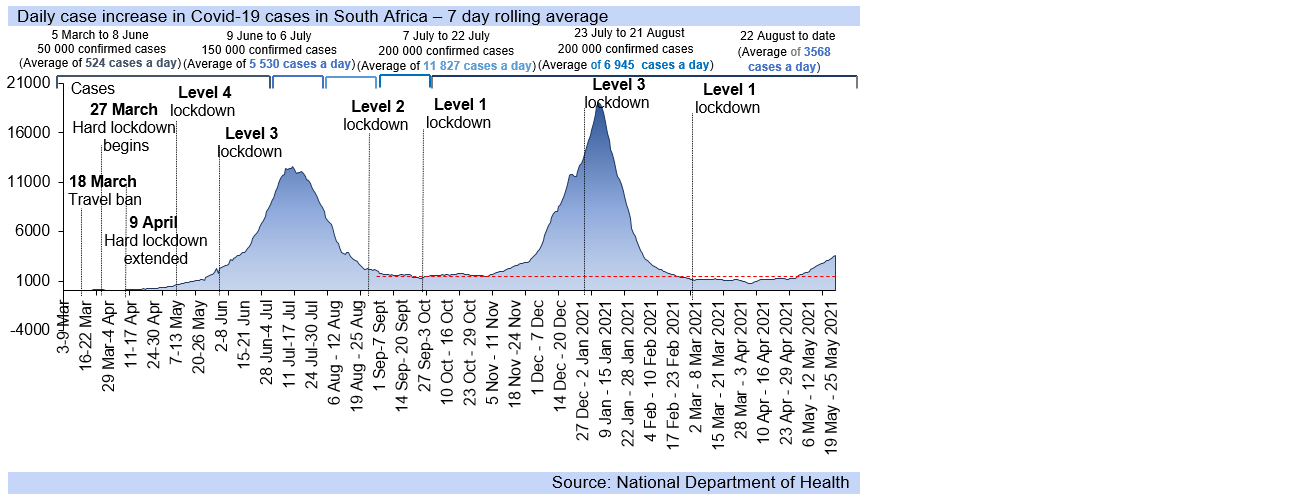
The third wave could be more moderate than the second according to the South African Covid-19 Modelling Consortium (SACMA), which also expects a lower peak than in the second wave, assuming that no new, more contagious, variants emerge.
Health Minister Mkhize is reported to have warned yesterday that some of the provinces are in the third wave, with “the numbers rising again in the various provinces; mainly Gauteng, the Northern Cape, Free State and the North West.”
“If we maintain this trajectory, the whole country will be similarly declared," the minister continued. "We, therefore, need to continue to adhere to non-pharmaceutical interventions and continue to increase our vaccination efforts."
The mass vaccination rollout is well underway, although shortages of vaccines is the limiting issue, with government retaining control of procurement and only those over 60 and healthcare workers eligible to receive the shots so far. Vaccinations have now reached 828 204 people, up from 597 406 a week ago.
The still relatively slow pace has called into doubt SA’s ability to vaccinate two-thirds of its population by the end of the year -- a target that would be achievable with full, professional private sector involvement if procurement volumes were not a binding constraint.
SACMA has said that “across all age groups, hospital admissions are expected to be lower than levels in the 2nd wave," adding that the time from initial increase in transmission to the peak is, on average, 2-3 months.
Nevertheless, tighter lockdown restrictions in June are on the cards. But these will likely be focused on regulating social behavior through curfews, alcohol restrictions, and the like, thereby avoiding severe economic impact as the recovery takes hold. We are currently forecasting GDP growth of around 3.9% for the year.

SA sees third wave building as economy remains highly sensitive
21 May 2021
Seven-day rolling average of new Covid-19 cases doubles, but another harsh lockdown is unlikely
The economy contracted by an unprecedented -17.8% y/y as a result of the lockdown in the second quarter of 2020.
The high sensitivity of businesses, and consumers, to lockdown restrictions has exceeded expectations, and imposing further harsh restrictions now would severely exacerbate the high fragility of the recovery. For this reason, we do not expect any such moves by government. Levels 4 and 5 are likely to be avoided, and even level 3 is likely only in a light version.
In the second wave, SA moved to level 3 around 12,000 cases a day on a 7-day rolling average, but as this happened later than anticipated, it contributed to a less severe Q4.20 GDP outcome than originally forecast, and a lessor contraction of -7.0% y/y for 2020.
SA is below 3,000 cases a day on a 7-day rolling average currently, at 2,822, and is not showing a steep climb either in this average. Increasing restrictions severely in the near future would be very pre-emptive, choking off promising economic and employment recovery.
SA has administered 597,406 vaccinations so far and has not completed its phase 1 of covering 1.25 million frontline healthcare workers, but has embarked on a portion of phase 2, beginning vaccination of those over 60 (5 million) and of healthcare workers more broadly.
South Africa has almost vaccinated 1% of its population, which is still a very slow outcome, exceeded by most EM countries and many African countries, and so is a threat to economic and employment recovery, as it exposes SA to further waves and lockdown restrictions.
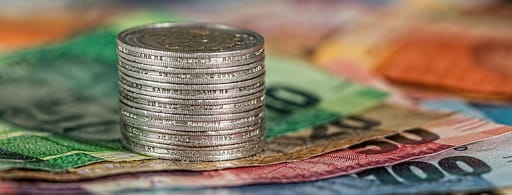
Commodity boom isn't the only force boosting the rand
20 May 2021
Resource prices explain some of the currency's recent gains, but incremental improvements in domestic fundamentals are also playing a role
The rand's gains this year are outpacing the currencies of both emerging market peers and other commodity-driven economies. There is a multitude of drivers behind the currency's rally; among them, risk-on sentiment in global financial markets and the strength of commodity prices. But the outlook has also brightened on small but steady improvements in the structure of South Africa's economy.
We continue to forecast a reform-led economic recovery that should improve exposure to global growth, with domestic GDP rising from 1.5% y/y in 2022 to 3.0% y/y by 2026. This year is likely to see a statistical rebound of between 3.0% to 4.0% y/y, after 2020’s -7.0% y/y drop.
Major structural challenges and constraints to economic growth remain, including limitations on electricity and water supply, inadequate transport systems, and an onerous bureaucracy. However, small improvements in these areas in recent months have proven that quicker reforms will lead to accelerated growth.
The blueprint for faster economic growth and higher levels of employment and incomes is clearly laid out Project Vulindlela, the joint initiative of the Presidency and Treasury to "fast-track the implementation of high-impact reforms, addressing obstacles or delays to ensure execution on policy commitments." The need could not be more urgent, following the slow pace of implementation since 2018 and the marked deterioration of much of the 2010s.
While growth prospects have brightened, financial market investors may also be feeling somewhat more comfortable after SA's handling of its bond market rout a year ago, as well as improved fiscal plans on revenue figures that exceeded those forecast in the Medium-Term Budget Policy Statement (MTBPS). In particular, investor confidence has been buoyed by the reduced government debt projections, aided by the 2020/21 corporate tax-led revenue overrun, as well as the drop in weekly bond issuance. But markets will still be watching intently to see if fiscal consolidation is indeed achieved.
The attention of the capital markets will also be trained on efforts to bring to book corrupt, high-ranking political figures who were, until recently, deemed untouchable. Recent signs of progress on key prosecutions have no doubt contributed to the rand's momentum.
It should be noted, however, that not all proposed reforms in SA are market-friendly, with some, such as the contentious introduction of land expropriation without compensation, harking back to the prior regime’s populist agenda.
As the heady mix of domestic policy, global market events, and commodity prices continue to impact its fate, the rand will remain volatile. But, for the first time in recent years, the currency's longer-term trajectory might just be looking up.

Production lift will push GDP growth into positive territory
14 May 2021
Q1.21 lift will push GDP growth into positive territory as expected, but also add to the mixed picture, with a number of key data readings outstanding while Fitch has SA’s rating unchanged.
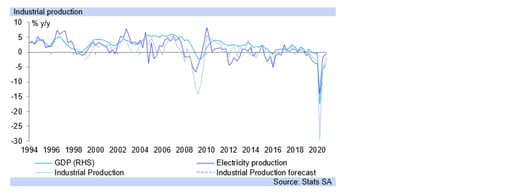
Yesterday's mining production print, at 3.8% qqsa (quarter on quarter, seasonally adjusted) completes the picture for Q1.21 industrial production, which rose by 3.5% qqsa in Q4.21, and so will make a fairly strong, positive contribution to overall Q1.21 GDP.
Industrial production makes up 21.5% of GDP, consisting of the sub-sectors manufacturing, mining and electricity production. However, the largest sub-sector in GDP is real estate, business services, and finance at 21% followed by general government at 16.3% of GDP.
General government expanded consistently in size over the 2010s decade, with the heavy cost of staff wages, as civil servants' remuneration grew rapidly in the 2010s, the key component in the marked deterioration of government finances on the expenditure side.
Fitch still has SA on a negative outlook, stating this week that “payroll and SOE reforms will be crucial for fiscal consolidation. Compensation of public-sector workers accounts for a large share (around 35%) of government expenditure.”
“Ongoing negotiations on a new wage deal are likely to be difficult and the government is unlikely to meet its target of agreeing on a wage freeze, leading to the risk of expenditure overruns. …. The conditions for debt stabilisation are challenging”.
“The Land Bank default last year and the difficulties of electricity monopolist Eskom Holdings SOC Ltd highlight the risk from contingent liabilities from SOE’s high debt and weak finances.” These elevate SA’s planned peak in debt, and it remains on BB+ with a negative outlook.
Both Fitch and Moody’s ratings are unchanged so far this year, with the negative outlooks retained, but Fitch worries on “further deterioration in South Africa’s trend GDP growth rate” and highlights that SA has been through an “exceptionally tough lockdown”.
Fitch comments that “the government is working on structural reforms to accelerate the economic recovery, but the scale envisaged is limited and recent record of implementation is weak so that trend growth is likely to remain very weak, below 2%”.
While we expect economic growth to quicken to 3.0% y/y out to 2026 on structural reforms, Fitch appears to see less of a positive trajectory, showing concern that “divisions within the ruling party (have been) hindering policy-making”, or essentially implementation.

SONA Preview: SA edges towards a financial precipice
9 February 2021
The 11 February State of the Nation Address (SONA) comes at a critical moment in South Africa's recent history. Unless government articulates a more business-friendly policy agenda and demonstrates real progress in achieving the goals of the ERPP (Economic Reconstruction and Recovery Plan), the country's financial future looks dire indeed.

Government’s latest growth plan, the ERRP, has seen few short-term goals achieved since its unveiling in mid-October. Progress has been mainly diagnostic: establishment of committees, funds, and (perhaps counter-productively) increased state employment.
SA is likely to see economic growth of 2.9% y/y in 2021 as it rebounds from the -7.3% y/y collapse of last year. This muted recovery has been accompanied by an unsustainable expansion in government borrowings and a widening fiscal deficit. Planned government borrowings for 2021/22 sit at R4.6 trillion (86% of GDP), and are forecast to reach R5.5 trillion by 2023/24 (93% of GDP) and 95% of GDP by 2025/26. As these ratios deteriorate and SA sinks deeper into a debt trap, lower credit ratings are all but guaranteed. The slide towards C-grade categories reflects concerns about a rapidly increasing risk of default. SA’s credit ratings are likely to fall into the single B grades this year already.
The only way out of this trap is inclusive economic growth. Failure to achieve (as opposed to simply plan) rapid economic growth and cut state expenditure, is now critical to avoid financial collapse. This requires policies that promote private and public sector investment in productive infrastructure and a curtailment of unproductive expenditure on inflated public wages and inefficient SEOs.
On a more basic level, a key factor in SA's failure to achieve sustainable economic growth is the alarming fact that doing business in South Africa is becoming more difficult, not easier.
With the pace of regulatory reform lagging other economies in the developed and developing world, SA is becoming less competitive as a destination to set up shop or commit fixed investment. The result is lower employment, lower tax revenues, and a negative growth spiral.
Furthermore, the World Bank’s 2020 Doing Business report says “inefficient regulation tends to go hand in hand with rent-seeking. There are ample opportunities for corruption in economies where excessive red tape and extensive interactions between private sector actors and regulatory agencies are necessary to get things done.” This is particularly true of both South Africa’s onerous regulatory environment and its high levels of corruption. South Africa lacks true, unified outrage against corruption."
The 20 worst-scoring economies on Transparency International’s Corruption Perceptions Index average eight procedures to start a business and fifteen to obtain a building permit. Conversely, the 20 best-performing economies complete the same formalities with four and eleven steps respectively. Moreover, economies that have adopted electronic means of compliance with regulatory requirements— such as obtaining licenses and paying taxes—experience a lower incidence of bribery. It's clear that South Africa needs to shorten the time taken to start a business.
Hopefully, the president's address will go some way towards reassuring South Africans that government is alive to the dramatic benefits that can accrue from creating an environment that is more attractive to doing business, and to the dire consequences of maintaining our current slide towards the cliff edge.
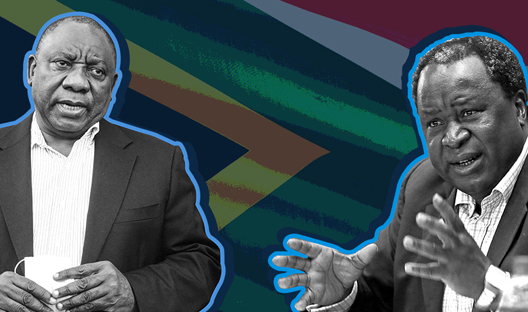
Get all Investec's insights on the latest Budget Speech and SONA
Our economists, tax experts, personal finance and investment experts unpack what the latest fiscal measures mean for income, savings and daily expenses of individuals and businesses.

January lockdown restrictions have not harmed SA's 2021 growth outlook
2 February 2021
Amended level 3 lockdown restrictions in January should not harm the 2021 growth outlook, unless further restrictions are applied, which is unlikely.
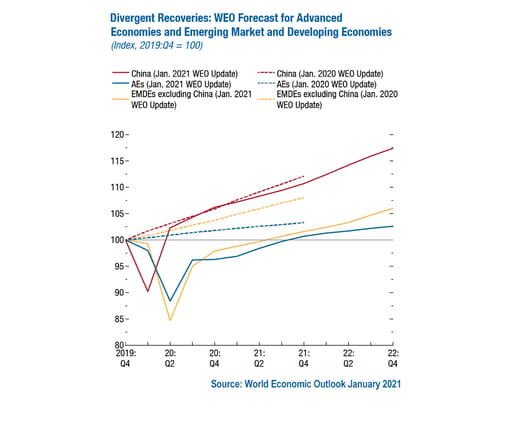
The seven-day rolling average of new cases of COVID-19 infections in South Africa has slowed to 5 539 individuals, from its peak in the current wave of 19 042. A downward trend has been maintained, now well below the peak of the first wave, with 2 548 new cases a day.
New daily COVID-19 infections at the origin of the second (current) wave have declined noticeably (Nelson Mandela Bay), and further afield, with SA’s fatality rate moderate due to its youthful population. The rand reached R14.89/USD today as new daily cases moderated.
Level 3 restrictions have been eased somewhat, with alcohol sales allowed Monday to Thursday 10am to 6pm, onsite consumption of alcohol at licensed venues from 10am to 10pm, and the sale of alcohol from wine farms, micro-breweries during normal operating hours.
Furthermore, all beaches, dams, rivers, parks, and swimming pools are now open, with social distancing and health protocols, and gatherings remain limited to 50 indoors, 100 outdoors, not exceeding 50% of capacity. However, SA remains at risk of a third, and even fourth wave.
While South Africa is expected to begin administering vaccines this month if in limited quantities, it will still be many months before the entire two-thirds proportion of the population is covered, and so before social distancing and economic restrictions can fully ease.
The progress towards herd immunity (two-thirds of populations fully vaccinated, including likely all the elderly, vulnerable, and health care workers/other essential services) generally is slow, with the US only vaccinating 10% of its population so far, and the UK 14%.
In South Africa, 1.5 million doses of Oxford-AstraZeneca for health workers have arrived and it is reported that SA is securing another 20 million from Pfizer, 12 million from COVAX, 9 million from Johnson & Johnson, reaching 40 million in total.
Domestic economic growth will depend heavily on the degree of the regulated lockdowns on economic activity, and the necessity to substantially ease the regulatory burden on private sector businesses while lifting civil servants’ productivity.
Economic activity is expected to rise by 2.9% y/y this year, but the deep scarring the domestic economy has already experienced from the harshly regulated shutdown of economic activity last year is likely to be persistent until 2024 in real terms.
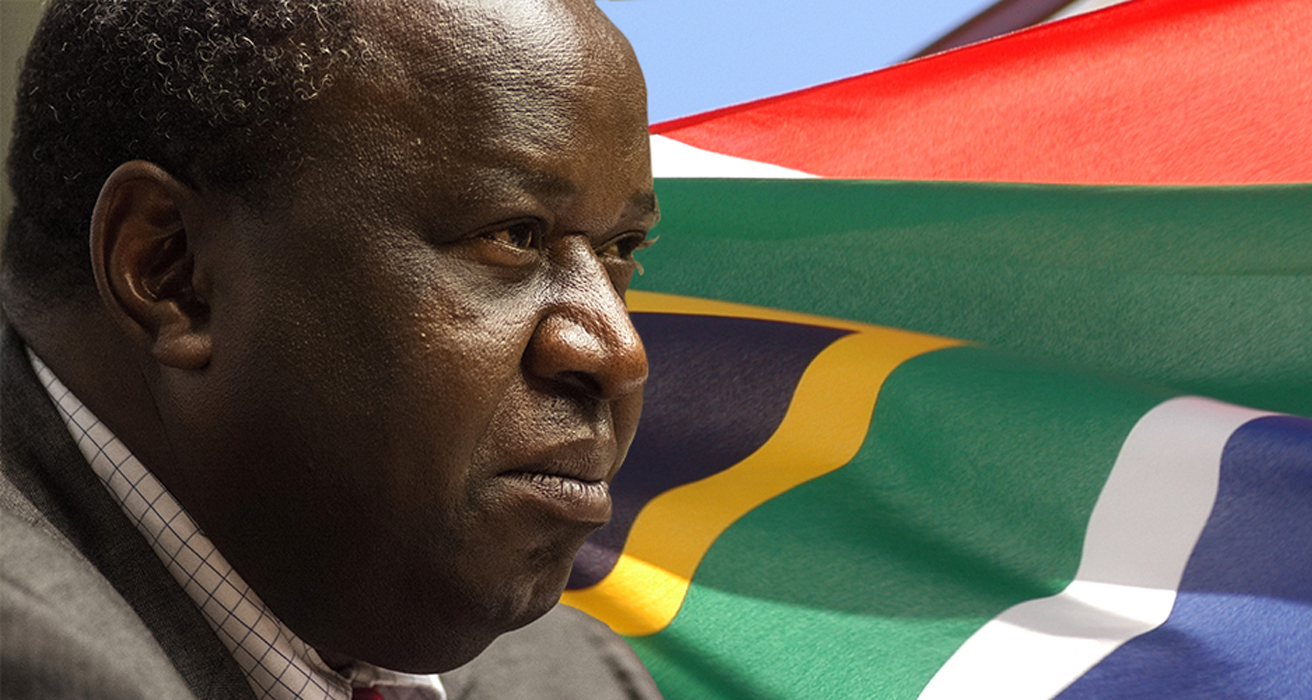
Tough times ahead for SA economy
25 June 2020
The 2020 Supplementary Budget Review projects a sharp deterioration in government debt. if SOE contingent liabilities are included, SA's debt:GDP looks set to grow to around 100% by 2023/24, with further ratings downgrades on the cards.
Wednesday's Supplementary Budget Review shows that this decade is expected to begin with a massive plunge in the health of government finances, with a fiscal deficit of -14.6% of GDP and gross debt as % of GDP of 81.8 projected for this fiscal year, versus the previous projections of a fiscal deficit of -6.8% of GDP and debt at 65.6% of GDP for 2020/21.
The rating agencies are likely to downgrade SA further on the back of this budget, as the key objective of any credit rating agency is to assess the ability of a country (or corporate) to repay its debt, and with SA now signalling that its debt burden will rise to 87.4% by 2023/24 this has deteriorated SA’s ability to repay its debt.
It is not possible to continuously borrow out of debt, nor to indefinitely borrow to make debt payments and fund current expenditure. Debt interest payments do have to be made to avoid default. SA is on a negative outlook from Moody’s, at Ba1 (BB+). The rating agencies will likely downgrade SA after the budget, if not in November 2020, then sooner.
Some limited positive news emerged from the adjusted budget today, and that is the announcement that SA’s debt is projected to peak at 87.4% by 2023/24, as opposed to pre-budget ‘leaks’ that SA’s debt is further estimated to rise to 90.9% by 2023 and over 100% by 2025, climbing to a massive 113.8% by 2029.
However, SA has been falling through the credit ratings increasingly quickly, and is at BB from Fitch (for both its foreign and local currency ratings), while from Standard and Poor’s SA’s local currency rating is BB but its foreign currency (country) rating is BB-. The next step after BB- is single B, followed by the C grade ratings and then D, for default.
While SA projecting a peaking, and hence stabilisation of debt is positive, it will not be enough to avoid SA being pushed into the single B credit rating categories over the course of the next few years, with 87.4% still a huge figure for an emerging market’s government debt, and one which does not tally with debt sustainability.
This is particularly because the credit rating agencies tend to look at SA’s debt in conjunction with that of its guarantees that it has extended to the State-Owned Entities’ debt, and the calculation, when including all these contingent liabilities takes the figure to around 100% of GDP by 2023/24.
The biggest risk SA faces in its massive quantum of debt issuance is investor appetite, which, while strong will not last forever. SA will likely run out of space in the domestic market, which is the biggest absorber of SA’s government debt, as SA has a limited quantum of savings, which have been used to mostly fund government issuance so far.
Furthermore, government is increasingly eyeing private sector savings to fund its infrastructure projects, via prescribed or voluntary assets, with pension funds already a very large holder of state debt. The huge ramp-up in projected debt and issuance is at odds with the limited savings pool in SA, and will add to pressure for further credit rating downgrades.
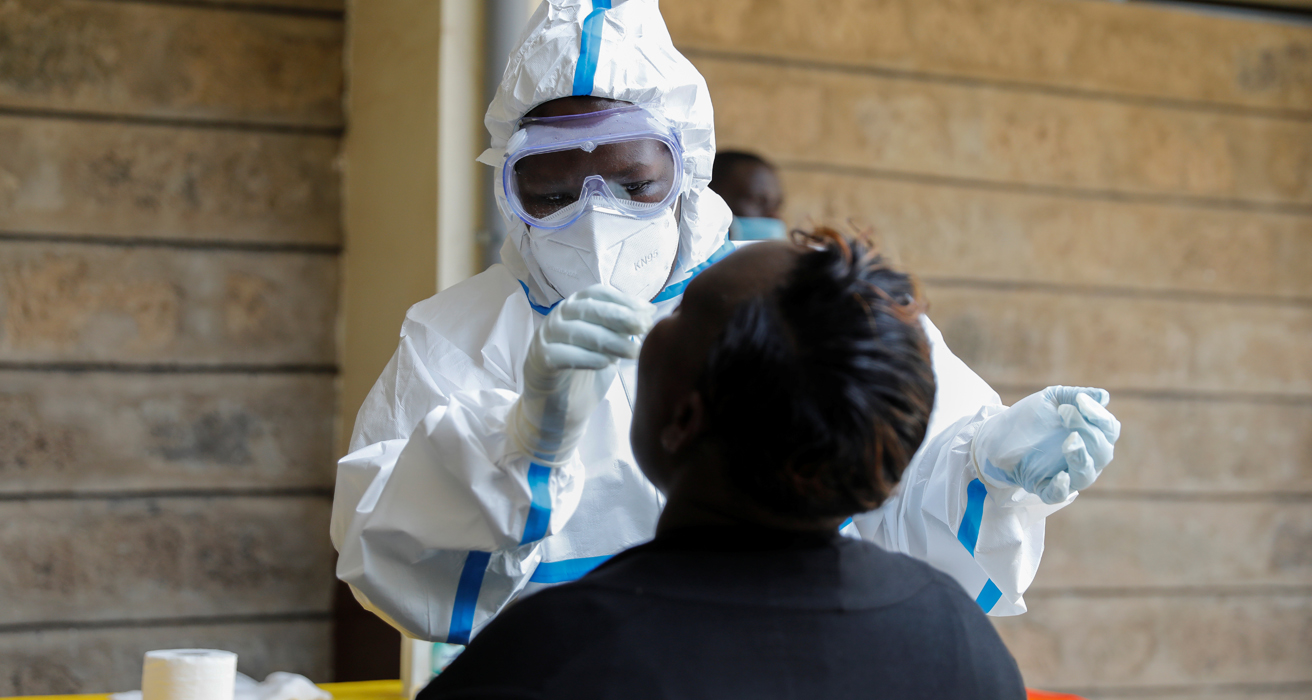
Economies open as Covid-19 infections rise
5 June 2020
The impact of the Covid-19 crisis is deepening poverty, hunger and unemployment around the world. The opening up of economies continues, but recovery will be impeded by lagged effects
This week the number of confirmed cases of Covid-19 have exceeded 6 million globally, at 6.4 million versus 5.6 million a week ago, while the number of deaths are at 382 867 versus 353 334 a week ago. With the epi-centre of Covid-19 now in Latin America, the region also faces an economic and health crisis from the effects of the spread of the pandemic.
Latin America suffers from substantial inequality, with weak public finances and fragile health systems. In Brazil Covid-19 cases and deaths are surging, while politically the country is seen to be becoming more unstable, suffering also from poor responses to the crisis, with GDP contracting by -1.5% y/y in Q1.20 and expected to drop a further – 9% y/y in Q2.20.
The number of Covid-19 cases in Brazil is around 600,000, with above 30,000 new cases a day now in a population of just above 200 million. Chile (population 19 million) and Argentina (45 million) are seeing fewer confirmed cases but are smaller populations, with their respective Covid-19 reported infections approaching 120,000 and respectively 20,000.
Chile’s economy contracted by -14% in April, and prolonged lockdown measures are expected to see a deeper contraction in May and June, with the country also suffering from social unrest. In Argentina economic activity fell 11.5% in March, with worse expected in Q2.20, and it defaulted on a US$500m payment and is in restructuring talks with bondholders.
In Columbia, Covid-19 cases are around 30,000 with a population of 50 million, with its government lifting restrictions incrementally, while its economy is seeing very depressed consumer sentiment and its manufacturing sector also having shown deep contraction.
Mexico is at around 100,000 cases (population 129 million), and is expected to see the deepest recession in Latin America, of -13.0% y/y in Q2.20, -9.2% y/y in Q3.20, -6.6% y/y in Q4.20 and -4.2 y/y in Q1.21, after contracting by -1.4% y/y in Q1.20. The lockdowns in the US are also negatively affecting activity in Mexico.
In South Africa, there are 40 792 confirmed cases of Covid-19 to date, with 848 deaths, as the country with a population of 59 million is expected to see a deep recession this year. Public opposition to the lockdown restrictions is rising sharply, while incomes fall and a survey on hunger shows an increase from 4.3% to 7.0% in respondents.
The survey from Statistics SA, on the impact of Covid-19 on employment and income in South Africa, conducted between 29th of April and 6th May, with no updated report published yet, also shows that “the percentage of respondents before who reported no income increased from 5.2% before the lockdown to 15.4% by the sixth week of national lockdown”.
Many individuals in South Arica are using savings, UIF payments, loans from family and friends, investments and social payments other than the UIF to survive, but all these sources of income will be eroded, and without a rapid opening up of the economy, will see more sink into deep financial hardship and so retard the recovery of economic growth later this year.
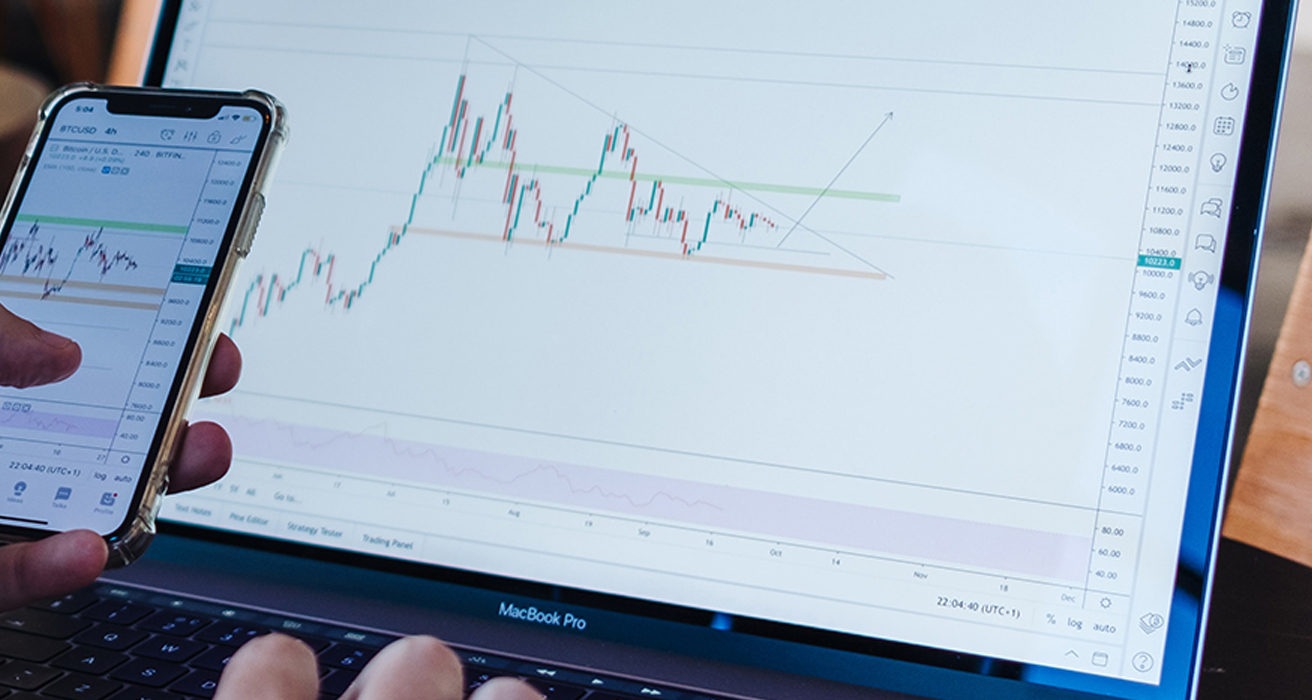
Impact of lockdown on GDP
26 May 2020
GDP is at risk of contracting by between -8.0% y/y and -10% y/y, if not worse this year, on the lengthy, severe lockdowns
March 2020’s leading business cycle indicator, released today by the Reserve Bank, lifted to 104 from 103.3 in February. The around six-month lead (between the leading indicator and GDP growth) indicates that with Q1.20 at 103.4, down on Q4.19’s 104.0, Q4.20 GDP would be on track to see a contraction.
However, the data used was for Q1.20 and does not capture the worsening conditions of the extended lockdown, globally or domestically. With the lengthening of the lockdown (May level 4, June level 3), from April’s virtually total shutdown of level 5, Q2.20 GDP could see a sharp contraction of around -50% qqsaa or worse, while Q3.20 is likely to see less of a rebound than previously anticipated.
With the current progression of one month for each level, July and August will see some continued restrictions on economic activity, and the recovery in Q3.20 is likely to be much more subdued than originally thought. Instead of a rebound of 40% qqsaa in Q3.20 it could instead be around 15% qqsaa.
Furthermore, it is not certain that the levels will see a linear monthly progression, levels could go up as well as down, while companies themselves are at risk of temporary closures if infections occur.
The use of the Q1.20 leading indicator (released today) as a pointer of future business activity has been dramatically diminished by the impact of the Covid-19 crisis.
We previously expected economic growth of -4.8% y/y for 2020, but now believe it could come out closer to between -8.0% y/y to -10% y/y, if not worse. Much will however depend on the progression of opening up the economy. The very slow pace so far has driven our worsening forecasts, as has the sheer length of the lockdown to date, which has seen incomes fall (both due to rising unemployment and firms cutting back on staff remuneration versus last year), and demand to collapse.
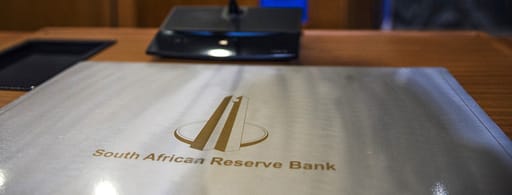
MPC preview
19 May 2020
Interest rates are likely to remain lower for longer in South Africa, at this week’s MPC meeting a small rate cut is likely
South Africa has seen a 2.25bp cut in interest rates this year, 200bp in direct response to the impact Covid-19 has had on the economy and financial markets, as the crisis deepened. The first cut, of 25bp in January, was in response to the recession SA had fallen into in the second half of last year, given that inflation was subdued into the target range close to the midpoint, and expected to remain there over the forecast period.
Indeed, this year we expect CPI inflation will come out at 3.4% y/y, and at 4.1% y/y in 2021, although we believe the risks are for even lower outcomes. At the last MPC meeting, the emergency meeting in April, the MPC forecast CPI inflation at 3.6% y/y for this year and 4.5% y/y for next year, but we believe these forecasts will be lowered at their meeting this week, to closer to 3.4% y/y or below for this year, and to closer to 4.0% y/y for next year.
This week’s MPC meeting is likely to see a further downwards revision to the Reserve Bank’s GDP outlook, particularly for 2021, as the lockdown is proving lengthy and severe. We expect however that the SARB (South African Reserve Bank) will not engage in another large (100bp) cut in the repo rate this week, preferring instead to preserve some room to implement further easing later in the year, should conditions worsen even further.
We expect that the MPC will deliver a modest cut of 25bp this week, but there is a possibility it chooses to keep interest rates unchanged, giving the immensity of the cuts at its last two meetings. Keeping its powder dry by leaving rates unchanged or providing only a small, 25bp cut, in the face of a potentially much larger contraction in GDP than is currently widely expected would allow for more support later.
GDP risks contracting by closer to -10% y/y to -15% y/y this year due to the very slow reopening of the economy that is occurring, and the extreme nature of the lockdown. South Africa has seen one of the most severe economic lockdowns globally, and its lengthy duration (with level 3 now only expected by June) will likely see the domestic economy contract by closer to -10% y/y to -15% y/y this year.
Interest rates are likely to remain low for a lengthy period of time, as the economy will not recover in Q3.20, nor will it recover in Q4.20, or in 2021. Many years of growth will have been wiped off GDP and it will be a slow lengthy process to rebuild. Unemployment risks rising to 50% next year. From an inflation point of view, the SARB is in no rush to hike interest rates.
The uncharted territory South Africa and the rest of the globe is in has created enormous uncertainty. In South Africa the government has warned that levels will be raised if necessary (the lockdown intensified) which would severely worsen the GDP outcome. Covid-19 has not yet peaked in SA and it is quite a while before it is expected to do so.
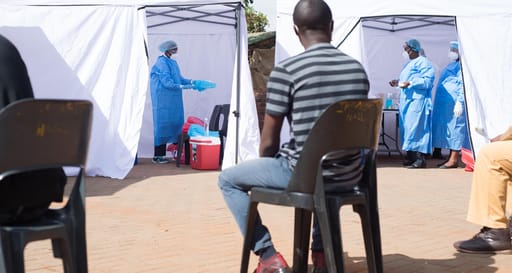
More job losses as lockdown continues
15 May 2020
The pace of South Africa's Covid-19 ratio of deaths to infections slowed substantially from mid-April, with lockdown restrictions only seeing some relatively mild easing, while job losses shoot up
The pace of South Africa's Covid-19 deaths to infections ratio slowed materially from mid-April, both in terms of new infections and deaths, and total deaths and infections. Lockdown restrictions have only seen relatively mild easing while job losses shoot up. Experts on Covid-19 have warned it will be impossible to eliminate the virus.
South Africa’s low fatality rate, below that of the global rate, reflects also a low infection rate, but even with the extremely severe lockdown the country has been under (one of the most severe in the world), the virus has spread, and will continue to spread, with global evidence now warning it will become endemic and is unlikely to be eradicated.
A vaccine is deemed unlikely this year, and herd immunity (when over 60% of the population has had the disease) is the most likely path. Studies have observed that the number of deaths globally is likely to be lower than expected. It is well reported that children under 18 have an extremely low likelihood of the disease, especially death from it.
Experts have said that the spread of the disease is impossible to prevent. Global figures have shown that Covid-19 tends to cause essentially no symptoms in around 70% of cases, while around 25% of cases show mild symptoms, and the remaining 5% (typically the elderly or those already severely ill before Covid-19) see severe symptoms with a risk of death.
South Africa continues to see a very cautious approach to lifting its economic lockdown restrictions, while the damage caused to the economy is ramping up. South Africa has yet to see level 3 reached, and the circulation of money has collapsed, with the companies that are open (recently surveyed at over 50%) still seeing turnover negatively impacted.
South Africa's severe, lengthy lockdown could see the economy contract by more than expected in 2020, closer to -15% y/y than the latest consensus estimate of -6.4% y/y (Bloomberg) if the very slow pace of opening up persists. This would cause formal unemployment to escalate more rapidly, risking a rise ultimately beyond 50%.
South Africa’s Covid-19 infections are still on an upwards trajectory, while a number of other countries have seen cases of new infections peak. However, globally there are now concerns of a second round of infections, or even of multiple waves of infections, driving the globe inevitably towards herd immunity.
Around the world, the impact of restriction measures in the face of Covid-19 has had a severe, dire impact on economic activity, employment and so livelihoods. South Africa has been at the pace of one level of lockdown a month but the economy is in the process of losing several years of development and will not recoup these losses in the medium-term.
The incoming data on April, the first full month of lockdown and the most severe period of lockdown to date, has shown that electronic bank transactions in the economy, which is reflective of business activity and the circulation of money, is at a fourteen year low in real terms (removing the distorting effects of inflation) – BankservAfrica data.
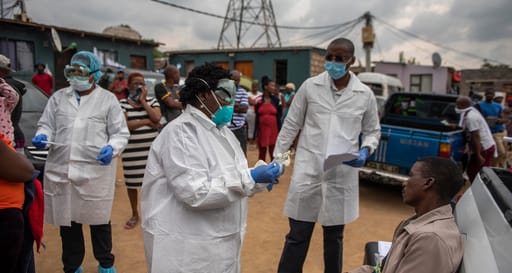
SA economy expected to contract
8 May 2020
A meaningful recovery from recession, globally and domestically, will depend on the rapidity of exit from lockdown restrictions, broad based support measures and for SA particularly, a substantial easing in red tape
Globally, the advent of the easing of lockdowns turned attention to the prospects for economic recovery, boosting some financial market sentiment. However, a slower than hoped-for pace of easing of restrictions would disappoint markets, and a return to temporary risk-off is not unlikely, particularly if a second wave of infections/ lengthening of lockdowns occurs.
Economic expectations of the impact of Covid-19 on the global economy continue to adjust, with economists slightly less pessimistic about the global economic outlook than a week ago according to the latest Focus Economics survey, but risks are still seen as heavily skewed to the downside.
In South Africa, low survey responses are hampering hard data collection. The economy is expected to contract by -36.2% qqsaa in Q2.20 (Investec forecasts -37.1% qqsaa or -12.1% y/y), with business sentiment already depressed over the past decade, with economic growth weakened by poor state governance and a rapidly rising quantum of red tape.
The latest Bloomberg economic consensus shows SA’s GDP contraction this year forecast at -5.0% y/y (Investec -4.8% y/y). However, we now expect there is a rising chance that SA will see GDP growth contract by more than -6.0% y/y in 2020, as government’s pace of easing the restrictions on the South African economy is proving to be extremely gradual.
Already a report from BankServ (the largest automated payments clearing house in SA) analysing actual transactions, shows that in the thirty-eight days to the 3rd of May 2020 (since lockdown began on 26th March 2020 in SA) daily transactions are down sharply, by 49% after peaking in March, as consumer spending plummets.
Specifically, “consumer transactions were down by half of the usual transaction volumes tracked by BankservAfrica’s Point-of-Sale (POS)* and ATM transactions over the corresponding period in 2019”. “April’s month-end was 48% below the norm”, and the “drop in the month-end transaction volumes between March and April was 58%”.
BankServ highlights that this “reflects a slower start to the April pay month so far. The actual same period in 2019 had a 20% increase in transactions.” “This is a far cry from the average daily spend by consumers that is usually higher at the start of the pay month.”
Cheeringly, “indications so far suggest May 2020 will also be below the norm.” “However, since 1 May 2020, when level 4 restrictions were applied, the average number of transactions processed by BankservAfrica increased slightly to 58% of the usual transaction spend”, proving “a glimmer of hope for a gradual increase in spending over time.”
As lockdown restrictions are eased further, with businesses hoping for level 3 restrictions to come sooner rather than later, the circulation of money in the economy is likely to see some further impetus, but consumer confidence will have been severely repressed in Q2.20, with lockdown also largely eliminating expenditure on big-ticket items and many luxuries.
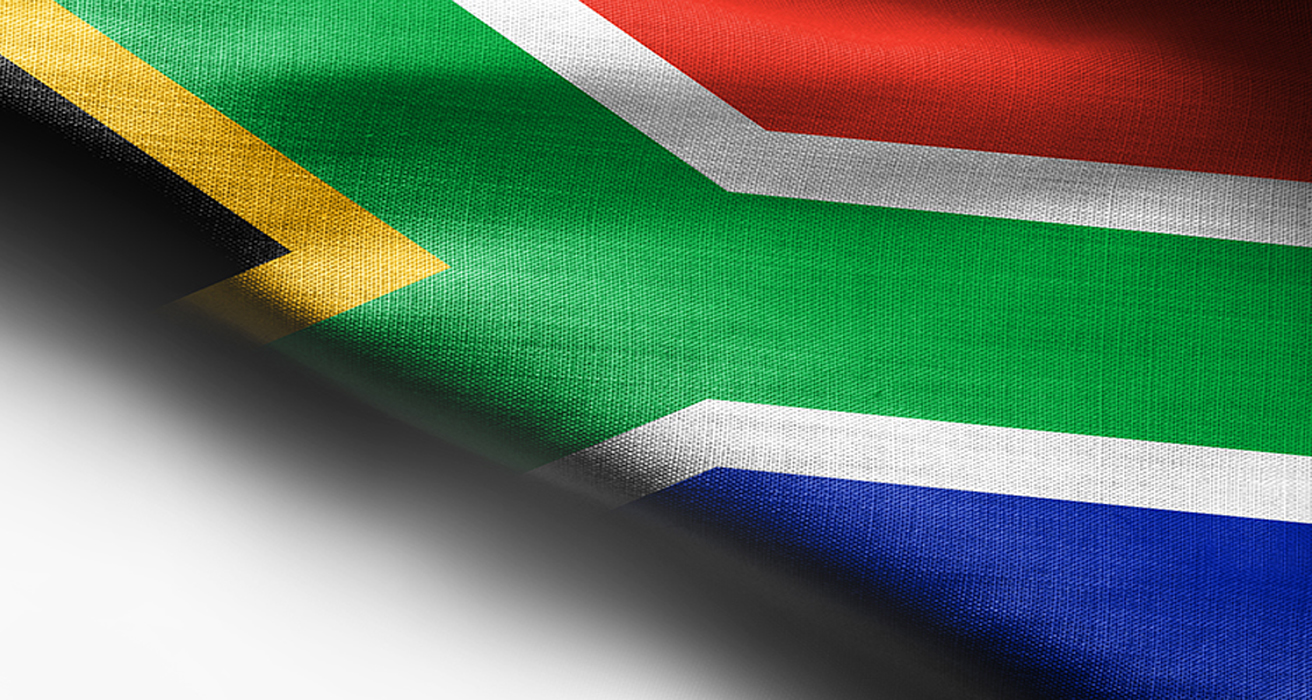
Another downgrade for SA
30 April 2020
Standard & Poor's downgrades South Africa to BB- from BB (foreign currency rating) with a stable outlook, and drops SA to BB from BB+ on its local currency rating (stable outlook), as SA falls further down the rating ladder
The onslaught of improved risk sentiment largely overrode the impact of last night’s S&P’s downgrade on the rand. Further credit rating downgrades for SA are still possible, given also ongoing political obstructions to necessary structural reforms (particularly a massive reduction in regulations and red tape) to prioritise sustained, rapid economic growth rates.
Specifically, yesterday evening Standard & Poor’s lowered South Africa’s credit ratings once again, with the foreign currency rating on the sovereign’s long-term debt falling to BB- from BB, with a stable outlook, and the local currency rating on SA’s long-term debt fell to BB, from BB+, also with a stable outlook.
S&P highlighted that “South Africa's already contracting economy will face a further sharp COVID-19-related downturn in 2020” as “the broader economic fallout will be very difficult to handle, and South Africa entered the crisis from a weak fiscal and economic position.” ”The appreciably weaker macroeconomic environment will also weigh heavily on … fiscal revenues”.
S&P adds, “(i)n the second half of 2019, the economy shrank, due partly to a set of severe rolling power blackouts. The COVID-19 health crisis will create additional and even more substantial headwinds to GDP growth, owing to a strict five-week domestic lockdown, the markedly weaker external demand outlook, and tighter credit conditions.”
“As a result, we now project the economy to shrink by 4.5% this year compared with our November 2019 estimate of growth of 1.6%.” ” A proactive policy response, including South Africa's decision to go into a strict lockdown relatively early, has so far limited the health impact of COVID-19. Early gains in tackling the virus will be built upon”.
Early this morning the rand did weaken briefly to R18.23/USD, R19.81/EUR, and R22.70/GBP in response to S&P’s downgrade as the country’s ratings fall closer to C grade. South Africa’s R800bn Covid-19 relief is expected to place great strain on government’s finances, while tax revenues underperform substantially due to the lockdown.
Concerns over SA’s fiscal deficit and debt levels have been rising in general, with a Bloomberg’s consensus now showing forecasts of a fiscal deficit in excess of -10% of GDP for 2020, and close to -10% of GDP in 2021. In 2022 a deficit of -8.5% of GDP is expected, as the impact of Covid-19 on government finances is expected to prove long-lasting.
The borrowing requirement will rise substantially, and S&P sees “net debt levels rising to over 75% of GDP by the end of 2020” and “to 84.7% by 2023, raising questions around debt sustainability”. Credit rating agencies common primary function is to assess entities ability to repay debt, and SA’s ability has deteriorated materially.
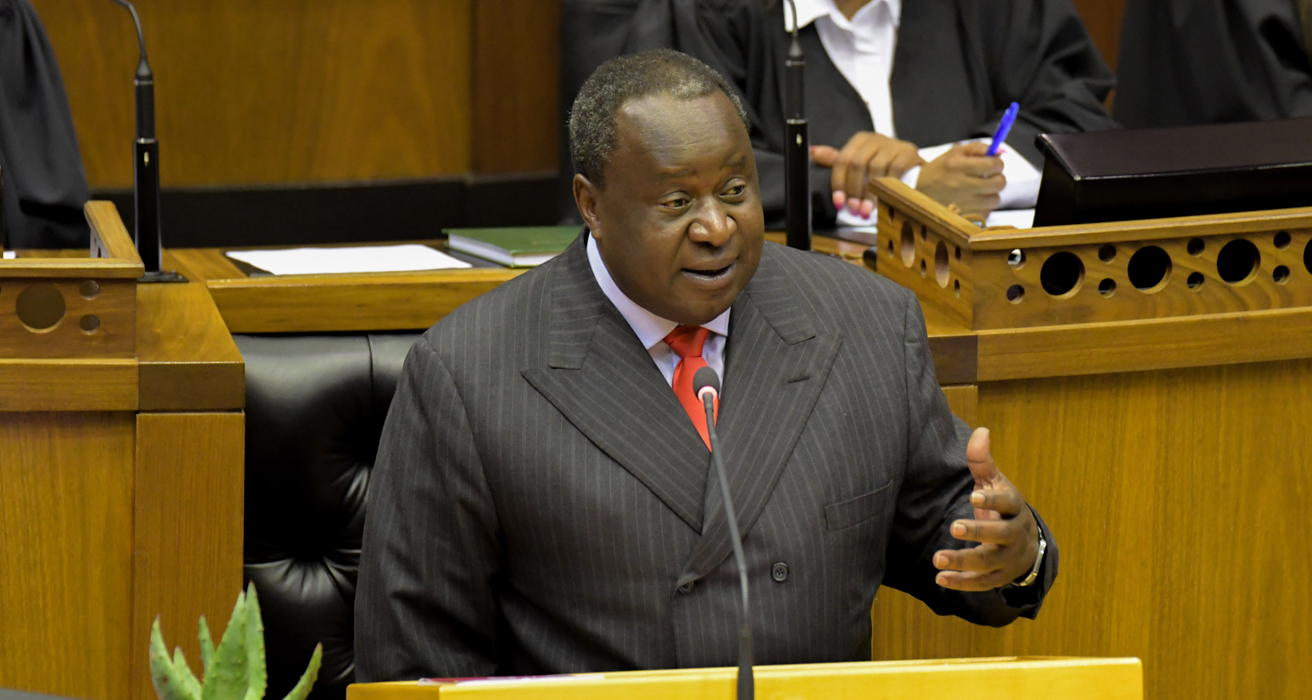
R500bn stimulus package for South Africa’s economy
22 April 2020
The R500bn stimulus package for South Africa’s economy (close to one tenth of GDP) announced last night is well targeted – but efficient, effective implementation will determine how successful it will be
With the impact of Covid-19 rapidly developing, the global recession is increasingly expected to be worse than previously thought, with a deep, lengthy downturn exceeding 2008-09s. South Africa is also seeing forecasts for its GDP revised significantly lower, with many tending towards the -5% y/y to -10% y/y range, up from smaller contractions initially forecast.
President Cyril Ramaphosa’s announcement of a R500bn fiscal stimulus plan for South Africa last night is near 10% of GDP, and was not chosen lightly. The R500bn support package is well-targeted, with a high focus on providing bridging finance for corporates (R200bn), as well increasing healthcare and providing some measures of alleviation of poverty.
Specifically, the package is broken down into a) an extra-ordinary health budget, with R20bn for healthcare for in the face of Covid-19 Relief, b) relief from hunger and social distress, including R50bn for temporary 6-month Covid-19 grants, increasing existing grants, food assistance through vouchers and cash transfers and R20bn for emergency water supply.
Furthermore, c) support for companies and workers of R100bn for protection and creation of jobs, and a R200bn loan guarantee scheme for SMMEs (in partnership with SARB, banking sector, and National Treasury), and d) a phased reopening of the economy that is risk-adjusted, balancing the need to get back to work with the health risks.
The “R200 billion loan guarantee scheme … (is) in partnership with the major banks, the National Treasury, and the South African Reserve Bank. This will assist enterprises with operational costs, such as salaries, rent, and the payment of suppliers. In the initial phase, companies with a turnover of less than R300 million a year will be eligible.”
The R500bn support package is part of the second phase of government’s “economic response to stabilise the economy, address the extreme decline in supply and demand and protect jobs”. “The third phase is the economic strategy we will implement to drive the recovery of our economy as the country emerges from this pandemic.”
The President also highlighted other measures that occurred in the first phase, including R70bn tax relief measures, R40bn income support for firms unable to pay staff wages, release of disaster funds, while the 2% repo rate cuts have unlocked R80bn for the economy. These three phases make up government’s economic recovery strategy.
“Central to the economic recovery strategy will be the measures we will embark upon to stimulate demand and supply through interventions such as a substantial infrastructure build programme, the speedy implementation of economic reforms, the transformation of our economy, and embarking on all other steps that will ignite inclusive economic growth.”
The President’s announcements last night also stated the need for structural reforms and inclusive economic growth. However, South Africa is expected to have been in a three-quarter recession before April this year as, the ease of doing business has been deteriorating in SA in the past decade, dragging economic growth down.
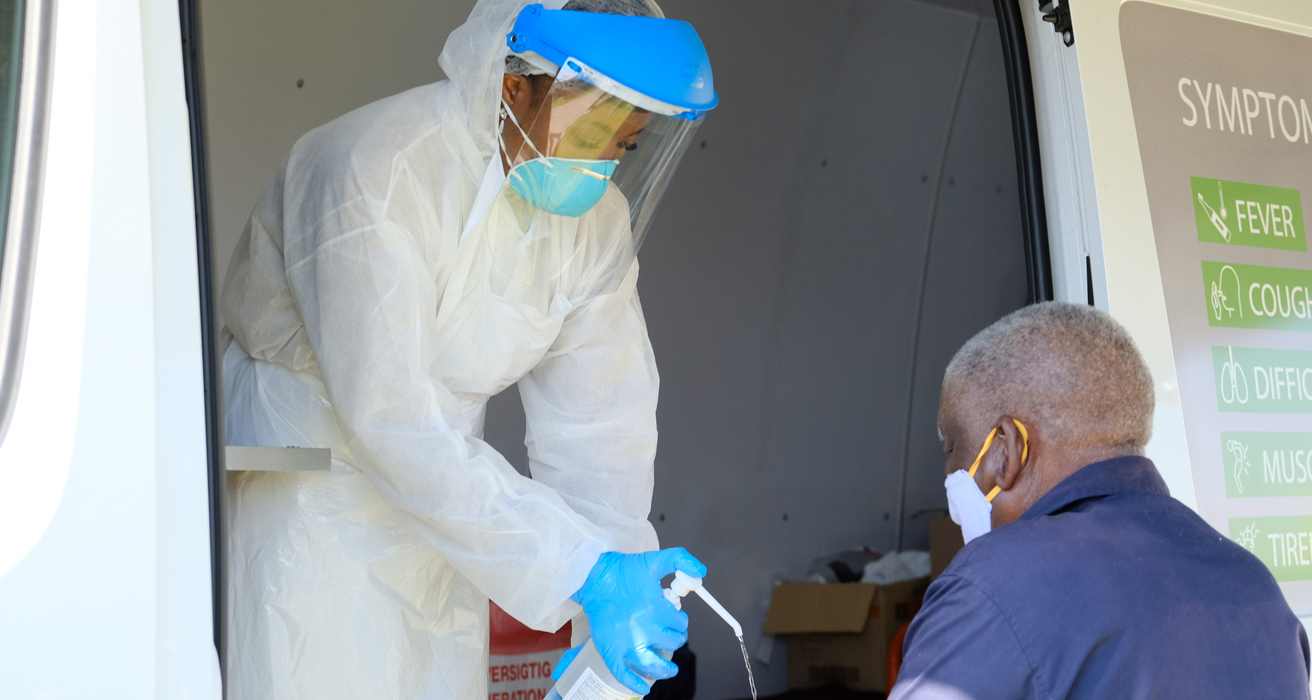
SA moves to level 4
16 April 2020
The SA's lockdown continues, but some small phased opening up of the economy has been approved by government, particularly in the mining sector, ports and logistics, hardware stores and some informal food traders
Many countries around the world are considering plans to lift restrictions on the operation of their economies (imposed to limit the spread of Covid-19), and are already outlining early phases of reopening parts of their economies, while at the same time (most are) considering the measures needed to avoid restarting a second round of Covid-19 infections.
Chancellor Merkel has appealed for "extreme caution", allowing the gradual reopening of some of smaller shops from next week and schools next month, but adding “(w)e have made some progress. But I do have to stress that this progress is fragile”, “this is a situation in which caution is the order of the day, not foolhardiness.”
German exports are expected to fall by a reported 15% this year (DIHK), with 80% of companies reporting sharp falls in turnovers and pessimistic views on the future, as the pandemic continues to negatively impact global supply chains, and delayed or cancelled capital investment adding to the malaise in Europe’s largest economy.
New Zealand may begin easing its lockdown next week, although Prime Minister Ardern warned it would not be back to normal. The country is looking at moving from a stage four lockdown, which has seen only food stores and pharmacies remain open, to stage three which includes restaurants reopening for take-aways, along with some other retailers.
President Trump has promised plans today on reopening the US economy, stating that the U.S. had "passed the peak" of the Covid-19 crisis and that his "aggressive strategy" against Covid-19 was effective, vowing immediate "guidelines" on ventilating parts of the economy, with areas/states evidencing lower infections easing restrictions by 1st May.
The US is reporting a record daily death toll from Covid-19. WHO data shows that for 15th April the US had 578 268 confirmed cases, with 23 476 fatalities so far, and daily 24 446 new cases and 1 504 new deaths. The CDC says the US is “nearing the peak right now”. The US has reported the most fatalities from Covid-19 versus any other nation.
The US has also lost 22 million jobs during its lockdown, eliminating the employment created in its past ten years of growth since its last recession of 2009, with Bloomberg also reporting that a US jobless rate of 15% or higher is implied by the recent jobless claims, a high since the Great Depression.
South Africa has amended its lockdown regulations to start reopening a few economic areas, notably mining (which can now operate at 50% capacity) under very strict health regulations. Miners which supply Eskom can operate at full capacity, as well as smelters, plants, and furnaces, and refineries to prevent fuel shortages, all under very strict health regulations.
Furthermore, essential items can be sold from hardwares and suppliers of vehicle components under register, logistics and ports can operate for export to decongest ports, bring in cargos currently at ports, and the transportation of cargos from ports and general transportation of essential goods. A further gradual phased opening of SA’s economy is likely.

Rand tumbles as intrest rate cut is announced
14 April 2020
Rand weakens on SARB surprise 100bp cut announced today, to R18.40, after having closed yesterday at R18.27, we continue to expect an average of R17.50/USD for Q2.20
The surprise 100bp cut in the SARB’s repo rate today (to 4.25%) takes South Africa’s interest rate cuts this year to 2.25% in total. The repo rate is at a historic low since it was recorded in 1998, the previous low was in 2013 at 5%. The prime lending rate was last at 7.75% in 1973.
After an initial knee-jerk reaction, the rand retracted to R18.26/USD, R20.01/EUR, and R22.93/GBP from R18.37/USD, R20.09/EUR, and R23.03/GBP, with its close yesterday at R18.12/USD, R19.77/EUR, and R22.65/GBP. The SARB has indicated more cuts are currently likely, potentially another 1.25%. The rand saw additional weakness this afternoon.
Interest rates are low globally, with Central Bank rates respectively at 0.1% for the UK, 0.05% for the US, in Europe 0%and Japan at 0.3%. The degree of monetary and fiscal stimulus globally is unprecedented, with the Federal Reserve Bank expanding its assets on its balance sheet under a huge quantitative easing programme.
This will prove inflationary, and in particular will weaken the US dollar over the course of this year (and potentially next), while the huge quantum of liquidity globally is likely to prove yield-seeking, lowering risk appetite and driving portfolio flows into risky assets, which include equities generally and emerging market bonds, with the rand expected to benefit.
The rand saw a more marked retracement against the US dollar, than against the euro and the UK pound, around midday, while the gold price rose to US$1 748/oz from its close of US$1 713/oz yesterday, with the gold price expected to gain further on the impact of global QE (Quantitative Easing).
Currently, however, global financial markets have not yet entered a period of risk-on and risk aversion is still heightened globally. The domestic currency is still at weak levels and is likely to remain volatile and weak in the near term until evidence for the beginnings of a recovery in the global economy becomes clearer.
The South African Reserve Bank (SARB) notes currently as well that “global financing conditions are no longer supportive of emerging market currency and asset values. Credit risk has risen back to 2008 levels and about R100billion of local assets have been sold by non-resident investors.”
The SARB adds that “(t)he overall risks to the inflation outlook at this time appear to be to the downside”. Its 2.25% cut in interest rates this year has helped both steepen, and lower the yield curve, along with its substantial operations to add liquidity in the mid to longer-end of the yield curve.
The huge volumes of QE globally makes the interest rate cuts in South Africa easier for markets to stomach, and the SARB is likely to cut rates further to assist SA as additional measures of monetary stimulus occur globally. The rate cuts in SA are likely to keep the rand closer to R18.00/USD - R18.50/USD this month, but strengthening as risk-on emerges.
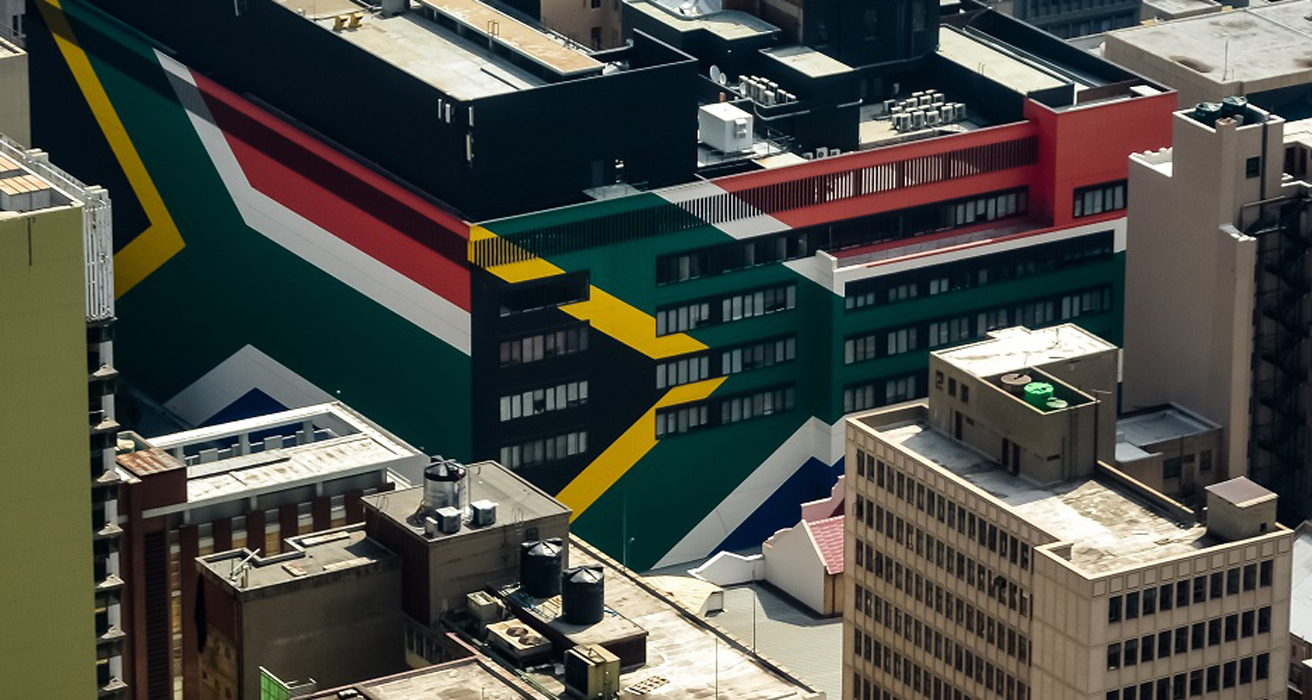
Q2.20 Macro-economic outlook 2020-25
1 April 2020
Covid-19’s global impact aids SA deeper into its recession, H2.20 is likely to see recovery
South Africa is currently likely to see GDP contract by -2.7% y/y this year, following on from the recession in the second half of last year. Risk is seen to be tilted to the downside however, on both the degree and extent of disruption to domestic, and global, economic activity from the Covid-19 pandemic.
South Africa’s recession this year is expected to be greater than its recession at the time of the global financial crisis just over a decade ago. In 2020 peak to trough a contraction of -4.0% is estimated, versus -2.5% in SA’s recession that stretched over H2.08 and Q1.09.
The global economy is widely believed to fall into a recession this year, but consensus expectations are currently for the global economy to recover in 2021, and indeed for this recovery to begin in the second half of 2020.
However, uncertainty is still high and it is not yet certain how long it will take to contain the virus (flatten the curve globally), and how long the global economy will be negatively affected, with some growing concerns that the negative impact of Covid-19 could drag on into 2021.
Policy support measures announced have been very substantial globally, bringing some stabilization to the financial markets, but the economic shutdowns are having negative effects on incomes, employment and output globally.
While better understandings of Covid-19 has been gained over the last month from the experiences in other countries (particularly China), uncertainty is still high and it as it is not yet certain how long it will take to contain the virus (flatten the curve globally), and how long the global economy will be negatively affected,.
Indeed, only once it looks likely that the Covid-19 curve has flattened globally and sentiment turned, will economic forecast become clearer. Reducing market risk aversion (uncertainty) from still high levels will be key in driving some recovery of the rand and SA’s other financial market indicators.
Receive Focus insights straight to your inbox




